Fujitsu Client Computing WB0102 Tablet Computer User Manual Print Preview C DOCUME 1 julbec LOCALS 1 Temp aptcache ae2dgpn9 tf2dgvgw
Fujitsu Limited Tablet Computer Print Preview C DOCUME 1 julbec LOCALS 1 Temp aptcache ae2dgpn9 tf2dgvgw
TempConfidential_tentetive3_for_R727_FCC_UG_B5FK-7101-01ENZ0-00_en-us

System
Operating Manual
FUJITSU Tablet STYLISTIC R727

Contact address in North America
FUJITSU AMERICA INC.
1250 East Arques Avenue, Sunnyvale,
CA 94085-3470, U.S.A.
Telephone: 800 831 3183 or 408 746 6000
"http://solutions.us.fujitsu.com"
"http://solutions.us.fujitsu.com/contact"
Have a question? Email us at: "AskFujitsu@us.fujitsu.com"
Copyright
©2016F
ujitsu America, Inc. All rights reserved
B5FK-7101-01ENZ0-00
FUJITSU Tablet STYLISTIC R727
Operating Manual
Declarations of conformity 7
Fujitsu Contact Information 8
Ports and controls 10
Important notes 13
First-time setup of your device 18
WorkingwiththeTabletPC 24
Accessories for your Tablet PC
(optional) 43
Security functions 57
Connecting external devices 62
Settings in BIOS Setup Utility 68
Troubleshooting and tips 71
Technical data 80
Manufacturer’s notes 86
Declarations of conformity 89
FCC Regulatory Information 90
Canada, Industry Canada (IC) 93
Appendix 95
Index 105
Copyright and Trademark Information
Fujitsu America, Incorporated has made every effort to ensure the accuracy and completeness
of this document; however, as ongoing development efforts are continually improving the
capabilities of our products, we cannot guarantee the accuracy of the contents of this
document. We disclaim liability for errors, omissions, or future changes.
Fujitsu, the Fujitsu logo and STYLISTIC are registered trademarks of Fujitsu Limited
or its subsidiaries in the United States and other countries.
Intel and Intel Core are trademarks or registered trademarks of Intel Corporation or
its subsidiaries in the United States and other countries.
Microsoft and Windows are either registered trademarks or trademarks of Microsoft
Corporation in the United States and/or other countries.
Google is a trademark or registered trademark of Google Incorporated.
Bluetooth is a trademark of Bluetooth SIG, Inc., USA.
OmniPass is a trademark of Softex, Inc.
Roxio is a trademark of Roxio, a division of Sonic Solutions.
PowerDirector, PowerDVD, YouCam, and MakeDisc are trademarks of CyberLink Corp.
Adobe, Acrobat, and Adobe Reader are either registered trademarks or trademarks of Adobe
Systems Incorporated in the United States and/or other countries.

Contents
Contents
Declarationsofconformity ............................................................. 7
Fujitsu Contact Information ............................................................ 8
Notational conventions .................................................................. 9
Portsandcontrols ..................................................................... 10
Importantnotes ........................................................................ 13
Safetyinstructions ...................................................................... 13
Additional safety notes for devices with wireless components . . ............................. 14
Protecting the displayscreen ............................................................ 14
Energysaving .......................................................................... 14
Energy saving under Windows ....................................................... 14
Traveling with your TabletPC ............................................................ 15
Beforeyoutravel ................................................................... 15
Transporting the TabletPC ........................................................... 16
Cleaning the TabletPC .................................................................. 16
Further informationoncleaningtheTabletPC ......................................... 16
Cleaning with disinfectantwipes .......................................................... 17
First-timesetupofyourdevice ......................................................... 18
Unpacking and checking the device . . . ................................................... 18
Choose a location . ...................................................................... 19
Settingupthedevice .................................................................... 20
Connecting the AC adapter . . . ........................................................... 21
Switching on the device for the firsttime .................................................. 22
Installing Bonus Apps . . . . . ........................................................... 23
Working with theTabletPC ............................................................ 24
Status indicators ........................................................................ 24
Switching theTabletPCon .............................................................. 25
ProgrammingtheON/OFFbutton ..................................................... 25
Switching theTabletPCoff .............................................................. 26
Handwriting recognition .................................................................. 26
Touchscreen ............................................................................ 27
Select displayorientation(portraitorlandscapeformat) .................................... 28
Using fingers ........................................................................... 28
Calibrate the Dual Digitizer for finger-based operation of the device. ..................... 28
Actions with one finger . . . . ........................................................... 29
Actions with two fingers . . . ........................................................... 30
Using the stylus (optional, configuration dependent) ........................................ 32
Energy s
a
vingfunctionsofthestylus .................................................. 33
Adjustingthestylus .................................................................. 33
Calibratingthestylus ................................................................ 33
Removingthestylusbattery .......................................................... 34
Installingthestylusbattery ........................................................... 34
Changingthepentip ................................................................ 35
Volumerocker .......................................................................... 36
Camera ................................................................................ 37
Rechargeablebattery ................................................................... 37
Chargingandmaintainingthebattery ................................................. 37
Using the energy saving functions . ....................................................... 38
Fujitsu 3

Contents
Memorycards .......................................................................... 39
Supportedformats .................................................................. 39
Insertingthememorycard ........................................................... 39
Removingthememorycard .......................................................... 40
Wireless LAN/Bluetooth/NFC wireless components (configuration dependent) . ............... 40
Switching the wireless components on and off ......................................... 40
ConfiguringWLANaccess ........................................................... 41
FurtherinformationonWLANandBluetooth ........................................... 41
NFC (Near Field Communication, configuration dependent) . . . .......................... 41
EthernetandLAN(onlywithdockingcradle) .............................................. 41
GPS ................................................................................... 42
Accessories for your Tablet PC (optional) .............................................. 43
Yourdockingcradle(optional) ............................................................ 44
Cradle components . . ................................................................ 44
Settingupthecradle ................................................................ 45
Connecting the Tablet PC to the cradle . . ............................................. 46
Disconnecting the Tablet PC from the cradle . ......................................... 47
Magnetic keyboard (optional) ............................................................ 48
Components of the magnetic keyboard . . . ............................................. 48
Connecting the Tablet PC to the magnetic keyboard . . .................................. 49
Separating the Tablet PC from the magnetic keyboard . . . .............................. 51
Using the device with a docking cradle and magnetic keyboard (optional) . ................... 51
Connecting the Tablet PC with magnetic keyboard to the docking cradle . ............... 51
Separating the Tablet PC with magnetic keyboard from the docking cradle ............... 54
Securityfunctions ..................................................................... 57
Usingthesecuritylock(dockingcradleonly) .............................................. 57
ConfiguringpasswordprotectioninBIOSSetupUtility ...................................... 57
Protecting BIOS Setup Utility (supervisor password and user password) . . ............... 58
Password protection for booting the operating system .................................. 59
Passwordprotectionfortheharddisk ................................................. 60
Trusted Platform Module - TPM (configuration dependent) .................................. 61
EnablingTPM ....................................................................... 61
DisablingTPM ...................................................................... 61
Connectingexternaldevices ........................................................... 62
Connecting an external monitor . . ........................................................ 62
MiniDisplayPort .................................................................... 62
DisplayPort(dockingcradleonly) .................................................... 63
HDMIport(dockingcradleonly) ...................................................... 63
Externalmonitorport(VGA)(dockingcradleonly) ...................................... 64
Connecting USB devices ................................................................ 65
USBportwithchargingfunction(AnytimeUSBcharge) ................................. 66
HowtoremoveUSBdevicescorrectly ................................................ 66
Connecting external audio devices . . . . . . ................................................. 67
Connecting headphones or other audio output devices . . . .............................. 67
Connecting a microphone or other audio input devices . . . .............................. 67
Settings in BIOS Setup Utility . . ........................................................ 68
StartingtheBIOSSetupUtility ........................................................... 68
BIOS Setup Utility operation . ............................................................ 69
ExitingBIOSSetupUtility ................................................................ 70
Exit Saving Changes - save changes and exit BIOS Setup Utility . . . . ................... 70
4Fujitsu

Contents
Exit Discarding Changes - Reject changes and exit BIOS Setup Utility . . . . . .............. 70
Load Setup Defaults – load default values . ............................................ 70
Discard Changes - Discard Changes without exiting BIOS Setup Utility . . . . .............. 70
Save Changes - save changes without exiting the BIOS Setup Utility . . . . . . .............. 70
Savechangesandpoweroff ........................................................ 70
Troubleshootingandtips .............................................................. 71
Executingareset ....................................................................... 72
Forcedshutdown .................................................................... 72
Carryoutasystemorbatteryreset ................................................... 72
Helpifproblemsoccur ................................................................... 72
RecoveringyourFactoryImage .......................................................... 72
TheTabletPC’sdateortimeisincorrect .................................................. 72
Batterychargingindicatornotlit .......................................................... 73
TheTabletPC’stouchscreenremainsdark ................................................ 73
The display on the Tablet PC’s touchscreen is difficult to read. . ............................. 73
Theexternalmonitorremainsblank ...................................................... 74
Theexternalmonitorisblankortheimageisunstable ..................................... 74
The cursor does not correctly follow the stylus movements . . . . ............................. 74
Stylusinputnotworking ................................................................. 75
TheTabletPCdoesnotstartafterswitchon ............................................... 75
TheTabletPCstopsworking ............................................................. 75
The printer does not print . . . . . ........................................................... 76
The wireless connection to a network does not work . . . .................................... 76
Thebatterydischargestooquickly ........................................................ 76
Acousticwarning ........................................................................ 77
Errormessagesonthescreen ........................................................... 78
Technicaldata ......................................................................... 80
TabletPC .............................................................................. 80
WLAN specifications .................................................................... 82
Screenresolutionsforintegratedscreenandexternalscreens .............................. 83
Rechargeablebattery ................................................................... 84
AC adapter 65 W for the Tablet PC and the docking cradle . . . . ............................. 84
Dockingcradle(optional) ................................................................ 84
Magnetic keyboard (optional) . ........................................................... 85
Manufacturer’snotes .................................................................. 86
Disposalandrecycling .................................................................. 86
Recyclingyourbattery ............................................................... 86
DOC(IndustryCANADA)Notices ..................................................... 86
ENERGYSTARCompliance ......................................................... 88
Declarationsofconformity ............................................................. 89
FCCRegulatoryInformation ........................................................... 90
Regulatory Notes and Statements . ....................................................... 90
WirelessLAN,HealthandAuthorizationforuse ........................................ 90
Regulatory Information/Disclaimers ................................................... 91
FederalCommunicationsCommissionandIndustryCanadastatement: .................. 91
FCCInterferenceStatement ......................................................... 91
FCC Radio Frequency Exposure statement ............................................ 92
Exportrestrictions ................................................................... 92
Restrictionsconcernantl’exportation .................................................. 92
Fujitsu 5

Contents
Canada,IndustryCanada(IC) .......................................................... 93
Canadian Notice . ....................................................................... 93
Avis pour le Canada . . . . . ................................................................ 94
Appendix .............................................................................. 95
Before Using the Optional Wireless LAN . ................................................. 95
WirelessLANDevicesCoveredbythisDocument ...................................... 95
CharacteristicsoftheWLANDevice .................................................. 95
Wireless LAN Modes Using this Device . . ............................................. 96
Deactivating/DisconnectingtheWLANDevice ......................................... 98
ConfiguringtheWirelessLAN ............................................................ 98
Connection to the network . . . ........................................................ 98
TroubleshootingtheWLAN ........................................................... 99
Image Backup and Recovery Procedures ................................................. 101
Creatingarecoverydrive ............................................................ 101
RecoveryoptionsinWindows10 ..................................................... 101
Downloading driver updates . ............................................................ 104
Index .................................................................................. 105
6Fujitsu

Declarations of conformity
Declarations of conformity
DECLARATION OF CONFORMITY
accordingtoFCCPart15
Responsible Party Name: Fujitsu America, Inc.
Address: 1250 E. Arques Avenue
Sunnyvale, CA 94085
Telephone: (408) 746-6000
Declares that product: Base Model Configuration: STYLISTIC R727
Complies with Part 15 of the FCC Rules.
This device complies with Part 15 of the FCC rules. Operations are subject to the following two
conditions: (1) This device may not cause harmful interference. (2) This device must accept any
interference received, including interference that may cause undesired operation.
In order to see the FCC information:
With keyboard:
1. Power on.
2. Push F2 key.
3. Push Enter key.
Without keyboard:
1. Power on by pushing the volume up key.
2. Touch the Regulatory display menu.
Fujitsu 7

Fujitsu Contact Information
Fujitsu Contact Information
Service and Support
You can contact Fujitsu Service and Support in the following ways:
• Toll free phone: 1-800-8Fujitsu (1-800-838-5487)
• Website: "http://solutions.us.fujitsu.com/www/content/support/contact/index.php"
Before you place the call, have the following information ready so that the customer
support representative can provide you with the fastest possible solution:
• Product name
• Product configuration number
• Product serial number
• Purchase date
• Conditions under which the problem occurred
• Any error messages that have occurred
• Type of device connected, if any
Fujitsu Shopping Online
Please go to "http://www.shopfujitsu.com/store/ ".
Maintaining Latest Configuration
To ensure that you always have the most current driver updates related to your system, you should
occasionally access the Fujitsu Software Download Manager (FSDM) utility. The FSDM utility is
available from the Fujitsu Support site. FSDM will allow you to view a list of the most current drivers,
utilities and applications to determine whether you have the latest versions. If you have a Windows
7 or Windows 8 / 8.1 / 10 operating system, you will need to go to the Support Site to download
the FSDM Utility: "http://support.fujitsupc.com/CS/Portal/support.do?srch=DOWNLOADS".
Limited Warranty
Your STYLISTIC Tablet PC is backed by a Fujitsu International Limited Warranty. Check the
Limited Warranty Terms and Conditions Booklet that came with your Tablet PC.
8Fujitsu

Fujitsu Contact Information
Notational conventions
Pay particular attention to text marked with this symbol. Failure to observe
this warning will endanger your life, will damage the device or lead to loss
of data. The warranty will be invalidated if the device becomes defective
through failure to observe these warnings.
Indicates important information which is required to use the device properly.
►indicates an activity that must be performed
indicates a result
This style indicates data entered using the keyboard in a program dialogue or at
the command line, e.g. your password (Name123)oracommandusedto
start a program (start.exe)
This style indicates information that is displayed on the screen by a program, e.g.:
Installation is complete.
This style indicates
• terms and texts used in a software interface, e.g.: Click on Save.
• names of programs or files, e.g. Windows or setup.exe.
"This style" indicates
• Cross-references to another section, e.g. "Safety information"
• cross-references to an external source, e.g. a web address: For more
information, go to "http://solutions.us.fujitsu.com/"
• names of CDs, DVDs and titles or designations of other materials, e.g.:
"CD/DVD Drivers & Utilities" or "Safety/Regulations" manual
Key indicates a key on the keyboard, e.g: F10
This style indicates terms and text that are emphasized or highlighted, e.g.: Do not
switch off the device
Fujitsu 9

Ports and controls
Ports and controls
This chapter presents the individual hardware components of your device. It gives an
overview of the indicators and connections of the device. Please familiarize yourself
with these items before you start to work with the device.
Front
6
1
3
75
4
2
1 = Touch screen
2 = Ambient light sensor
3=Camera
4 = Mechanicalfixture for docking cradle
5 = Windows button
6 = Connector rail for magnetic keyboard
7 = Docking port for the docking cradle
10 Fujitsu
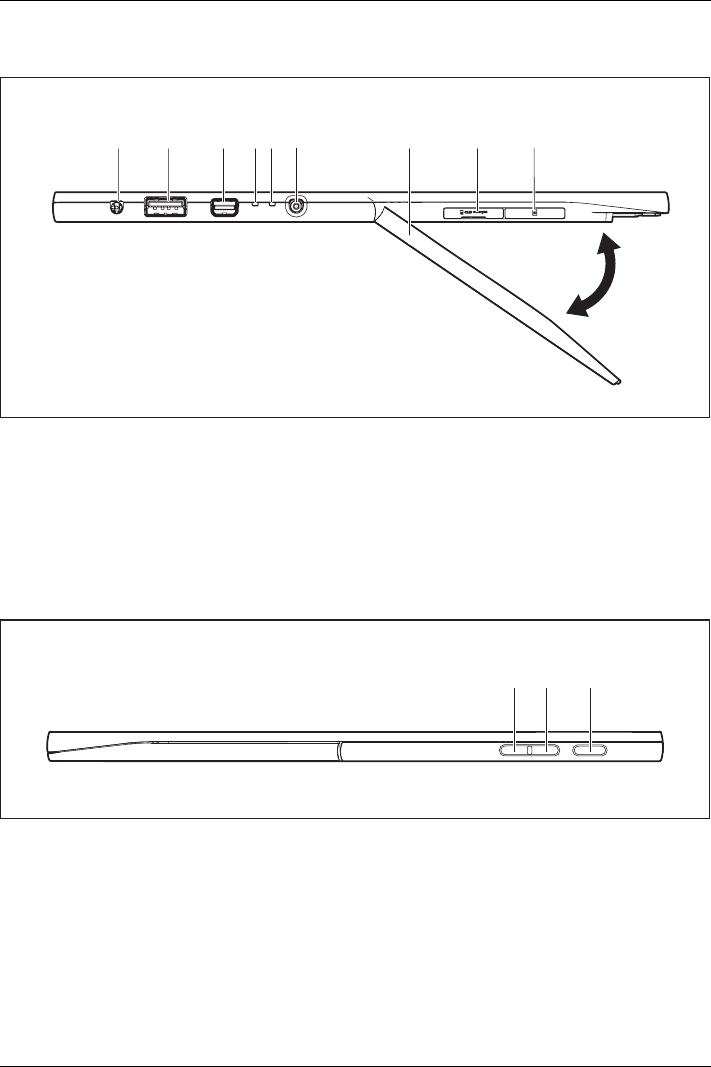
Ports and controls
Left side
1 2 3 87
6
90°
45
1 = Combined headphones and
microphone port
2 = USB port 3.0 with charging function
(Anytime USB charge)
3 = Mini Display Port
4 = Power-on indicator
5 = Battery charging indicator
6 = DC input connector (DC IN)
7 = Tablet stand
8 = Memory card slot (under tablet stand,
Right side
1 32
1 = Volume Down Button
2 = Volume Up Button
3 = ON/OFF button
Fujitsu 11
9
protected by additional cover)
9 = SIM card slot (under tablet stand,
protected by additional cover)
Note) Even though existing SIM slot, this
product doesn't support Wireless-WAN
function in U.S.A and Canada.
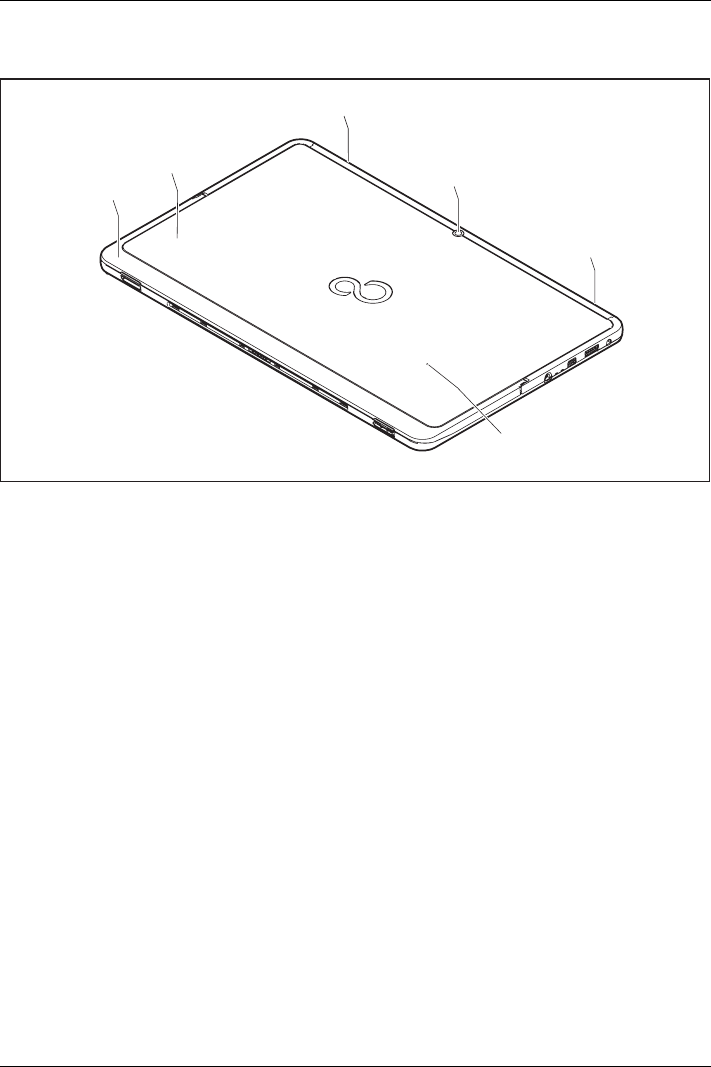
Ports and controls
Rear
4
2
1
3
3
5
1 = Tablet stand
2 = NFC (Near Field Communication,
depending on configuration)
3 = Speaker
4 = Camera
5 = Access to reset button
12 Fujitsu

Important notes
Important notes
ImportantnotesNotes
This chapter contains essential safety information which must be followed when working
with your Tablet PC. The other notes provide useful information about your Tablet PC.
Safety instructions
SafetyinformationInform ation,
Please follow the safety notes provided in the "Safety/Regulations" manual
as well as the safety notes given below.
Please pay special attention to the sections in the manual marked
with the symbol on the left.
When connecting and disconnecting cables, observe the relevant
notes in this operating manual.
Read the information on the ambient conditions in the "Technical data", Page 80 chapter
and the information in the "First-time setup of your device", Page 18 chapter before
preparing your Tablet PC for use and switching it on for the first time.
When cleaning the device, please observe the relevant notes in the
section "Cleaning the Tablet PC", Page 16.
Pay attention to the additional safety notes for devices with wireless components
provided in the "Safety/Regulations" manual.
When handling this device, you come into contact with lead, a chemical which in
California is held to be a possible cause of birth defects and other damage to fertility.
Wash your hands after using the device.
This Tablet PC complies with the relevant safety regulations for data processing equipment. If
you have questions as to whether you can set up the Tablet PC in the intended environment,
please contact your sales outlet or our hotline/service desk.
Fujitsu 13
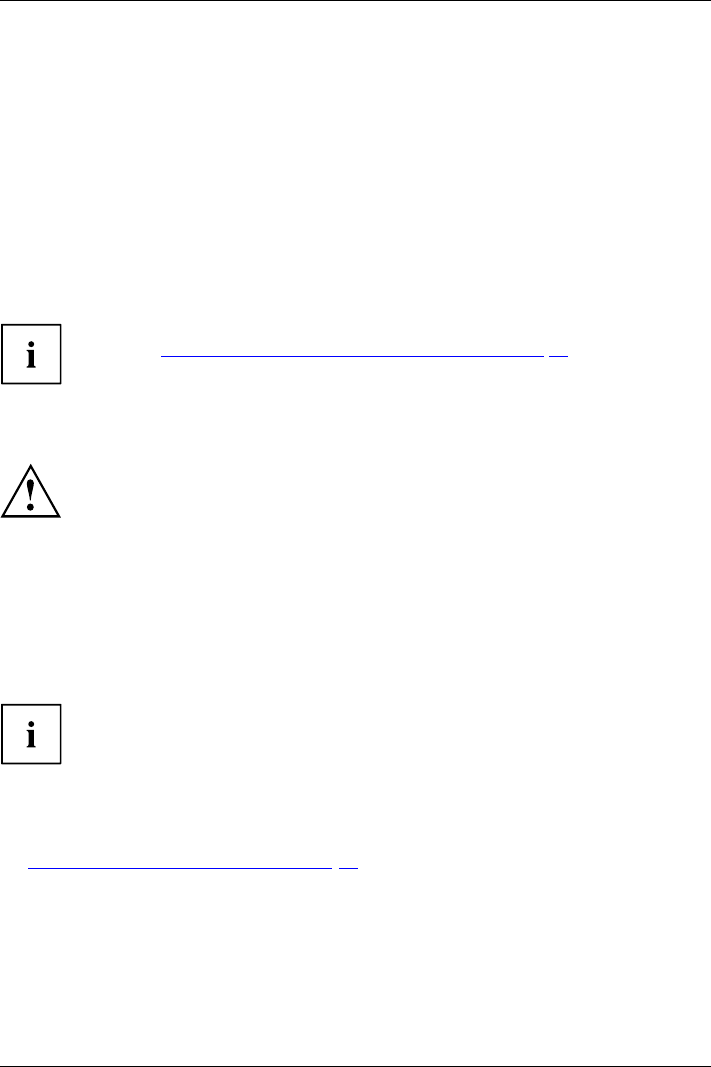
Important notes
Additional safety notes for devices with
wireless components
Wirelesscom ponentsWirelessLANBluetooth,Safetynotes
If a wireless component (Wireless LAN, Bluetooth) is integrated in your Tablet PC, you must be
sure to observe the following safety precautions when using your Tablet PC:
• Switch off the wireless components when you are in an aircraft or driving in a car.
• Switch off the wireless components when you are in a hospital, an operating
room or near a medical electronics system. The transmitted radio waves
can impair the operation of medical devices.
• Switch off the wireless components, when you let the device get near flammable
gases or into hazardous environments (e.g. gas station, paint stores), as the
transmitted radio waves can cause an explosion or a fire.
For further information on how to switch the wireless components on and off, refer
to section "Switching the wireless components on and off", Page 40.
Protecting the display screen
Do not pour liquids on the system or wash it with a heavily soaked cloth. Do not place
items on the top of the monitor in order to prevent it from being damaged.
During normal use of the device, small particles from the environment
can become embedded in the stylus tip and scratch the screen. The
warranty does not cover a scratched screen.
Energy saving
NotesEnergyPowersaving
If you will not be using your Tablet PC, switch it off. Switch off any connected external devices when
they are not in use. If you use the energy-saving functions, the Tablet PC uses less power. If you do
this, you will be able to work longer with the Tablet PC before having to recharge the battery.
The energy efficiency is increased and environmental pollution is reduced.
You save money and help protect the environment.
Energy saving under Windows
►Make use of the available energy-saving functions as described in chapter
"Using the energy saving functions", Page 38.
14 Fujitsu
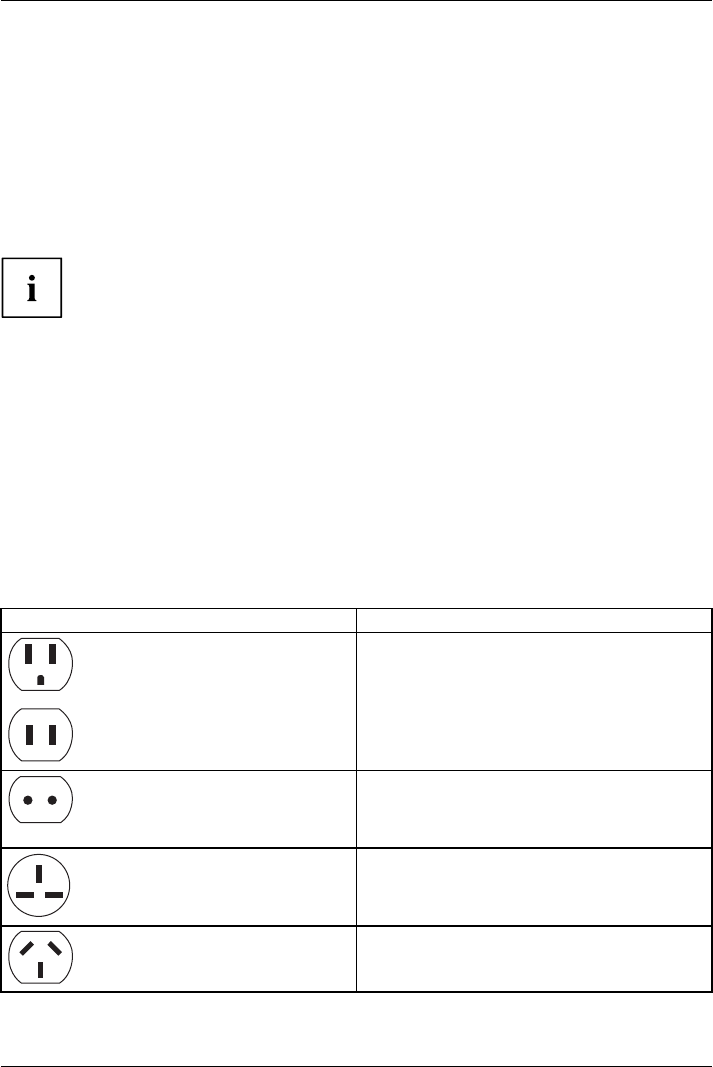
Important notes
Traveling with your Tablet PC
MobileoperationNotesTranspor tationTabletPC
Please follow the instructions below when traveling with your Tablet PC.
Before you travel
►Back up important data stored on your hard disk.
beforeyou travelTravel
►Switch off the wireless component for data security reasons. With data trafficviaawireless
connection, it is also possible for unauthorized third parties to receive data.
Information on activating data encryption is provided in the documentation
for your wireless component.
►If you want to use your Tablet PC during a flight, ask the flight attendants to seeit is safe to use it.
When traveling in other countries
►If you are traveling abroad, check that the AC adapter can be operated with the
local AC voltage. If this is not the case, obtain the appropriate AC adapter for
your Tablet PC. Do not use any other voltage converter!
►Check whether the local AC voltage and the AC cable are compatible. If this is not
the case, buy an AC cable that suits the local conditions.
►Enquire with the appropriate government office of the country you will be traveling in as to
whether you may there operate the wireless component integrated in your Tablet PC.
►Take the necessary travel adapters with you when traveling abroad. Check in the following
table for which travel adapters you will need, or ask your travel organizer.
Power connection Travel destination
United States, Canada, Mexico, parts of Latin
America, Japan, Korea, Philippines, Taiwan
Russia and the Commonwealth of Independent
States (CIS), much of Europe, parts of Latin
America, the Middle East, parts of Africa, Hong
Kong, India, much of south-east Asia
United Kingdom, Ireland, Malaya, Singapore,
parts of Africa
China, Australia, New Zealand
Fujitsu 15

Important notes
Transporting the Tablet PC
Protect the Tablet PC from severe shocks and extreme temperatures
(e.g. direct sunlight in a car).
• Do not transport your Tablet PC while it is turned on.
• Carry your Tablet PC with you while traveling. Do not check it in as baggage.
• Never put your Tablet PC through a metal detector. Have it hand-inspected by
security personnel. You can however put your Tablet PC through a properly
tuned X-ray machine. To avoid problems, place it close to the entrance of
the machine and remove it as soon as possible or have it hand-inspected by
security personnel. Security officials may require you to turn your Tablet PC
on. So make sure you have a charged battery on hand for this.
►Switch the Tablet PC off.
►Unplug the AC plug of the AC adapter and all external devices from the power outlets.
►Disconnect the AC adapter cable and the data cables for all external devices.
►To protect against damaging jolts and bumps, use a suitable Tablet PC
carrying case to transport your Tablet PC.
Cleaning the Tablet PC
• Use of incorrect cleaners can result in optical impairment of the LCD and / or
damage to the computer. Always refer to the cleaner manufacturer’s guidelines and
material safety data sheets for proper handling and use of the products.
• Never use ammonia, acidic, or alkaline cleaners or organic chemicals
such as paint thinner, acetone or kerosene. It may damage surface
finishes and the coating of the LCD screen.
• Never use compressed air for cleaning your computer.
• If your Tablet PC has a Smart Card slot, be very careful to avoid any
liquid entering the slot as this can damage the unit.
Further information on cleaning the Tablet PC
The Tablet PC does not float.
If the Tablet PC is exposed to water or other liquids with its connections open, liquid
can penetrate the Tablet PC and cause a malfunction. Do not continue to use the
Tablet PC. Switch it off and contact our hotline / our service desk (see enclosed list of
service desks or visit our website at: "http://www.fujitsu.com/us/support/").
16 Fujitsu

Important notes
Cleaning with disinfectant wipes
There are many ways of disinfecting surfaces. The following disinfectant wipes
have been tested successfully with the Tablet PC:
• MG Chemicals Multipurpose Alcohol Wipes (alcohol-based)
• PROSAT® Sterile™ PS-911EB/EtOH Life Sciences Wipes (alcohol-based)
• Clorox® Healthcare Bleach Germicidal Wipes (without alcohol)
Remember, if your Tablet PC is configured with the Smart Card shell, it does not
have a cover to close the port and liquid could enter and damage the device. Take
extra precautions when cleaning around the Smart Card reader.
For proper use of disinfectant wipes, please read the manufacturer’s instructions.
Before cleaning, please test the disinfectant wipe on a small area of the Tablet
PC. Some medical disinfectant wipes may leave residue on the Tablet PC which
is difficult to remove again, or they may dry out quickly. Therefore dispose of
the wipes after one single use and do not reuse them.
Fujitsu 17
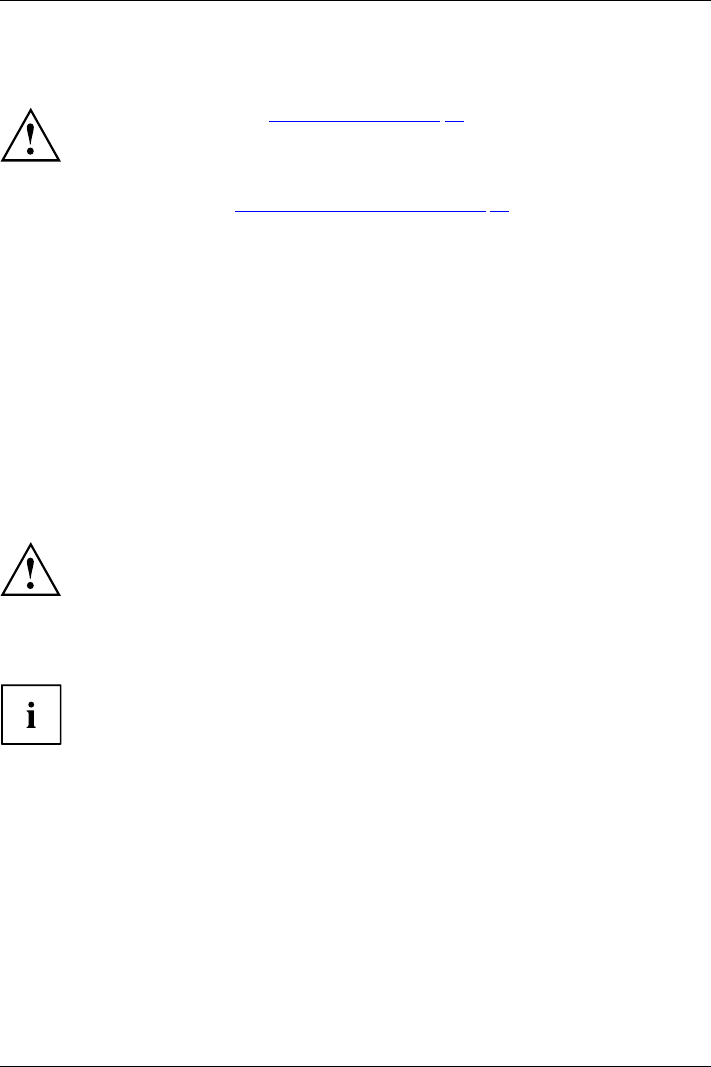
First-time setup of your device
First-time setup of your device
First- timese tupGettingstarted
Please read the chapter "Important notes", Page 13.
If your device is equipped with a Windows operating system, the necessary
hardware drivers and supplied software are already pre-installed.
Beforeswitchingitonforthefirst time, connect the device to the AC voltage using
the AC adapter, see "Connecting the AC adapter", Page 21. The AC adapter must
remain connected during the whole of the installation process.
A system test is performed when your device is first switched on. Various messages
can appear. The display may remain dark for a short time or may flicker.
Please follow the instructions on the screen.
NEVER switch off your device during the first-time setup process.
The battery must be charged if you want to operate your device using the battery.
When used on the move, the built-in battery provides the device with the necessary power. You
can increase the operating time by using the available energy-saving functions.
For instructions on how to connect external devices (e.g. mouse, printer) to your Tablet
PC, please refer to the operating manual for your device.
Unpacking and checking the device
If you find that damage has occurred during transport, please notify
your local sales outlet immediately!
►Unpack all the individual parts.
PackagingTransport
►Check your device for any visible damage which may have occurred during transportation.
You may need to reuse the packaging in the future, for example if
you need to ship your device.
18 Fujitsu

First-time setup of your device
Choosealocation
Choosealoc ationSetupAC adapter
Choose a suitable location for the device before setting it up. In doing
so, please follow these instructions:
• Never place the device or the AC adapter on a heat-sensitive surface.
The surface could be damaged as a result.
• Never place the device on a soft surface (e.g. carpeting, upholstered furniture,
bed). This can result in damage caused by overheating.
• The back of the device heats up during normal operation. Prolonged contact
with skin can become unpleasant or even result in burns.
• Place the device on a stable, flat, non-slippery surface. Please note that the
rubber feet of the device may mark certain types of delicate surfaces.
• Keep other objects at least 100 mm / 4 inches away from the device
and its AC adapter to ensure adequate ventilation.
• Do not expose the device to extreme environmental conditions. Protect
the device against dust, humidity and heat.
Fujitsu 19
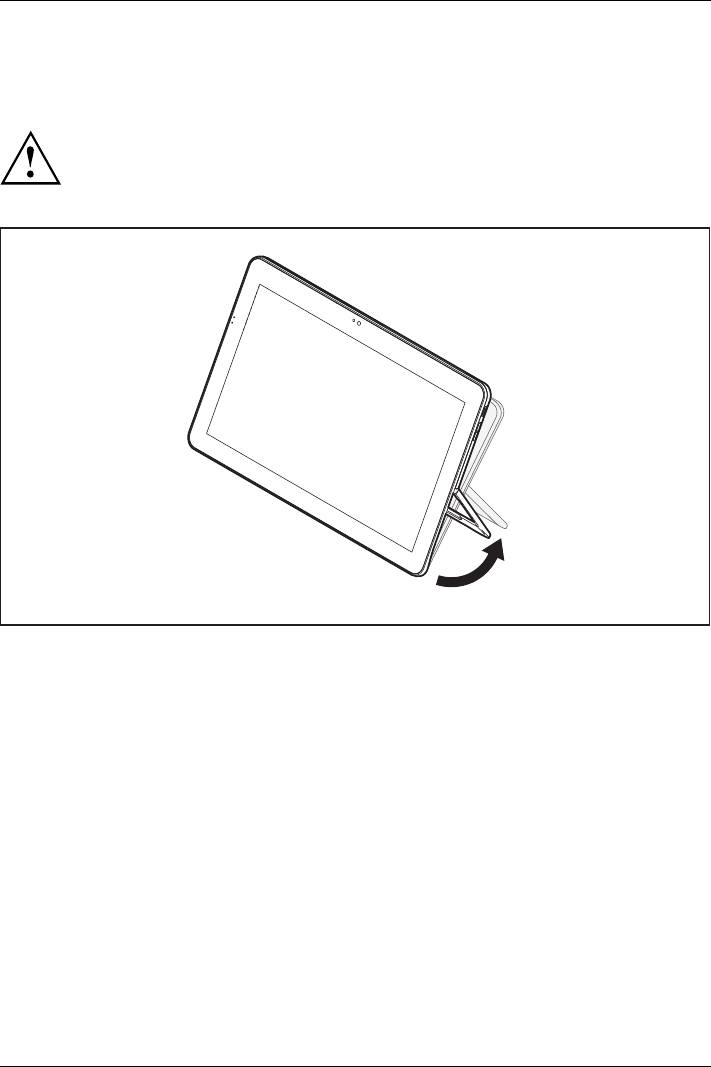
First-time setup of your device
Setting up the device
You can operate the device in an upright position on an even surface using the built-in tablet stand.
Make sure that the device is standing safe and securely and be careful that it does not
tip over. Otherwise the device may be damaged, particularly the touch screen.
Open the tablet stand to a maximum angle of 90 degrees. Otherwise
the joint of the tablet stand will be damaged.
90° max.
►Open the tablet stand in the direction of the arrow to the desired opening angle.
►Set the device in its place.
20 Fujitsu
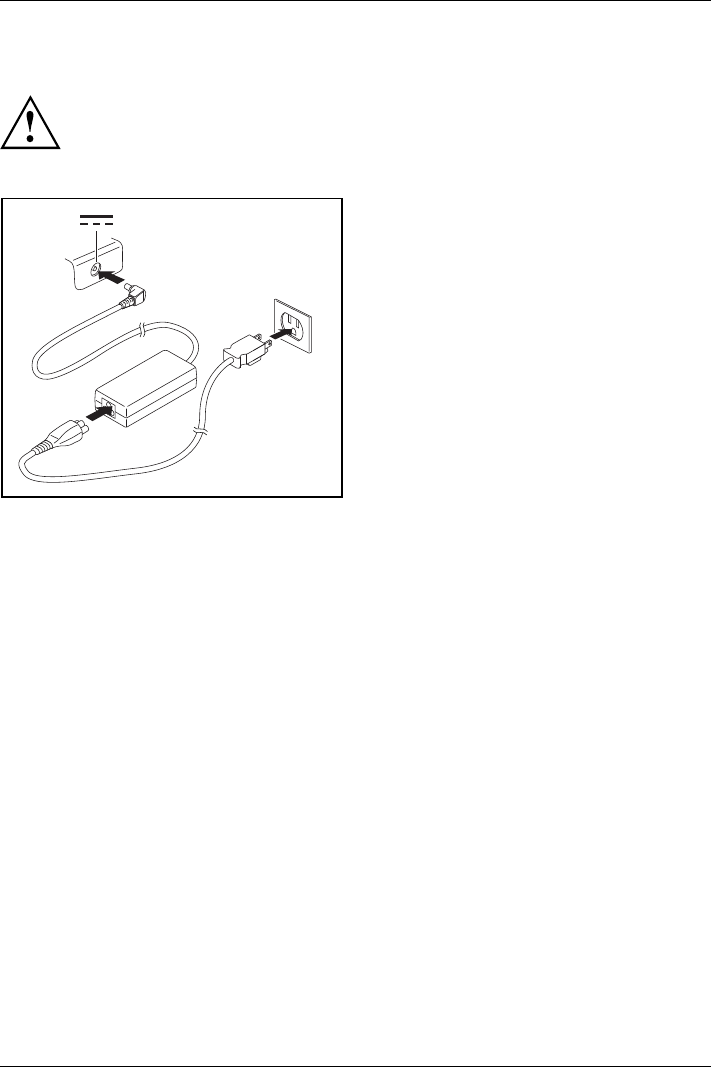
First-time setup of your device
Connecting the AC adapter
MakingreadytouseACadapter
Observe the safety notes in the enclosed "Safety/Regulations" manual.
The supplied AC cable conforms to the requirements of the country in which
you purchased your device. Make sure that the AC cable is approved for
use in the country in which you intend to use it.
3
1
2
►Connect the AC cable (1) to the AC adapter.
►Plug the AC cable (2) into a power outlet.
►Connect the AC adapter cable (3) to the
DC jack (DC IN) of the device.
Fujitsu 21

First-time setup of your device
Switching on the device for the first time
Switchingonforthefirstt ime
To make it easier to use your device for the first time, the operating system
is pre-installed on the hard disk.
1
2
►Press the ON/OFF button (1) for about one second to switch the device on.
The power-on indicator (2) lights up whenever the system is switched on.
►During the installation process, follow the on-screen instructions.
You can find information and help on the Windows operating system
functions online at "http://windows.microsoft.com".
22 Fujitsu

First-time setup of your device
Installing Bonus Apps
BonusApps
After you have started your system the first time, you will see a Bonus Apps icon on your desktop.
►Click on the icon to see which additional applications are available for you to install.
Applications that are already installed appear in grey, those that are
available for installation appear in blue.
►Select the applications you wish to install by selecting the checkbox adjacent to your selection.
or
►Click Select All if you would like to install all available applications.
►To confirm your selection, click Install.
Note that in some cases (depending upon which application was selected for
installation) after installation completes, the system will prompt you to reboot.
There are also cases in which if multiple applications are selected to install
but one of them needs a reboot, the system will reboot and continue
installing the rest of the selected applications.
Fujitsu 23
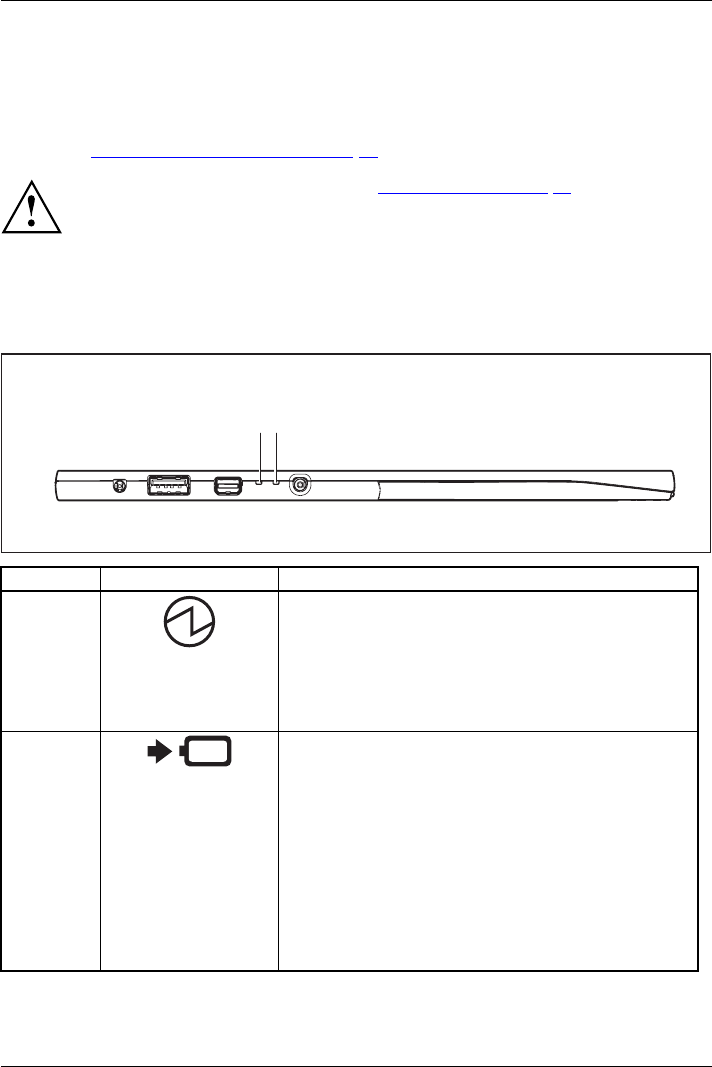
Working with the Tablet PC
Working with the Tablet PC
Tablet,operationTablet
This chapter describes the basics for operating your Tablet PC. You can find instructions
on how to connect external devices (e.g. mouse, flash storage) to the Tablet PC in
the chapter "Connecting external devices", Page 62.
Please refer to the notes in the chapter "Important notes", Page 13.
Status indicators
StatusindicatorsSymbols
The status indicators (1, 2) provide information about the status of the power
supply and of the rechargeable battery.
12
No. Status indicator Description
1Power-on indicator
• The indicator lights up white: The tablet PC is
switched on.
• The indicator flashes: The Tablet PC is in sleep mode
(Save-to-RAM).
• The indicator is not lit: The Tablet PC is switched off
or in Save-to-Disk mode.
2Battery charging indicator
Please note: If the mains adapter is connected when the
state of charge of the battery is more than 90%, charging
will not be started. When the state of charge of the battery
is less than 90%, the battery will be charged to 100% as
soon as the mains adapter is connected.
• The indicator is lit orange: The battery is being
charged.
• The indicator flashes orange: An error has occurred.
• The indicator is not lit:The battery is not being
charged (the battery is already more than 90%
charged or the mains adapter is not connected.)
24 Fujitsu
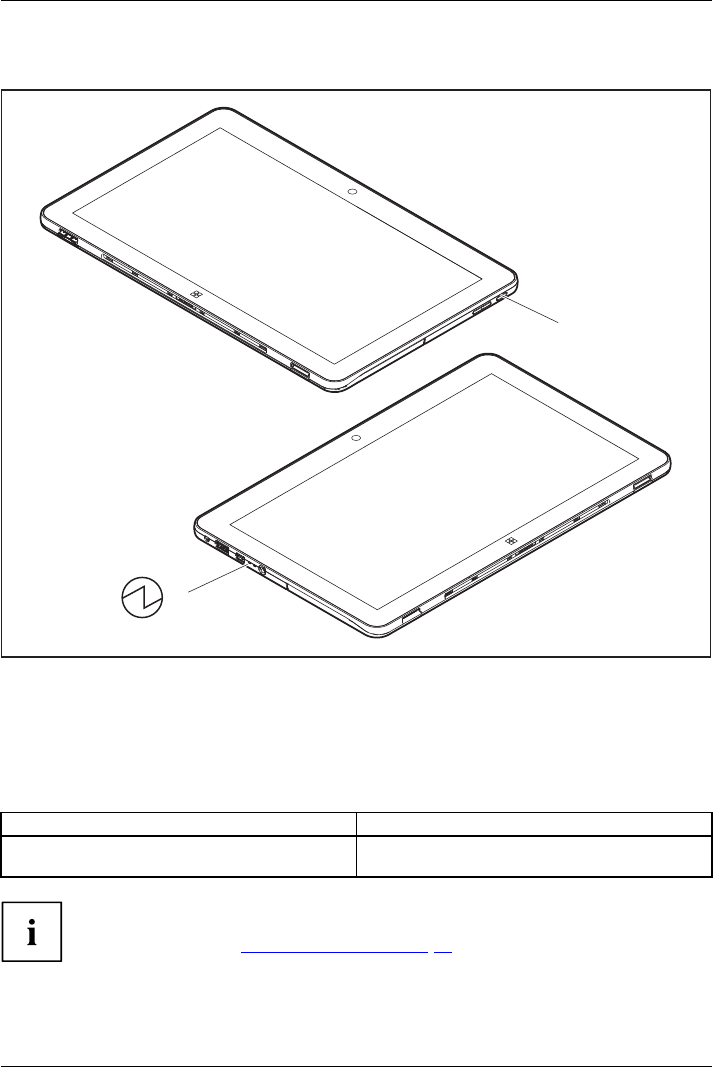
Working with the Tablet PC
Switching the Tablet PC on
Tablet:SwitchingonPower-onPower-onindicatorSuspend/Resume button
1
2
►Press the ON/OFF button (1) for about one second to switch the device on.
The power-on indicator (2) lights up whenever the system is switched on.
Programming the ON/OFF button
You can program the ON/OFF button:
Operating system Menu
Windows 10 Control Panel - Hardware and Sound - Energy
Options
If you have assigned a password, you must enter this when requested to
do so, in order to start the operating system. Detailed information can be
found in the chapter "Security functions", Page 57.
Fujitsu 25

Working with the Tablet PC
Switching the Tablet PC off
Back up your data and close all applications before you switch off your
device. Otherwise data might be lost.
►Shut down the operating system correctly.
Switchingoffthe
►If the Tablet PC does not switch itself off automatically, press the ON/OFF
button for approx. five seconds.
Handwriting recognition
For detailed information on handwriting recognition, see the documentation for your operating system.
At present, handwriting recognition under Windows supports the following languages:
English, German, French, Italian, Japanese, Korean, Chinese (traditional and simplified), Dutch,
Portuguese, Spanish, Brazilian, Norwegian (Bokmål and Nynorsk), Swedish, Finnish, Danish,
Polish, Rumanian, Serbian (Cyrillic and Latin script), Catalan, Russian, Czech and Croatian.
Under Windows you can set the required language under Control Panel –
Time, Language and Region – Language.
26 Fujitsu

Working with the Tablet PC
Touchscreen
Tou ch s c re e nNotes
Information on screen resolution can be found in the section "Screen resolutions
for integrated screen and external screens", Page 83.
Background lighting
LCD screens are operated with background lighting. The luminosity of the background
lighting can decrease over the period of use of the Tablet PC. However, you
can set the brightness of your screen yourself.
Ambient light sensor
If your Tablet PC was shipped with the Windows operating system, the screen brightness is
regulated by means of the ambient light sensor and depending on the respective light conditions.
This results in optimum readability and longer battery life at the same time.
If your Tablet PC was shipped with Windows 10, the adaptive brightness setting is deactivated. To
change the ambient light sensor settings, select Control Panel - System and Security - Power Options -
Change plan settings - Change advanced power settings - Display - Activate adaptive brightness setting..
Select On to activate the adaptive brightness setting with the help of the ambient light sensor.
Synchronizing the display on the touchscreen and an external monitor
In Windows 10 you can proceed as follows to set the output type:
►Wipe your finger over the screen starting from the right-hand edge.
►Select All Settings.
►Look for the keyword "project".
►Select the required function.
Fujitsu 27
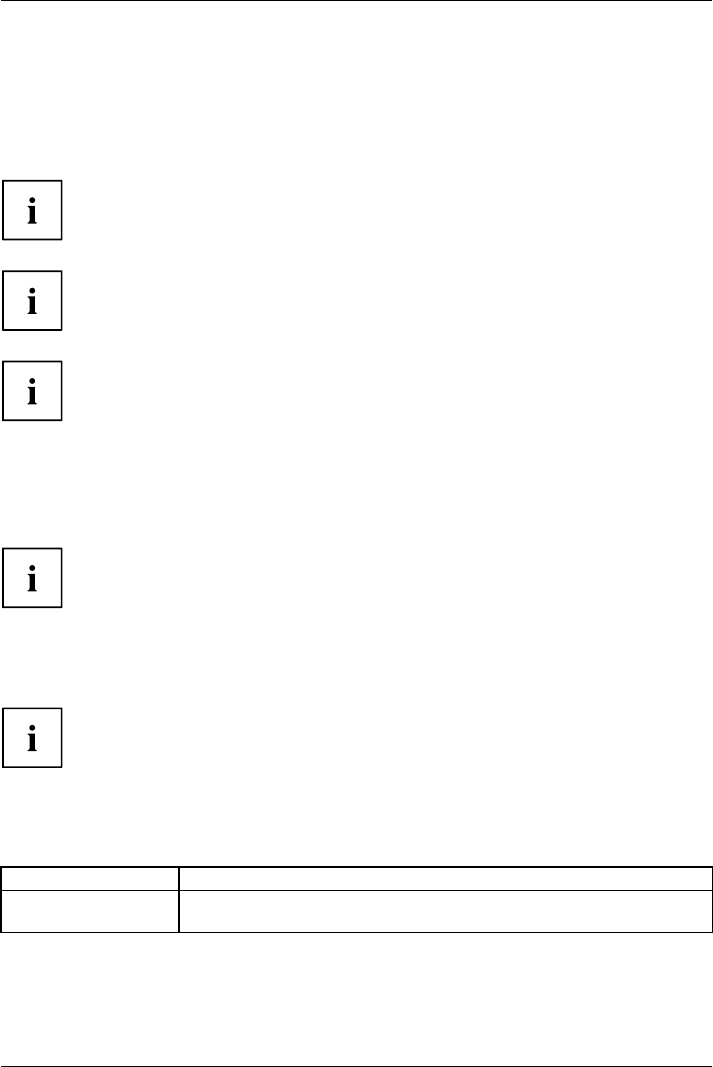
Working with the Tablet PC
Select display orientation (portrait or
landscape format)
Landscapeform atPortraitformatDisplayorientation
You can choose to use either portrait or landscape orientation for the display, or whether the
display orientation should automatically adapt to the orientation of the Tablet PC.
The automatic adaptation of the display orientation is disabled while
a magnetic keyboard is attached.
You can change these settings under Control Panel - Hardware and Sound
- Windows Mobility Center / Rotate screen.
In the settings thereareprofiles saved for operation with different screen orientations.
These profiles have preset standard configurations that can be modified as desired.
These settings do not just affect the screen settings on the Tablet PC, but
also on external monitors that are connected.
Using fingers
You can execute certain commands by using your finger tip on the touchscreen of your device.
Alternatively, everything which you can select or activate using your finger
tip can also be selected or activated using the stylus.
Calibrate the Dual Digitizer for finger-based
operation of the device.
Before the first finger-based operation, you must calibrate your Tablet PC via the
operating system, so that it recognizes your fingertips as accurately as possible.
As soon as you notice that the accuracy is becoming worse, you
must recalibrate the device.
Please note: There are separate calibration programs available for calibrating
the stylus and for calibrating finger-based operation. Do not use the calibration
tool for the stylus to calibrate finger-based operation.
Operating system Menu
Windows 10 To calibrate, run the Hardware and Sound / Tablet PC Settings function in the
Control Panel. You need to calibrate both portrait and landscape formats.
28 Fujitsu
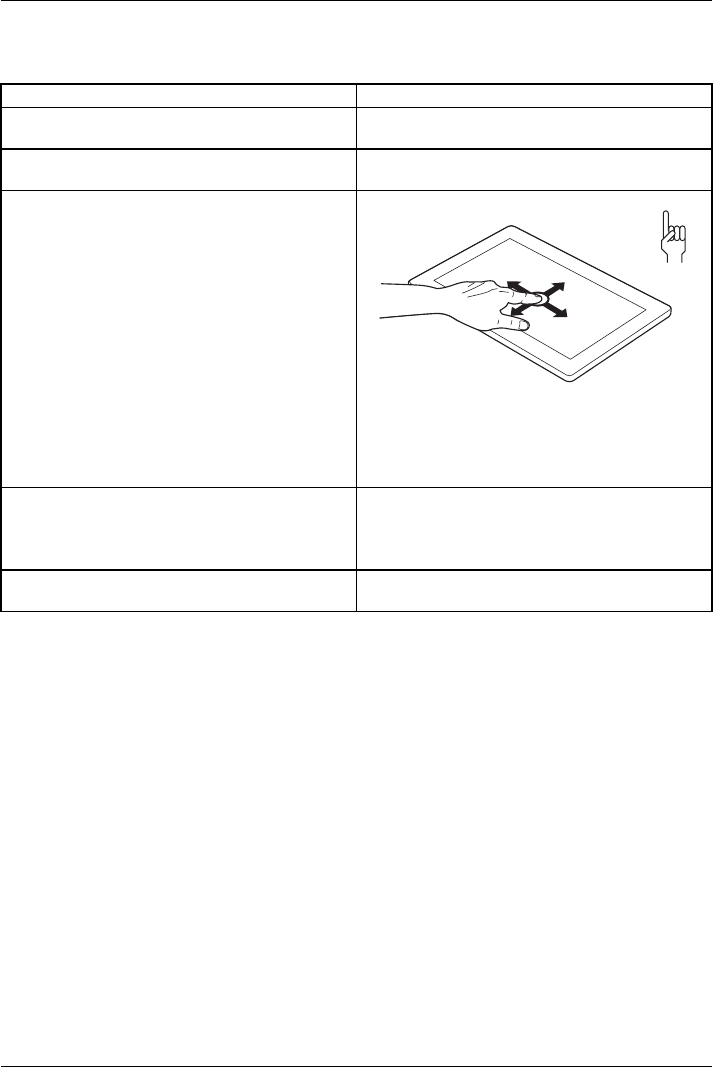
Working with the Tablet PC
Actions with one finger
Action Description
Selecting objects (click with the left mouse
button)
►Tap once briefly with the finger on the object.
Starting programs (double-click with the left
mouse button)
►Use one finger to tap twice in quick
succession on the program symbol.
Moving objects/windows (while holding the left
mouse button pressed, drag & drop)
►Place your finger on the object/window,
keep your fingertip pressed against
the touchscreen and move the desired
object/window.
Opening a context menu (click with the right
mouse button)
►Tap your finger on the desired item.
Keep your fingertip pressed against the
touchscreen.
The context menu appears.
Moving the cursor ►Position one finger on the touchscreen and
move your fingers in the desired direction.
Fujitsu 29
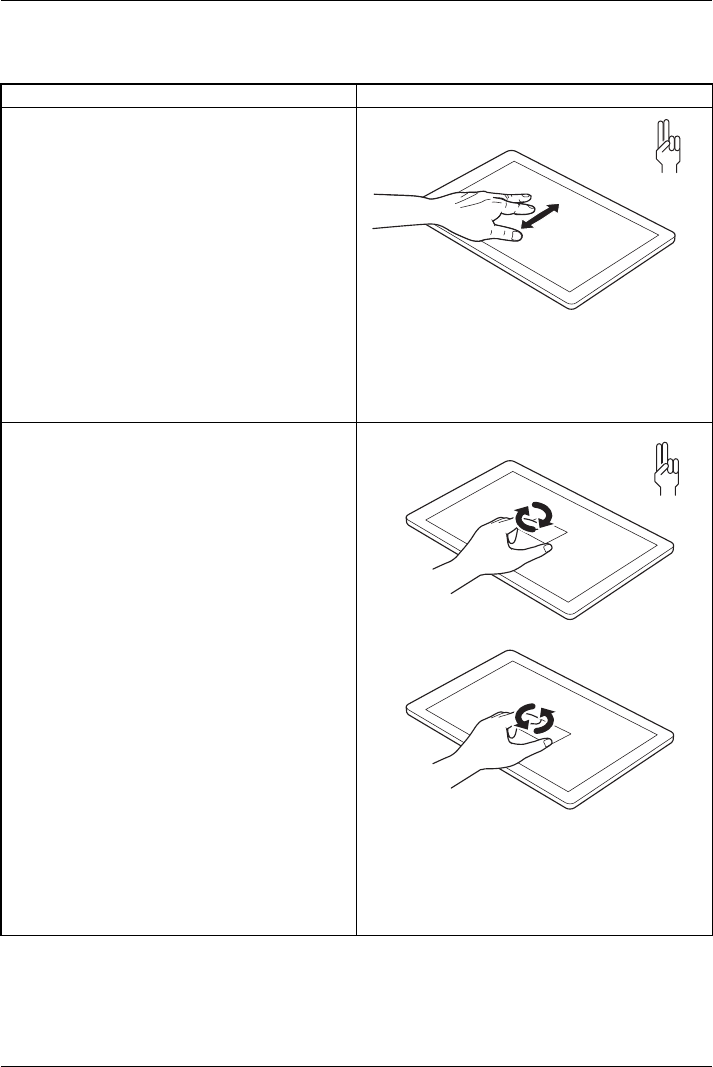
Working with the Tablet PC
Actions with two fingers
Action Description
Scrolling
►Place two fingers on the touchscreen.
►Move the fingers up to scroll up.
or
►Move the fingers down to scroll down.
Rotating
►Position your thumb on the touchscreen and
rotate the image clockwise or anticlockwise
using your index finger.
30 Fujitsu
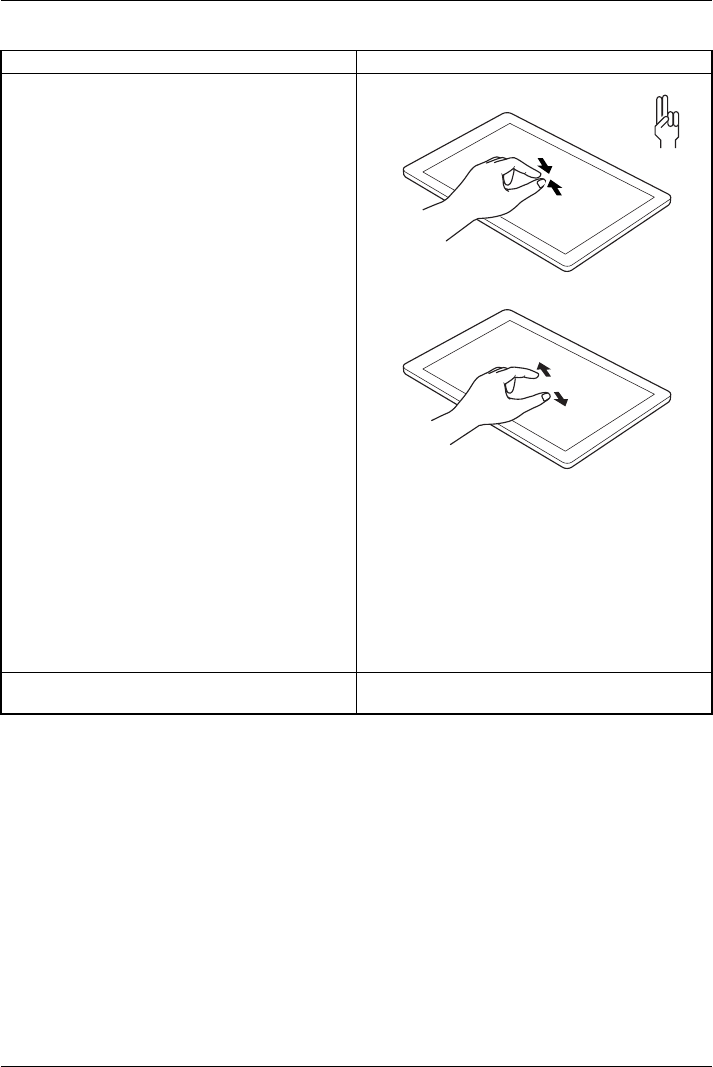
Working with the Tablet PC
Action Description
Increase or decrease zoom
►Put two fingers on the touchscreen and
move them apart to increase the size of the
zoom.
or
►Put two fingers on the touchscreen and
move them together to decrease the size
of the zoom/view.
Lock context-sensitive menus ►Use two fingers to tap twice in quick
succession on the touchscreen.
Fujitsu 31

Working with the Tablet PC
Using the stylus (optional, configuration dependent)
Pen
1
23
1 = stylus tip
2 = stylus button (eraser)
3 = stylus button (right mouse button, stylus
wake-up)
You can use the stylus on your Tablet PC as an electronic writing tool, to select menu items and to
navigate through the programs. Programs that support handwriting recognition also allow you to
write directly on the screen with the stylus. You can also use the stylus as a drawing tool.
Use only the stylus that was provided with your Tablet PC. Do not use any other pointed
object as a substitute, that was not specially designed for your Tablet PC. Replace
the stylus tip if it is worn. The warranty does not cover a scratched screen.
While writing, take care that you do not scratch the surface of the
display (e.g. with a wristwatch or bracelet).
The stylus of the Tablet PC is an electronic instrument that can be damaged
if used improperly. Handle the stylus with care.
Our recommendations for proper handling of the stylus are as follows:
• Do not gesture with the stylus.
• Do not use the stylus as a pointer.
• Do not use the stylus on surfaces other than the screen of the Tablet PC.
• Do not try to turn the grip of the stylus. The grip is used to put the
stylus into its slot or to take it out of its slot.
• Never store the stylus with its weight on the tip (e.g. with the tip down in a stylus
container). If the stylus is stored with the tip pointing down, this may have an
adverse effect on the stylus mechanism (particularly in high temperatures). In this
case, the stylus tip may react as though it is constantly being pressed down. To
avoid damage, the stylus should be stored in the slot when not in use.
The stylus can be influenced by electromagnetic fields (cursor quivers or
jumps). There may be a few areas on the screen where the cursor quivers
slightly in spite of pressing the stylus down firmly.
The screen responds to entries made with the tip of the finger or the stylus when the
tip of the finger or the stylus directly touches the screen.
You can use the stylus to perform almost all functions for which you would otherwise use a mouse.
32 Fujitsu

Working with the Tablet PC
Action Mouse Stylus
Selecting menu
items Click with the left mouse button.Tap on the menu entry with the tip of
the stylus.
Starting programs Double-click with the left mouse
button. Tap on the program symbol twice in
rapid succession using the stylus tip.
Moving an object
or window Drag with the left mouse button
pressed. Place the stylus tip directly on the
object or window. Keep the stylus tip
held against the screen. Drag the
desired object or window.
Opening a context
menu Click with the right mouse button. Tap on the desired element with the
stylus and keep the stylus pressed
against the screen.
Moving the cursor Move the mouse Place the tip of the stylus directly on
the screen.
Energy saving functions of the stylus
In order to save energy, the stylus automatically enters suspend mode after 5 minutes
of inactivity (lower energy consumption than in active mode), and sleep mode after 10
minutes (lower energy consumption than in suspend mode).
You can set the stylus to active mode again using the lower button on the stylus.
Adjusting the stylus
Operating system Menu
Windows 10 Under System Control - Hardware and Sound - Pen and Touch you can make
various settings for the stylus.
Calibrating the stylus
Before first use with the stylus, you must calibrate your Tablet PC via the operating
system, so that it recognizes the stylus as accurately as possible.
You should also always repeat the calibration if the co-ordination between the
stylus and the cursor movement deteriorates.
Operating system Menu
Windows 10 To calibrate, run the Hardware and Sound / Tablet PC Settings function in the
Control Panel. You need to calibrate both portrait and landscape formats.
Fujitsu 33
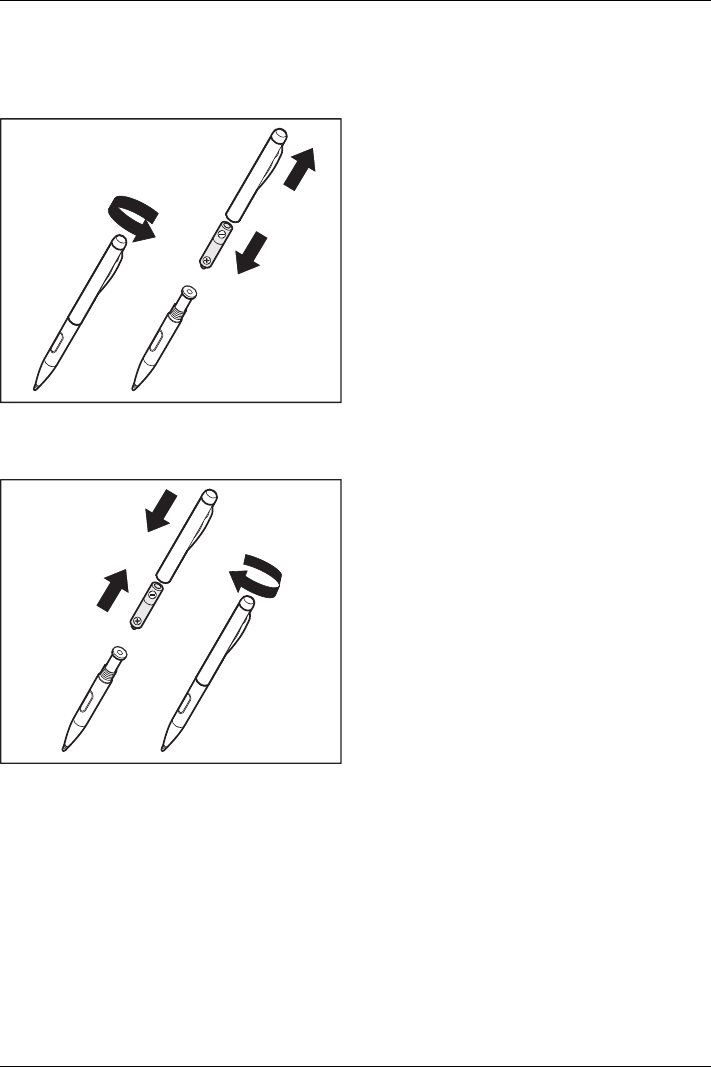
Working with the Tablet PC
Removing the stylus battery
The stylus contains one AAAA battery.
1
2
3
1
►Turn the cap of the stylus in the direction of
the arrow (1) and lift it off the stylus (2).
►Remove the battery from the stylus cap (3).
Installing the stylus battery
1
2
13
►Insert the new battery into the stylus cap (1).
►Place the stylus cap on the stylus (2) and
screw it down in the direction of the arrow (3).
34 Fujitsu
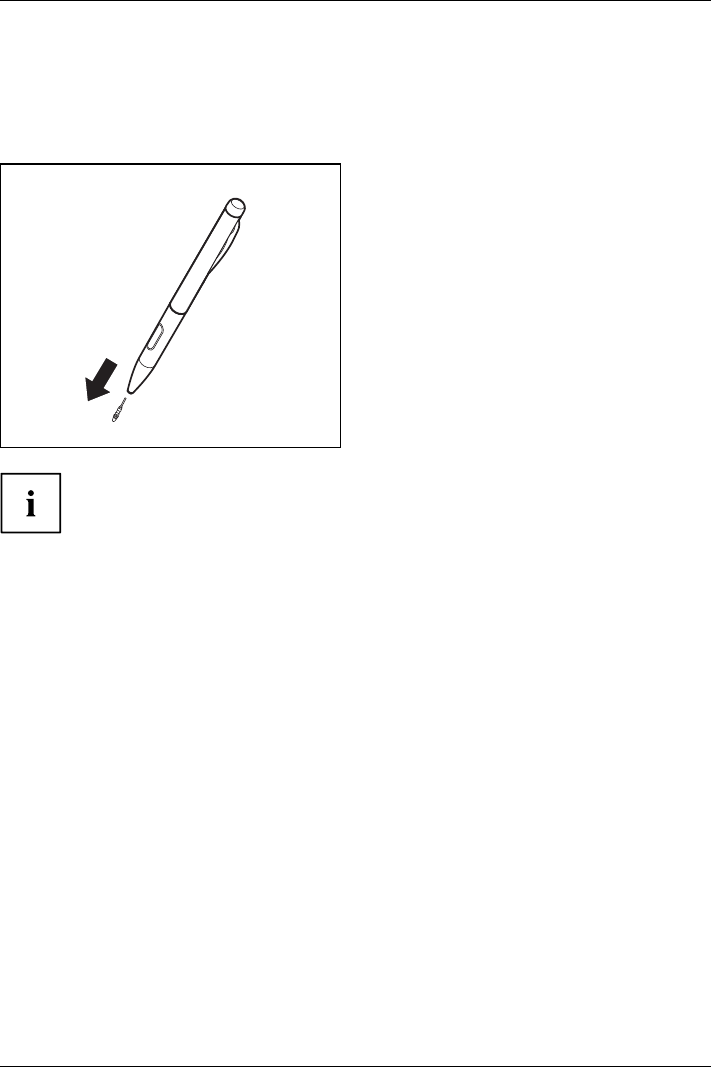
Working with the Tablet PC
Changing the pen tip
With use, the pen tip may become worn or may pick up foreign particles that can scratch the screen.
A damaged or worn tip may not move freely, causing unpredictable results when using the pen.
If these problems appear with your pen, you should change the pen tip.
►Pull the pen tip from the pen.
►Replace the pen tip with one of the
replacement tips that were supplied
your pen. Insert the pointed end of the
pen tip into the barrel and push it in
gently until it is in place.
Do not continue to use a tip which is worn or damaged.
Fujitsu 35
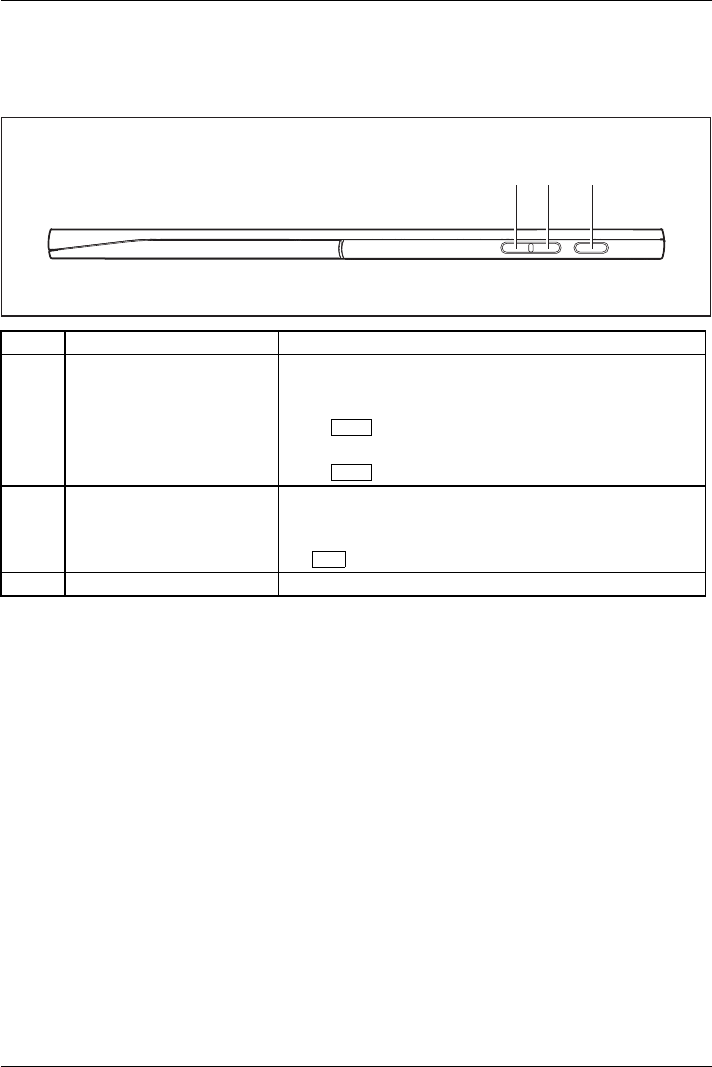
Working with the Tablet PC
Volume rocker
In addition to the ON/OFF button (3), your Tablet PC is also equipped with a volume rocker (1, 2).
1 32
No. Description Functions
1 Volume down button Decrease the volume.
Keeping the volume down button pressed after turning on
the Tablet PC, the Boot Menu is started (this corresponds
to the F12 key on a keyboard).
During PXE boot thevolumedownbuttonalsocorresponds
to the F12 key on a keyboard.
2 Volume up button Increase the volume.
Keeping the volume up button pressed after turning on the
Tablet PC, the BIOS Setup is started (this corresponds to
the F2 keyonakey
board).
3ON/OFF button Switch the device on or off
36 Fujitsu

Working with the Tablet PC
Camera
Camera
Your device has two cameras: one on the front of the device and one on the rear.
The camera has its own status indicator. The indicator lights up when the camera is active.
Depending on the software used, you can use your camera to take pictures,
record video clips or take part in web chats.
• The picture quality depends on the lighting conditions and the software being used.
• You can only use the camera with a particular application (e.g. an Internet telephony
program or a video conferencing program which supports cameras).
• The support of the Tablet PC must not shake while the camera is being used.
• The camera automatically adjusts itself to the current light level. For this reason,
the touch screen may flicker while the light level is adjusted.
Further information on the use of the camera and additional settings for it can
be found in the help function of the program using the camera.
Rechargeable battery
BatteryBatteryServicelife,batteryRechargeablebatteryBattery
The built-in battery provides the Tablet PC with the necessary power for use on the move.
You can increase the service life of the battery by caring for the battery properly. The
average battery service life is around 500 charge/discharge cycles.
You can extend the battery service life by taking advantage of the available energy-saving functions.
Charging and maintaining the battery
BatteryBattery
The Tablet PC battery can only be charged when the ambient temperature is
between 5°C / 41 °F and max. 35°C / 95°F.
You can charge the battery by connecting the Tablet PC to the AC adapter
(see "Connecting the AC adapter", Page 21).
If the AC adapter is connected when the state of charge of the battery is more than 90%,
charging will not be started. When the state of charge of the battery is less than 90%, the
battery will be charged to 100% as soon as the AC adapter is connected.
If the battery is running low you will hear a warning alarm. If you do not connect the AC adapter
within five minutes of hearing the warning alarm, your Tablet PC will switch off automatically.
Monitoring the battery state of charge
Battery
batterychargemeter
A battery symbol for monitoring the battery capacity is displayed in the system bar /
status indicator. The battery symbol shows you the battery charge.
Fujitsu 37

Working with the Tablet PC
Using the energy saving functions
EnergyEnergyBattery
The Tablet PC uses less power when the energy saving features are enabled. You will then
be able to work longer when using the battery before having to recharge it.
The energy efficiency is increased and environmental pollution is reduced.
By choosing the best power options, you can make significant savings and
at the same time help protect the environment.
►Set the energy saving functions in your Control Panel.
The recommended settings for the Windows energy saving functions are predefined as "Fujitsu
Computer EcoSettings" in the Power Options of the Control Panel and can be displayed there.
When the Tablet PC is in a power-saving mode, you must remember the following:
During power-saving mode, open data is held in main memory or
in a swap file on the hard disk.
Never switch off the Tablet PC while it is in a power-saving mode. If the built-in battery
is nearly flat, close all open files and do not go into power-saving mode.
If you do not intend to use your Tablet PC for a long period of time:
►Exit the power-saving mode if necessary by touching the screen or by switching the Tablet
PC on.
►Close all opened programs and completely shut down the Tablet PC.
38 Fujitsu

Working with the Tablet PC
Memory cards
Slot
Your Tablet PC is equipped with an integrated storage card reader. Use storage
cards to enlarge the storage of your Tablet PC.
Follow the manufacturer’s instructions when handling the memory cards.
Memorycard
Supported formats
The following formats are supported:
• Micro Secure Digital (microSDTM Card)
•microSDHC
•microSDXC
Inserting the memory card
2
a
1
3
►Fold out the tablet stand (1).
►Open the slot cover (2).
►Carefully push the memory card into the slot (a) in the direction of the arrow (3) until you
feel the memory card engage. The label area must be facing downward. Do not apply
any force, otherwise the delicate contact surfaces could be damaged.
Memorycard
►Close the slot cover again.
Fujitsu 39
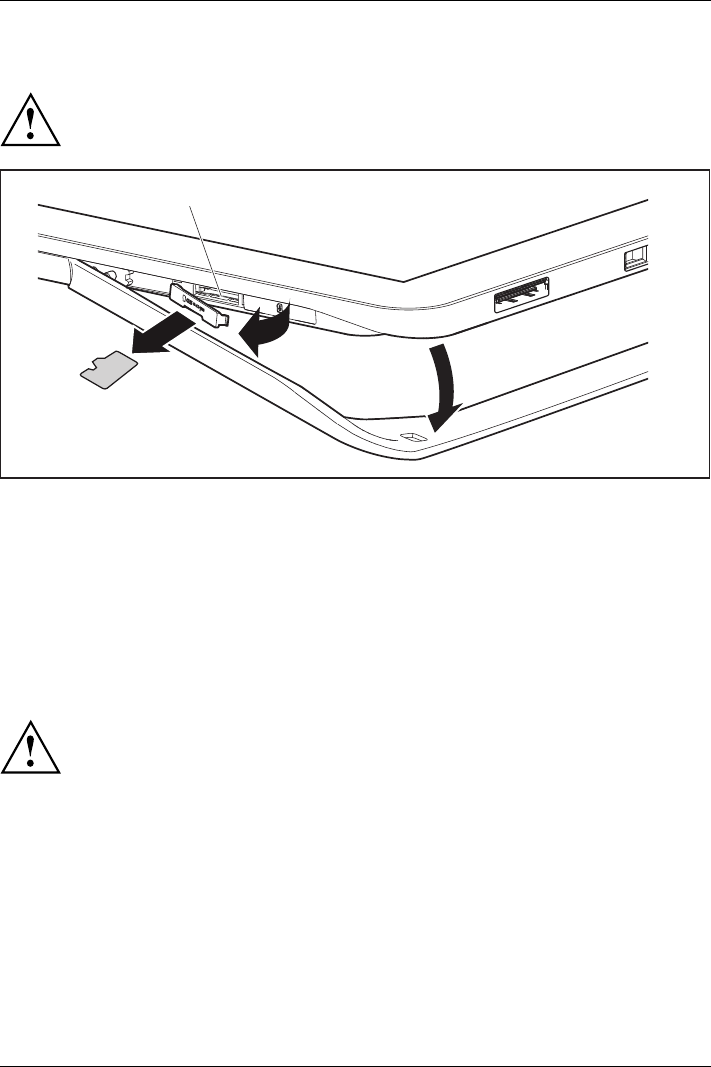
Working with the Tablet PC
Removing the memory card
Memorycard
To avoid any loss of data, always follow the correct procedure for removing the
card (see the documentation for your operating system).
2
a
3
1
►Fold out the tablet stand (1).
►Open the slot cover (2).
►Press the edge of the memory card so that the memory card jumps slightly out of the slot (a).
►Pull the memory card out of the slot (a) in the direction of the arrow (3).
►Close the slot cover again.
Wireless LAN/Bluetooth/NFC wireless components
(configuration dependent)
The installation of wireless components not approved by Fujitsu will
invalidate the certifications issued for this device.
Switching the wireless components on and off
The wireless components are switched on and off using the appropriate
functions of the operating system.
►To switch wireless components on and off individually, select Settings – Network & Internet.
40 Fujitsu
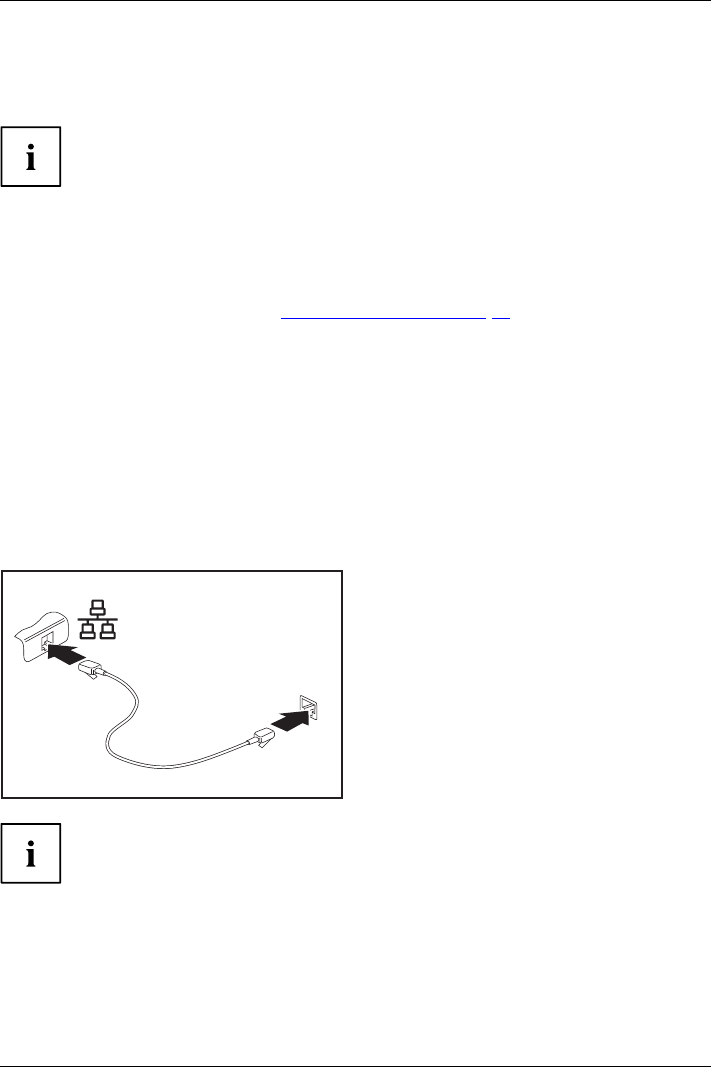
Working with the Tablet PC
Configuring WLAN access
• Requirement: A WLAN is available and you have the necessary access data to hand.
Information on configuring WLAN access can be found in the
documentation for your operating system.
Further information on WLAN and Bluetooth
For further information about WLAN or Bluetooth, please refer to the
appendix of this Operating Manual.
For WLAN specifications, see chapter "WLAN specifications", Page 82.
NFC (Near Field Communication, configuration dependent)
Depending on the configuration chosen, your Tablet PC may be equipped with an
integrated NFC chip. Near Field Communication is used for contactless exchange of
data via radio over short distances (a few centimeters).
Ethernet and LAN (only with docking cradle)
EthernetLAN
The internal network module of your Tablet PC supports Ethernet LAN. You can use it to
establish a connection to a local network (LAN = Local Area Network).
2
1
►Connect the network cable to the LAN
port of the docking cradle (1).
►Connect the network cable to your
network connection (2).
Your network administrator can help you to configure and use the LAN connections.
The network cable is not included in the delivery scope. This type of
cable can be obtained from a specialist dealer.
Fujitsu 41

Working with the Tablet PC
GPS
GPS
Whether your device has this function depends on the chosen device configuration.
42 Fujitsu

Accessories for your Tablet PC (optional)
Accessories for your Tablet PC (optional)
The following accessories are available for your Tablet PC:
• Docking cradle for charging the Tablet PC and with additional ports
• Magnetic keyboard with cover function
• Conversion adapter: MiniDP - VGA, MiniDP - HDMI and USB - LAN
• Notebook mouse
The following sections provide more information on handling the accessories.
Fujitsu 43
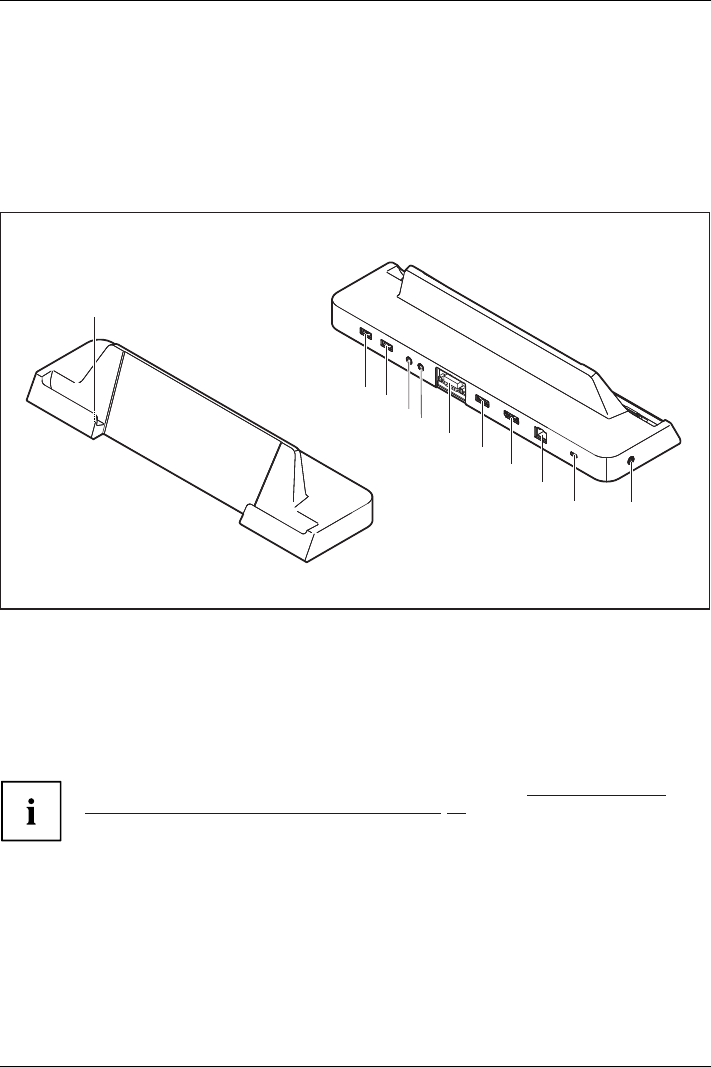
Accessories for your Tablet PC (optional)
Your docking cradle (optional)
Your docking cradle is a device that also allows you to quickly connect your Tablet PC
to your peripherals such as a display, keyboard, mouse, etc. You only need to dock
the Tablet PC to be able to work with your peripheral devices.
Cradle components
PortsPortsCradle
2
1
3
10
4
6
7
8
9
11
5
1 = Docking port
2 = USB port (USB 3.0)
3 = USB port (USB 3.0)
4 = Microphone port
5 = Headphones port
6 = VGA monitor port
7 = HDMI port
8 = Display Port
9 = LAN port
10 = Security Lock device
11 = DC jack socket (DC IN)
Information on screen resolution can be found in the section "Screen resolutions
for integrated screen and external screens", Page 83.
44 Fujitsu

Accessories for your Tablet PC (optional)
Settingupthecradle
Select a suitable location for the cradle before setting it up. In doing
so, please follow these instructions:
• Placethecradleonaflat, stable, non-slippery surface.
• Never place the cradle or the AC adapter on a heat-sensitive surface.
• Do not expose the cradle to extreme environmental conditions.
• Protect the cradle from dust, moisture and heat.
Fujitsu 45
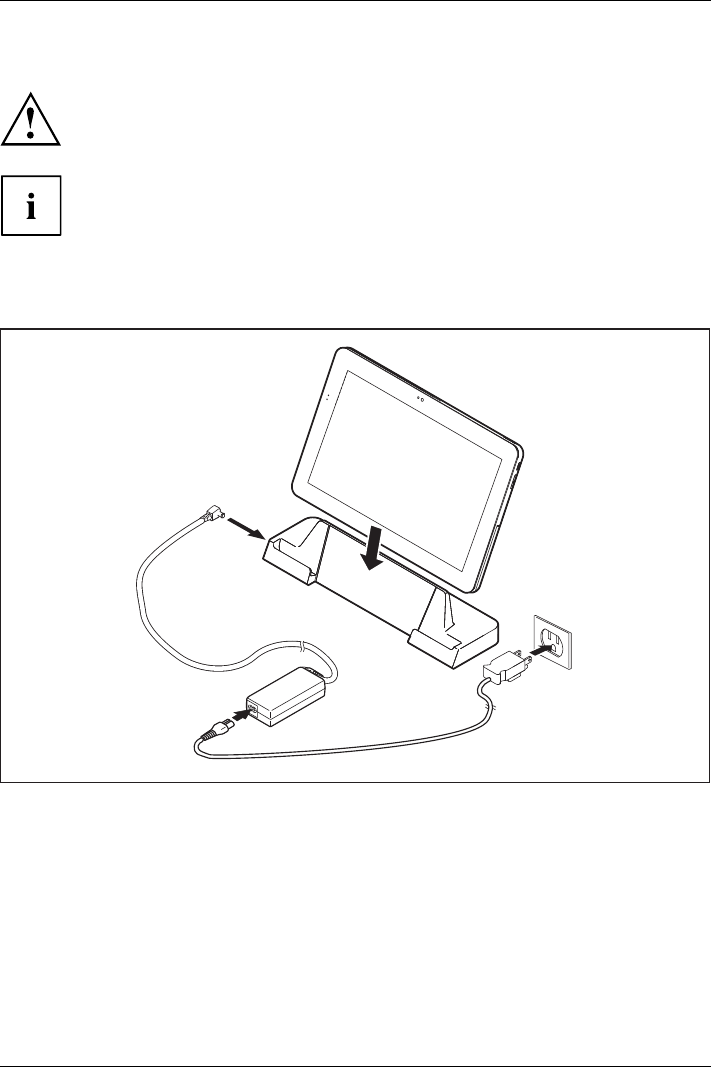
Accessories for your Tablet PC (optional)
Connecting the Tablet PC to the cradle
It is possible to connect the Tablet PC to the cradle while it is running.
Disconnect the AC adapter from the Tablet PC before connecting the
Tablet PC to the docking cradle.
When the Tablet PC is connected to the cradle, you must connect
the AC adapter to the cradle.
Cradle
►Remove the AC plug of the AC adapter from the power outlet.
►Remove the AC adapter cable from the DC jack (DC IN) of the Tablet PC.
►Fold in the tablet stand so that it lies flat on the rear of the Tablet PC.
4
1
2
3
►Position the Tablet PC so that it lies against the storage surface of the cradle.
►Push the Tablet PC on to the docking cradle in the direction of the arrow (1)
until you feel it engage on the connector.
►Plug the AC adapter cable into the DC jack (DC IN) on the cradle (2).
►Connect the AC cable to the AC adapter (3).
►Plug the AC cable into the power outlet (4).
46 Fujitsu
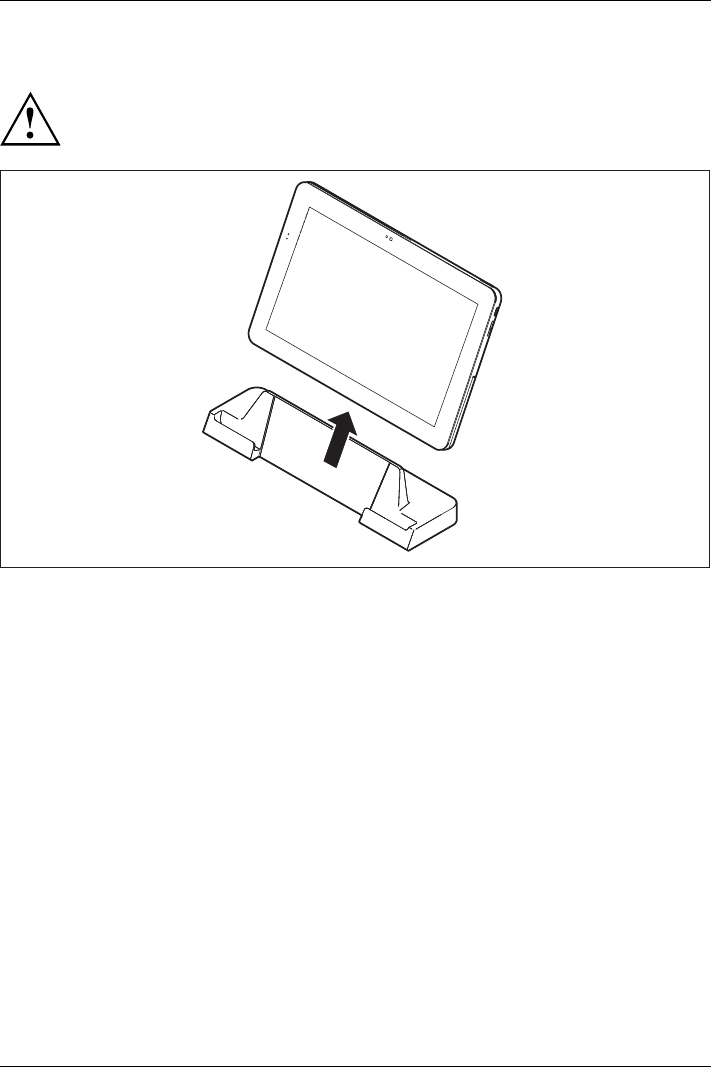
Accessories for your Tablet PC (optional)
Disconnecting the Tablet PC from the cradle
It is possible to separate the Tablet PC from the cradle while it is running.
1
►While holding the lower area of the docking cradle, lift the Tablet PC in the direction
of the arrow and away from the docking cradle (1).
Fujitsu 47
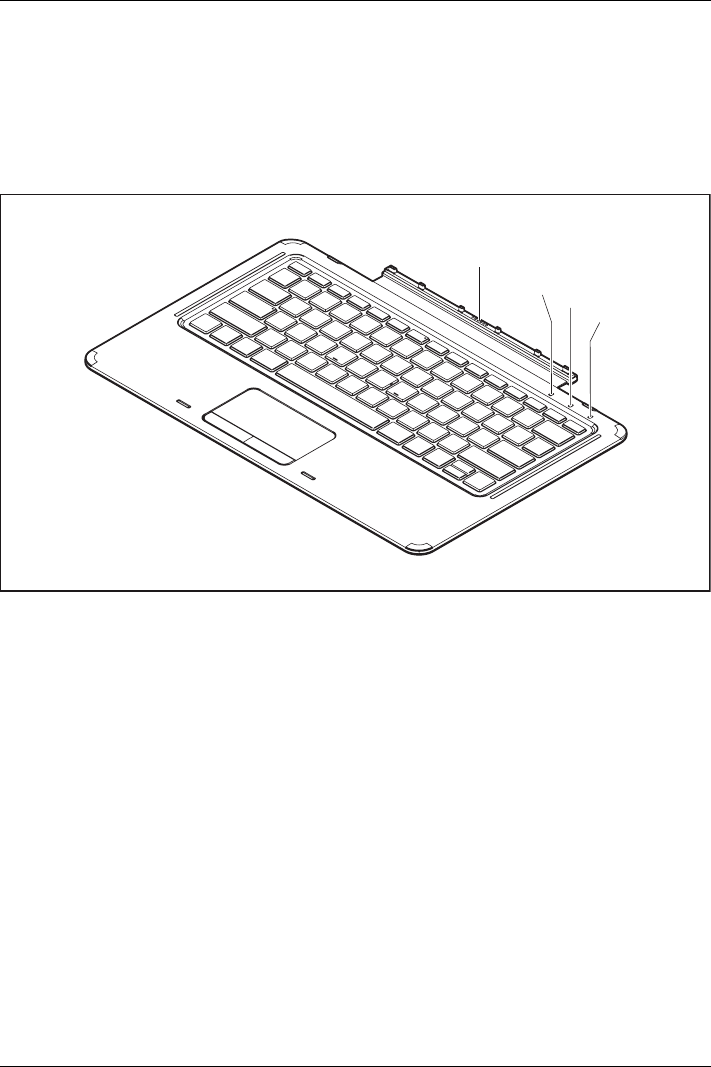
Accessories for your Tablet PC (optional)
Magnetic keyboard (optional)
The magnetic keyboard is an optimized device for the convenient input of text. It
only needs to be docked with the Tablet PC.
Components of the magnetic keyboard
Magnetickeyboar dPorts
234
1
1 = Docking port for the Tablet PC
2 = Num Lock indicator (to switch virtual
numeric keypad on and off)
3 = Caps Lock indicator (to switch
capitalization function on and off)
4 = Scroll Lock indicator (function dependent
on the application program)
48 Fujitsu
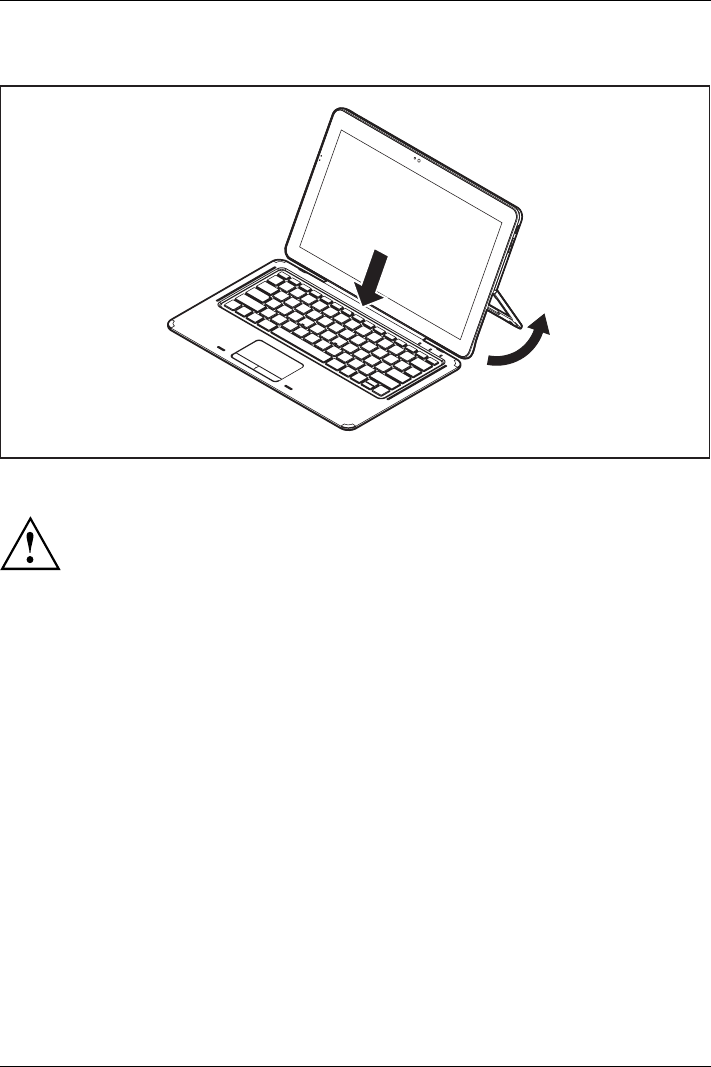
Accessories for your Tablet PC (optional)
Connecting the Tablet PC to the magnetic keyboard
Magnetickeyboar d
2
90° max.
1
►Fold out the tablet stand (1).
Open the tablet stand to a maximum angle of 90 degrees. Otherwise
the joint of the tablet stand will be damaged.
►Position the Tablet PC so that the docking ports of the Tablet PC and the magnetic keyboard
approach in the direction of the arrow (2) and the magnetic connection clicks into place.
Fujitsu 49
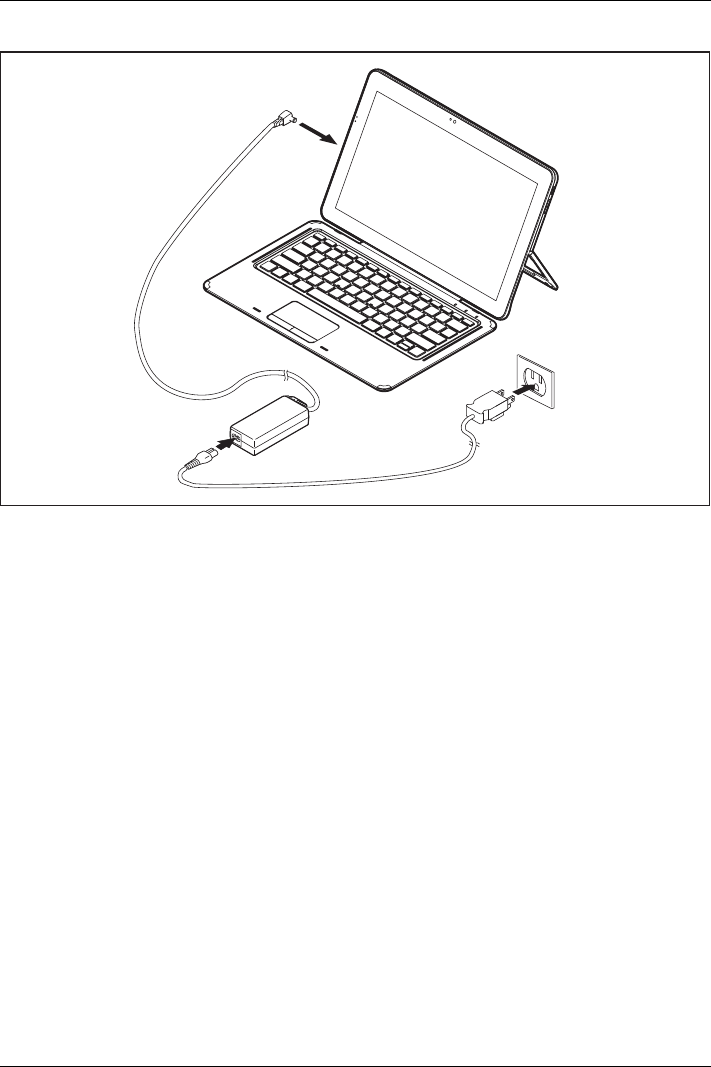
Accessories for your Tablet PC (optional)
5
3
4
►Connect the AC adapter cable to the DC input connector (DC IN) of the Tablet PC (3).
►Connect the power cable to the AC adapter (4).
►Plug the power cable into the power outlet (5).
50 Fujitsu
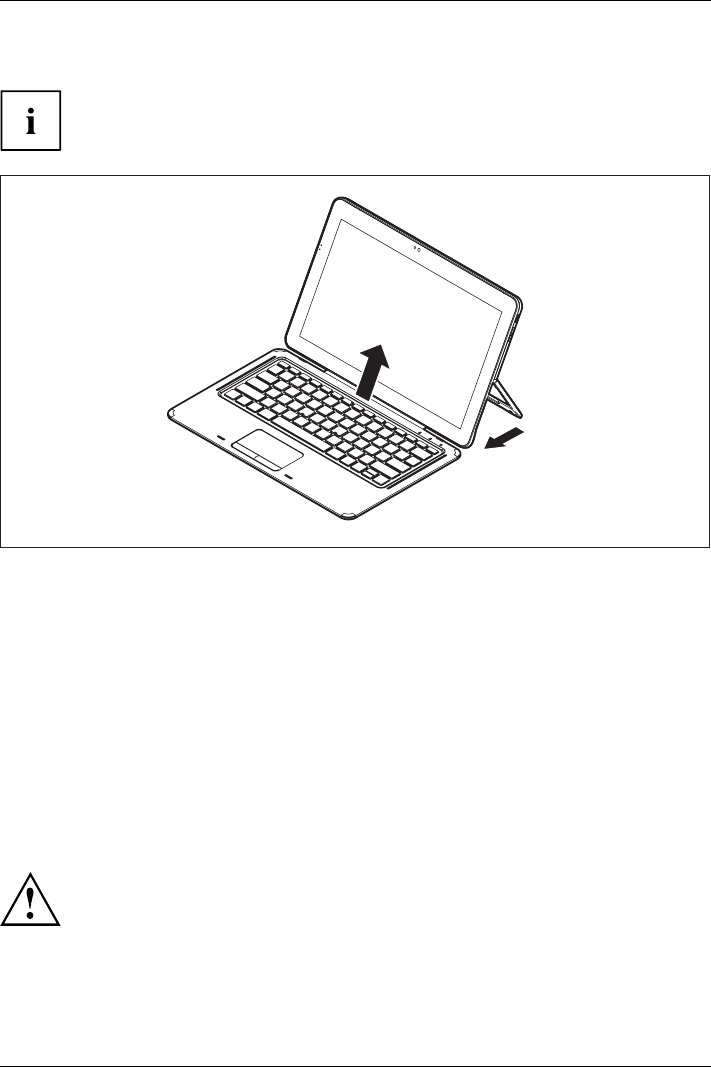
Accessories for your Tablet PC (optional)
Separating the Tablet PC from the magnetic keyboard
It is possible to separate the Tablet PC from the magnetic keyboard while it is running.
2
1
►While holding the lower area of the magnetic keyboard, lift the Tablet PC away from
the magnetic keyboard in the direction of the arrow (1).
►Fold in the tablet stand (2) again.
Using the device with a docking cradle and
magnetic keyboard (optional)
If you have both a docking cradle and a magnetic keyboard, you can also use
the device with these two accessory components.
Connecting the Tablet PC with magnetic keyboard
to the docking cradle
The magnetic keyboard must be connected to the Tablet PC before you
connect the Tablet PC to the docking cradle.
It is possible to connect the Tablet PC to the cradle while it is running.
Disconnect the AC adapter from the Tablet PC before connecting the
Tablet PC to the docking cradle.
Fujitsu 51
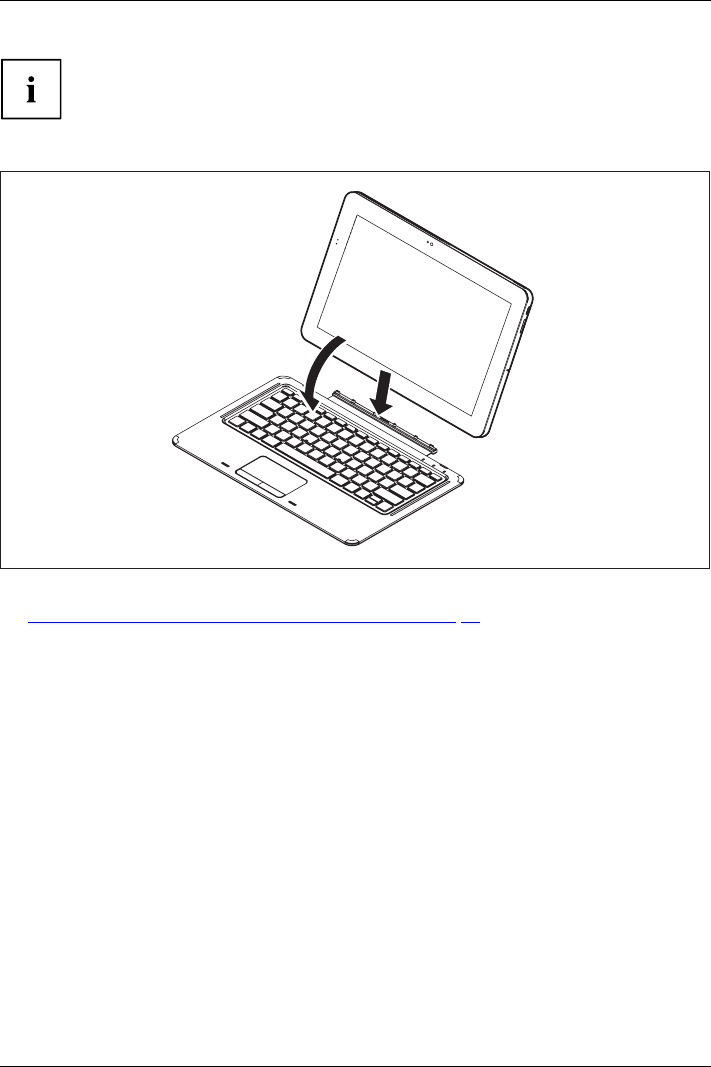
Accessories for your Tablet PC (optional)
When the Tablet PC is connected to the cradle, you must connect
the AC adapter to the cradle.
Cradle
►Remove the AC adapter cable from the DC jack (DC IN) of the Tablet PC.
1
2
►Connect the Tablet PC with the magnetic keyboard (1) as described in the section
"Connecting the Tablet PC to the magnetic keyboard", Page 49.
►Fold together the Tablet PC and the magnetic keyboard (2).
52 Fujitsu
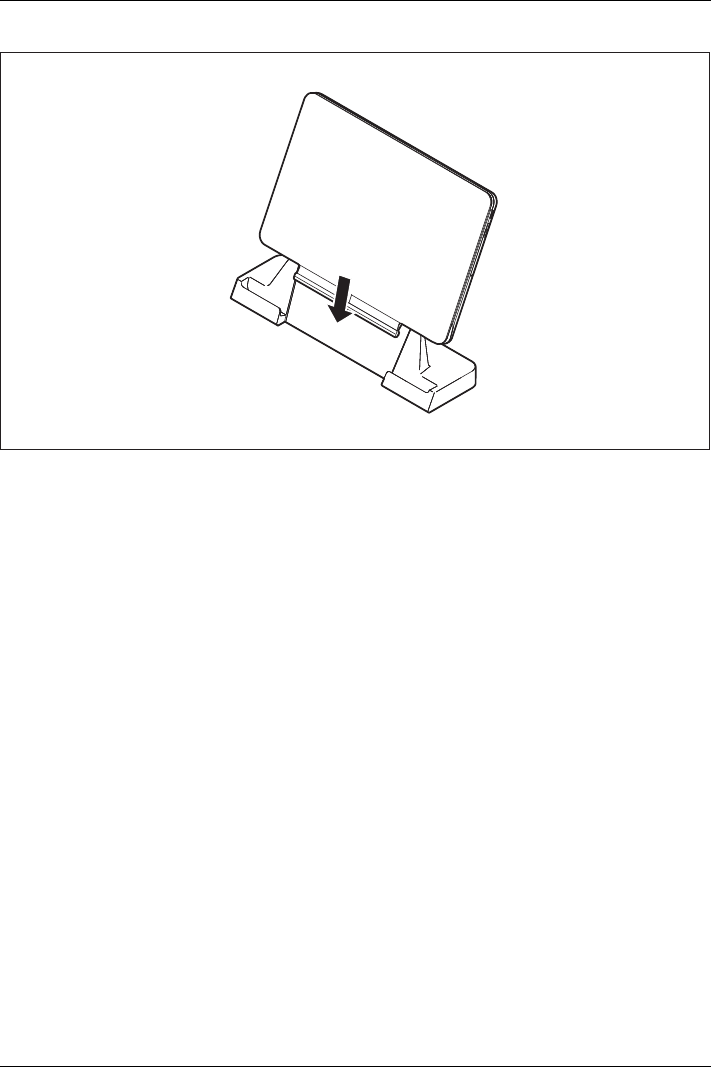
Accessories for your Tablet PC (optional)
3
►Position the Tablet PC with the magnetic keyboard so that it lies on the
surface of the tray on the docking cradle.
►Push the Tablet PC on to the docking cradle in the direction of the arrow (3)
until you feel it engage on the connector.
Fujitsu 53
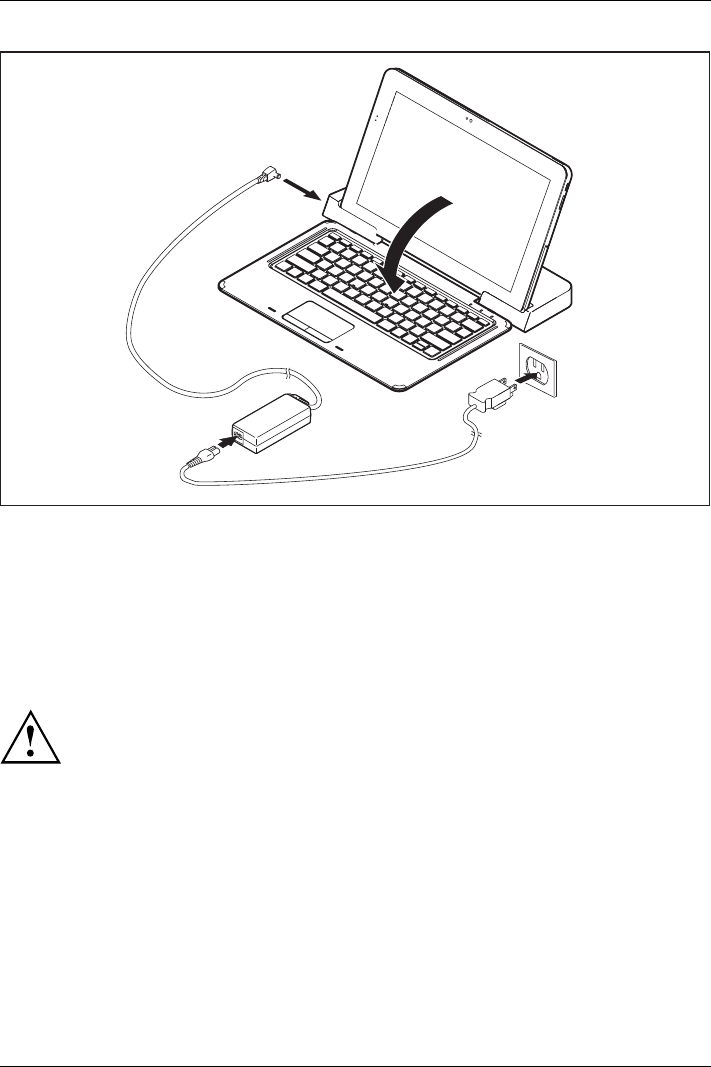
Accessories for your Tablet PC (optional)
7
5
6
4
►Fold down the magnetic keyboard in the direction of the arrow (4).
►Plug the AC adapter cable into the DC input connector (DC IN) on the docking cradle (5).
►Connect the power cable to the AC adapter (6).
►Plug the power cable into the power outlet (7).
Separating the Tablet PC with magnetic keyboard
from the docking cradle
It is possible to separate the Tablet PC from the docking cradle during operation:
You must first separate the Tablet PC from the docking cradle before you can
remove the keyboard. Attempting to remove the magnetic keyboard while the Tablet
PC is in the docking cradle can damage the magnetic keyboard.
54 Fujitsu
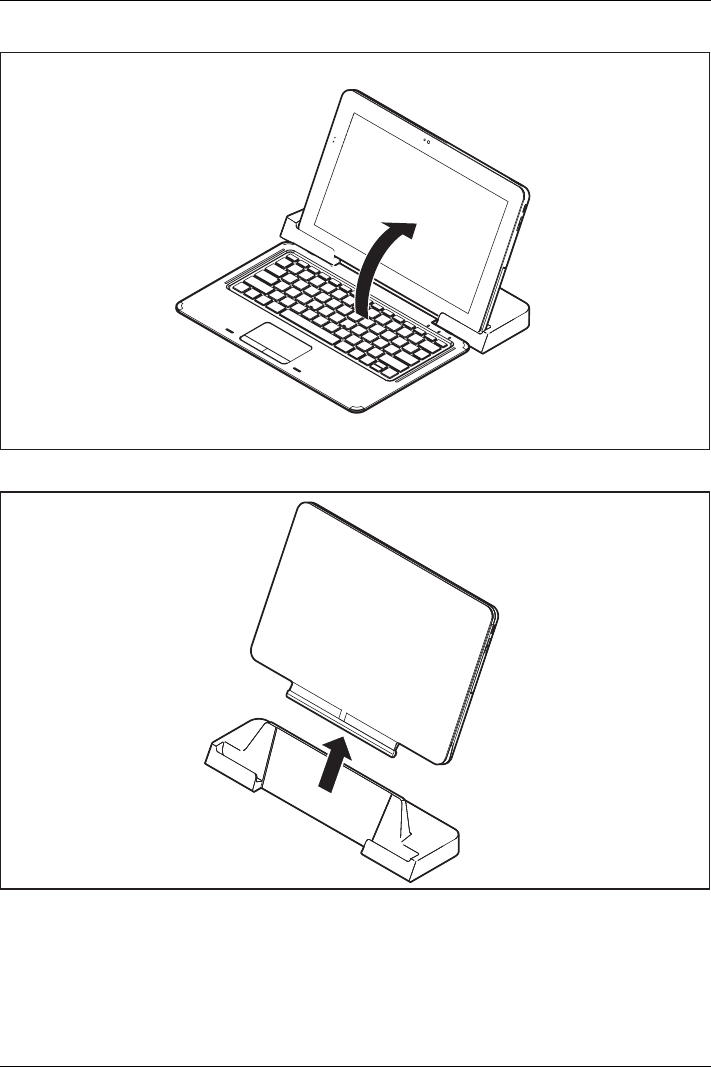
Accessories for your Tablet PC (optional)
1
►Fold the magnetic keyboard in the direction of the arrow (1).
2
►While holding the lower part of the docking cradle, lift the Tablet PC with the
magnetic keyboard in the direction of the arrow (2).
Fujitsu 55
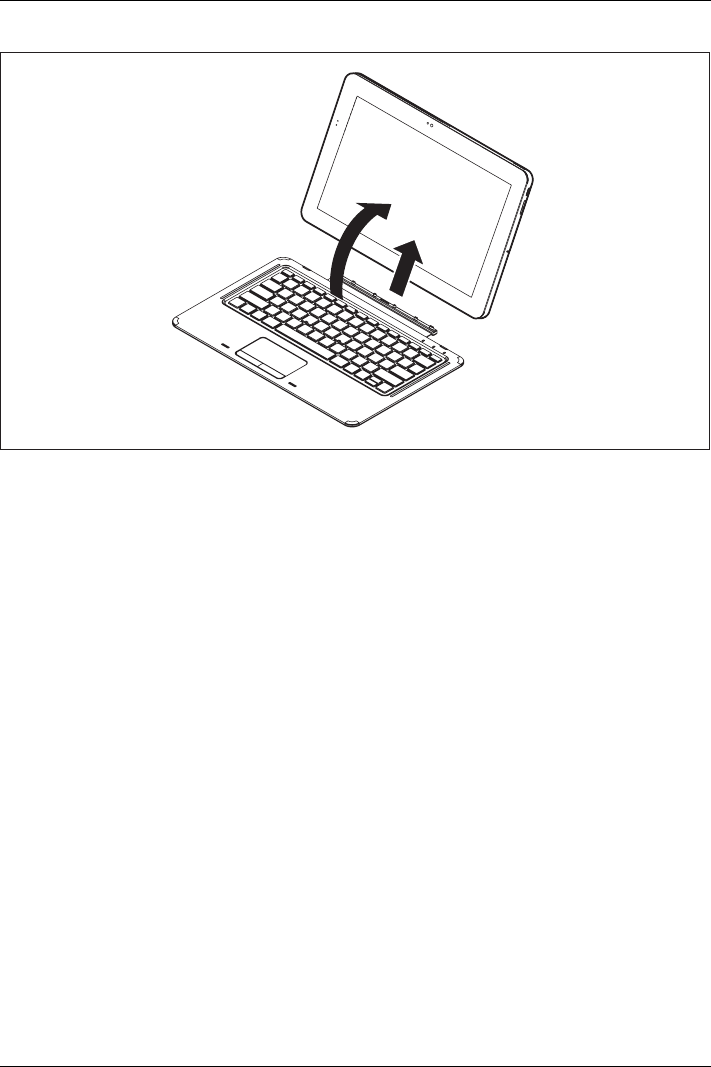
Accessories for your Tablet PC (optional)
4
3
►Fold the Tablet PC in the direction of the arrow (3).
►While holding the lower area of the magnetic keyboard, lift the Tablet PC away from
the magnetic keyboard in the direction of the arrow (4).
56 Fujitsu
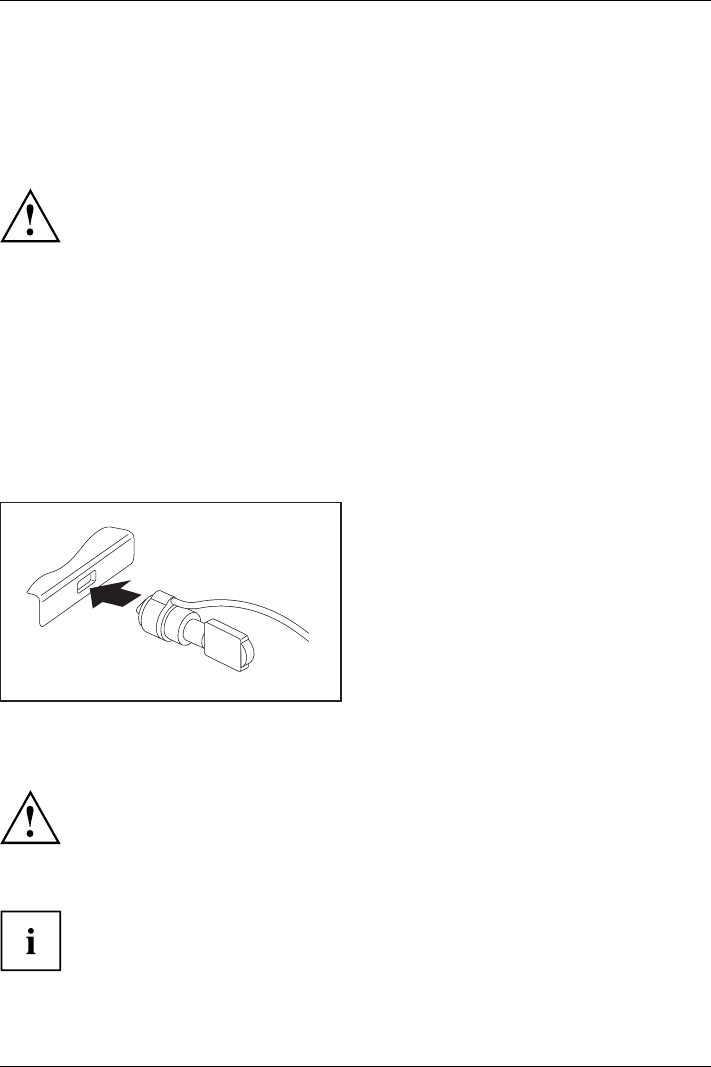
Security functions
Security functions
Securityfunctions
Your Tablet PC has several security features that you can use to secure your system
and your personal data from unauthorized access.
This chapter explains how to use these functions, and what the benefits are.
Please remember that in some cases, for example, forgetting your password,
you may be locked out of the system and unable to access your data.
Therefore, please note the following information:
• Back up your data on external data carriers at regular intervals.
• Some security functions need you to choose passwords. Make a note
of the passwords and keeptheminasafeplace.
If you forget your passwords you will need to contact our Service Desk.
Deletion or resetting of passwords are not covered by your warranty
and a charge will be made for assistance.
Using the security lock (docking cradle only)
SecurityLockAnti-theftprotectionSecurityLock
Your docking cradle (optional) is equipped with a security device for a Kensington lock cable.
You can use the Kensington lock cable, a sturdy steel cable, to protect your docking cradle
against theft. The Kensington lock cable is available as an accessory.
►Fit the lock cable to the device on
your docking cradle.
Configuring password protection in BIOS Setup Utility
Before using the various options for password protection in the BIOS Setup
Utility, please proceed as follows to increase data security:
Make a note of the passwords and keep them in a safe place. If you forget your
supervisor password you will not be able to access your Tablet PC. Passwords are
not covered by your warranty and a charge will be made for assistance.
Password protection
Your password can be up to 32 characters long and can contain letters, numbers and
special characters. A distinction is made between upper and lower case.
When using special characters, please keep in mind that they depend on
the country version of the attached keyboard.
Fujitsu 57

Security functions
Protecting BIOS Setup Utility (supervisor password
and user password)
If you have opened these operating instructions on the screen, we recommend
that you print them out. You cannot call up the instructions on the screen
while you are setting up the password.
BIOSSetupUtility
The supervisor password and the user password both prevent unauthorized use of the BIOS
Setup Utility. The supervisor password allows you to access all of the functions of the BIOS Setup
Utility, while the user password will only give you access to some of the functions. You can
only set up a user password if a supervisor password has already been assigned.
Calling and using the BIOS Setup Utility is described in the chapter
"Settings in BIOS Setup Utility", Page 68.
Assigning the supervisor and user passwords
►Start the BIOS Setup Utility and go to the Security menu.
►Select the Set Supervisor Password field and press the Enter key.
With Enter new Password: you are asked to enter a password.
►Enter the password and press the Enter key.
Confirm new Password requires you to confirm the password.
►Enter the password again and press the Enter key.
Changes have been saved is displayed as a confirmation that the new password has been saved.
►To set the user password, select Set User Password and proceed exactly as
when configuring the supervisor password.
If you do not want to change any other settings, you can exit BIOS Setup Utility.
►In the Exit menu, select the option Save Changes & Exit.
►Select Yes and press the Enter key.
PasswordSupervisor passwordUserpassword
The Tablet PC is rebooted and the new password is effective. It will now be necessary to
first enter your supervisor or user password in order to open the BIOS Setup Utility. Please
note that the user password only provides access to a few of the BIOS settings.
Changing the supervisor password or user password
You can only change the supervisor password when you have logged into the
BIOS Setup Utility with the supervisor password.
PasswordSupervisorpasswordUserpassword
►Start the BIOS Setup Utility and go to the Security menu.
►When changing the password, proceed exactly as when assigning a password.
58 Fujitsu

Security functions
Removing passwords
To remove a password (without setting a new password) perform the following steps:
PasswordSupervisorpasswordUserpassword
►Start the BIOS Setup Utility and go to the Security menu.
►Highlight the Set Supervisor Password or Set User Password field and press the Enter key.
You will be requested to enter the current password by the Enter Current Password prompt.
Enter New Password will appear and you will be requested to enter a new password.
►Press the Enter key twice at this request.
►In the Exit menu, select the option Save Changes & Exit.
►Select Yes and press the Enter key.
The Tablet PC is rebooted and the password is removed.
Removing the supervisor password simultaneously deactivates the user password.
Password protection for booting the operating system
With the supervisor password you have set in the BIOS Setup Utility (see
section "Assigning the supervisor and user passwords", Page 58), you can
also prevent booting of the operating system.
Operating system
Activating system protection
►Start the BIOS Setup Utility and go to the Security menu.
Operatingsystem
►Select the PasswordonBootoption and press the Enter key.
►Select the option you require (First Boot or Every Boot) and press the enter key
►Select the Save Changes & Exit option under Exit.
The Tablet PC reboots. You will be prompted to enter your password (the supervisor password).
Deactivating system protection
►Start the BIOS Setup Utility and go to the Security menu.
Operatingsystem
►Select the PasswordonBootoption and press the Enter key.
►Select the Disabled option and press the Enter key.
If you do not want to change any other settings, you can exit BIOS Setup Utility.
►Select the Save Changes & Exit option under Exit.
The Tablet PC reboots. The system is no longer password-protected.
Fujitsu 59

Security functions
Password protection for the hard disk
Passwordprotect ion
The hard disk password prevents unauthorized access to the hard disk drives
and is checked internally each time the system is booted. The condition for this
is that you have assigned at least the supervisor password.
Activating hard disk protection
►Call up the BIOS Setup and select the Security menu.
If you have not assigned BIOS passwords yet, define the supervisor and the user
password now, if desired (see "Security functions", Page 57).
►Mark the Hard Disk Security field and press the Enter key.
►In the area Drive0, mark the field Set Master Password and press the Enter key.
Enter new Password then appears and you are asked to enter a password.
►Enter the password and press the Enter key.
Confirm new Password requires you to confirm the password.
►Enter the password again and press the Enter key.
With Setup Notice: Changes have been saved you receive confirmation that
the new password has been saved.
The field Password Entry on Boot is set to Enabled by default. You can exit the BIOS
Setup once you have finished changing the settings.
►From the Exit menu, choose the option Exit Saving Changes.
►Press the Enter key and select Yes.
The Tablet PC reboots and your hard disk is now protected with a password. The
password prompt is enabled as soon as the Tablet PC has rebooted.
Deactivating hard disk protection
To cancel a password (without setting a new password) proceed as follows:
►Call up the BIOS Setup and select the Security menu.
►Mark the Hard Disk Security field and press the Enter key.
►In the area Drive0, mark the field Set Master Password and press the Enter key.
With the prompt Enter current Password you are first asked to enter the old password again.
With Enter new Password you are then prompted to enter a new password.
►After the request, press the Enter key three times.
►From the Exit menu, choose the option Exit Saving Changes.
►Press the Enter key and select Yes.
The Tablet PC reboots and there is no longer any password protection for this hard disk.
60 Fujitsu

Security functions
Trusted Platform Module - TPM (configuration
dependent)
TPMTrustedPlatfor mModule
To use the TPM, you must enable the TPM in the BIOS Setup before the software is
installed. The requirement for this is that you have assigned at least the supervisor
password (see "Security functions", Page 57).
Enabling TPM
• Requirement: You have assigned a supervisor password (see "Security functions", Page 57).
►Call BIOS Setup and select the Security menu.
►Mark the TPM Security Chip Setting field and press the Enter key.
►Select the entry Enabled to enable the TPM
Once you have enabled the TPM the Clear Security Chip menu item appears.
You can clear the holder in the TPM using Clear Security Chip.WithEnabled,
all secret keys (e.g. SRK - Storage Root Keys, AIK - Attestation Identity Keys
etc.) generated by applications are deleted.
Take note that you can then no longer access the data you have
encrypted on the holder-based keys!
►From the Exit menu, choose the option Exit Saving Changes.
►Press the Enter key and select Yes.
The Tablet PC restarts and the TPM is enabled after the reboot.
Disabling TPM
• Requirement: You have assigned a supervisor password (see "Security functions", Page 57).
►Call BIOS Setup and select the Security menu.
►Mark the TPM Security Chip Setting field and press the Enter key.
►Select the entry Disabled to disable the TPM.
►From the Exit menu, choose the option Exit Saving Changes.
►Press the Enter key and select Yes.
The Tablet PC restarts and the TPM is disabled.
Fujitsu 61
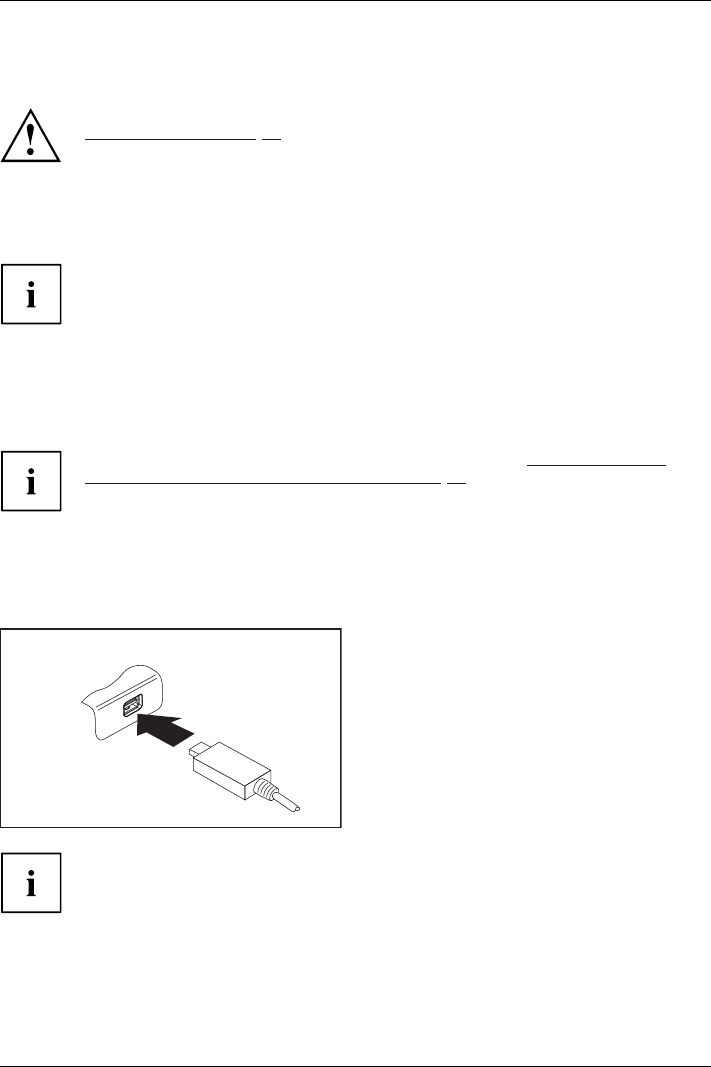
Connecting external devices
Connecting external devices
Under all circumstances, please observe the safety notes provided in the
"Important notes", Page 13 chapter before connecting or disconnecting
any devices to or from your Tablet PC.
Always read the documentation supplied with the device you wish to connect.
Never connect or disconnect cables during a thunderstorm.
Never pull at a cable when disconnecting it. Always grasp the plug.
With some devices, such as USB devices, it is not necessary to switch off
the Tablet PC and the device before connecting/disconnecting. For more
information about whether or not devices need to be switched off, please refer
to the documentation supplied with your external device.
Some of the external devices require special drivers (see the operating
system and external device documentation).
Connecting an external monitor
Information on screen resolution can be found in the section "Screen resolutions
for integrated screen and external screens", Page 83.
Mini Display Port
DisplayPort
The mini Display Port of the Tablet PC can be used to connect a monitor, an LCD
TV or a plasma TV with a corresponding connection.
►Connect the data cable to the
external device.
►Connect the data cable to the mini
Display Port of the Tablet PC.
Some LCD televisions have only two speaker connections and therefore
cannot reproduce Dolby Digital or DTS. In order to reproduce the sound, you
must go into Windows and adjust the sound settings.
►To do this, deactivate the DTS Audio and Dolby Digital settings in the control
panel for the Realtek HDMI Output.
62 Fujitsu
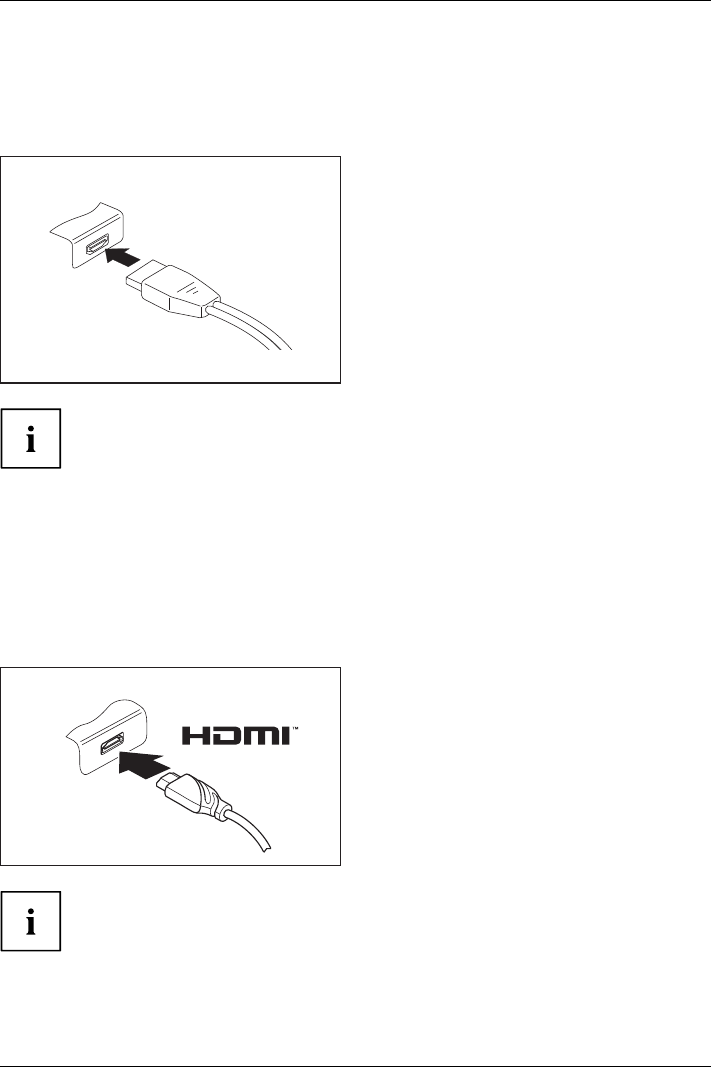
Connecting external devices
Display Port (docking cradle only)
DisplayPort
The Display Port of the docking cradle can be used to connect a monitor, an LCD
TV or a plasma TV with a corresponding connection. Display output is limited to a
maximum of two external screens at the same time.
►Connect the data cable to the
external device.
►Connect the data cable to the Display
Port of the cradle.
Some LCD televisions have only two speaker connections and therefore
cannot reproduce Dolby Digital or DTS. In order to reproduce the sound, you
must go into Windows and adjust the sound settings.
►To do this, deactivate the DTS Audio and Dolby Digital settings in the control
panel for the Realtek HDMI Output.
HDMI port (docking cradle only)
HDMIport
TheHDMIporto
f the docking cradle can be used to connect an external amplifier,
LCD TV or a plasma TV with an HDMI connection. Display output is limited to a
maximum of two external screens at the same time.
►Connect the data cable to the
external device.
►Connect the data cable to the HDMI
port of the docking cradle.
Some LCD televisions have only two speakers/speaker ports and therefore
cannot reproduce Dolby Digital or DTS. To play back HDMI sound, you
must change the HDMI sound settings accordingly.
You can find the settings under Control Panel - Hardware and Sound. Deactivate the
settings for DTS Audio and Dolby Digital to enable playback of HDMI sound.
Fujitsu 63
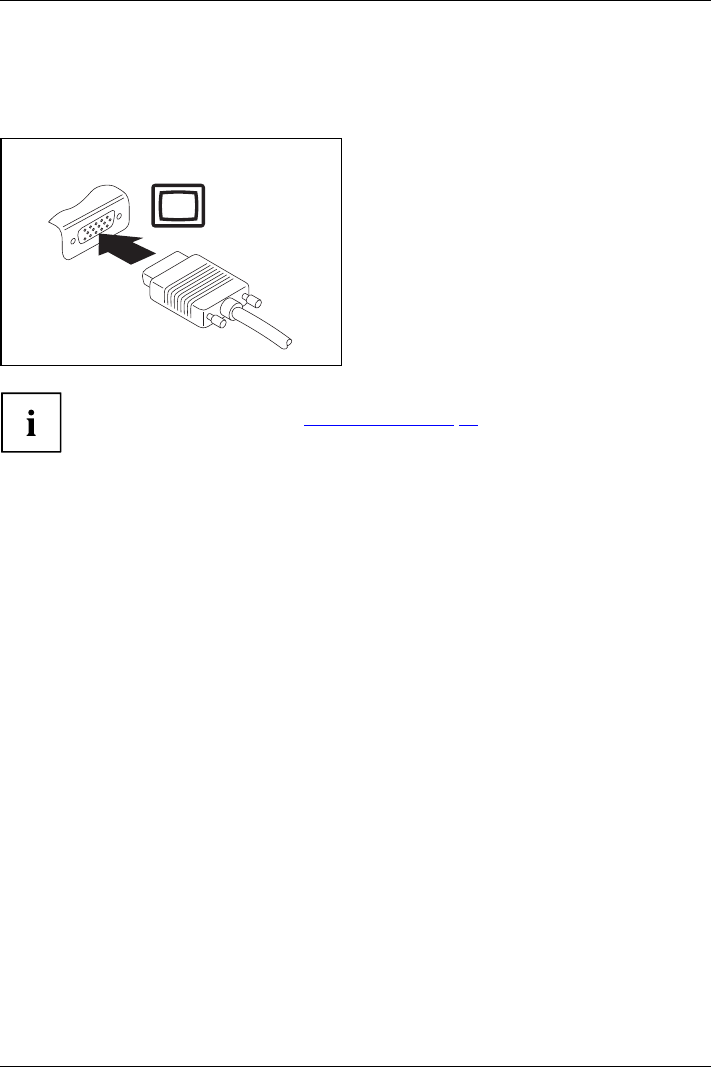
Connecting external devices
External monitor port (VGA) (docking cradle only)
An analog monitor is connected to the analog external monitor port (VGA). Display output
is limited to a maximum of two external screens at the same time.
MonitorVGAportScreen connectionMonito rconnection
►Switch off the Tablet PC and the
external monitor.
►Plug the data cable of the external
monitor into the monitor port.
►First switch on the external monitor and
then switch on the Tablet PC.
You can also switch back and forth between the external monitor and the LCD
screen of the Tablet PC, see "Touchscreen", Page 27.
You can display the same image on the external monitor and on the LCD
screen of the Tablet PC at the same time.
64 Fujitsu
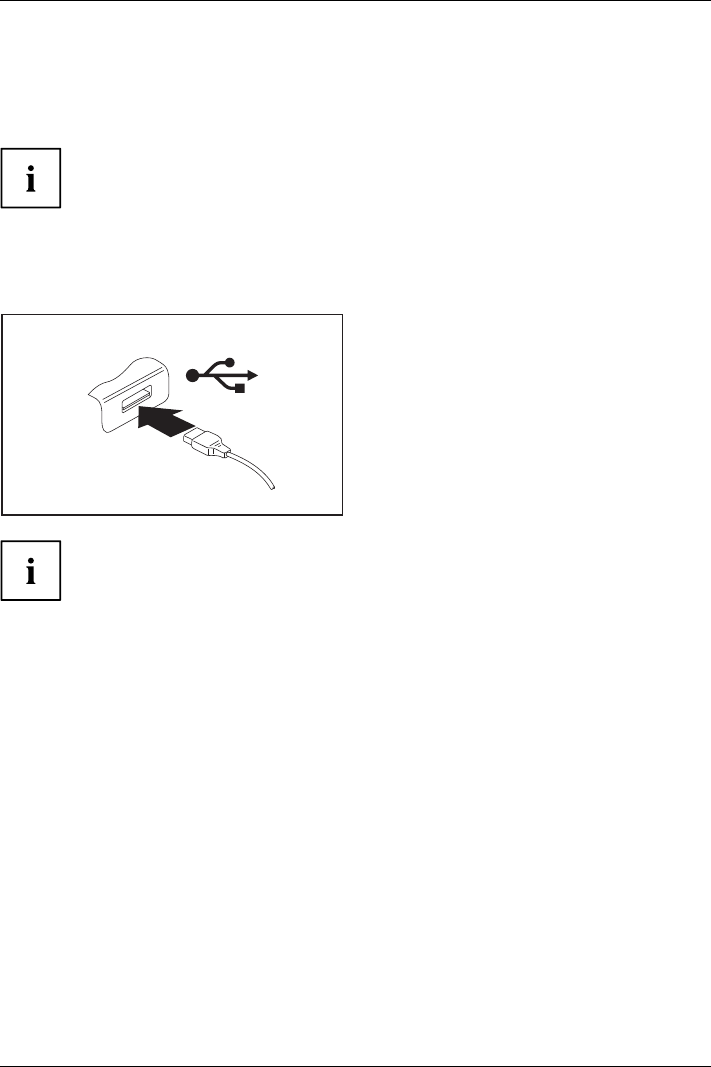
Connecting external devices
Connecting USB devices
USBports
On the USB ports you can connect external devices that also have a USB port
(e.g. a DVD drive, a printer, a scanner or a modem).
USB devices are hot-pluggable. This means you can connect and disconnect the
cables of USB devices while the operating system is running.
USB 1.x has a maximum data transfer rate of 12 Mbps.
USB 2.0 has a data transfer rate of up to 480 Mbps.
USB 3.0 has a data transfer rate of up to 5 Gbps.
Additional information can be found in the documentation for the USB devices.
►Connect the data cable to the
external device.
►Connect the data cable to the USB
port of the Tablet PC.
or
►Connect the data cable to a USB
port of the cradle.
Device drivers
USB devices will be automatically recognized and installed by your operating system.
Fujitsu 65
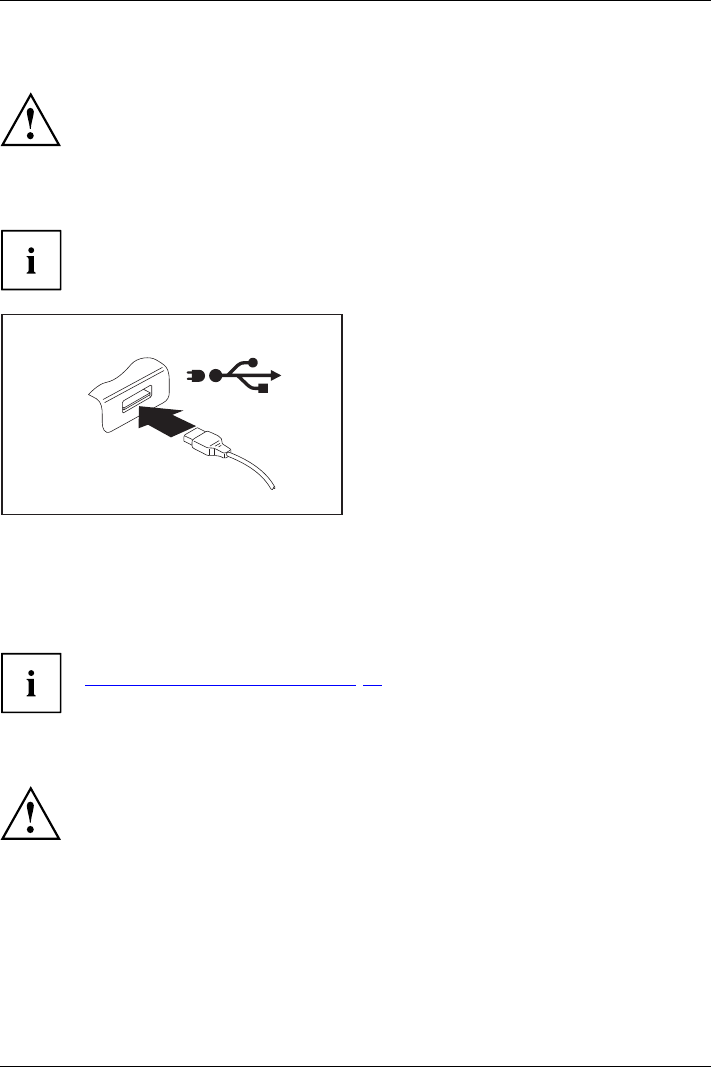
Connecting external devices
USB port with charging function (Anytime USB charge)
USBchargingfunction
It is recommended that the Tablet PC is operated with the power supply connected
whenever the USB port with charging function is in use, as the battery runtime
is reduced if additional USB devices are being charged.
The power supply must already be connected when the Tablet PC is
switched off, as otherwise the USB charging function will not be active and
the connected USB devices will not be charged.
Some USB devices (e.g. mobile phones) need a driver to be able to use the USB
charging function. In this case the USB charging function will not work when the Tablet
PC is switched off, as no drivers are active when the Tablet PC is switched off.
You can use this USB port to charge or supply power to a USB device (e.g. to charge
a PDA or a mobile phone or to connect a USB lamp).
This is also possible even when the Tablet PC is switched off, if in the BIOS-Setup-Utility,in
the menu Advanced, the function Anytime USB Charge is enabled. If the setting AC is selected
thereby, the device will only be charged when the mains adapter is connected.
Calling and using the BIOS Setup Utility is described in the section
"Settings in BIOS Setup Utility", Page 68.
How to remove USB devices correctly
Always correctly remove the device according to the rules described below,
to ensure that none of your data is lost.
►Tap the symbol for safe removal of the hardware.
►Select the device you wish to shut down and remove.
►Tap OK.
Wait for the dialog box which tells you that it is now safe to remove the device.
66 Fujitsu
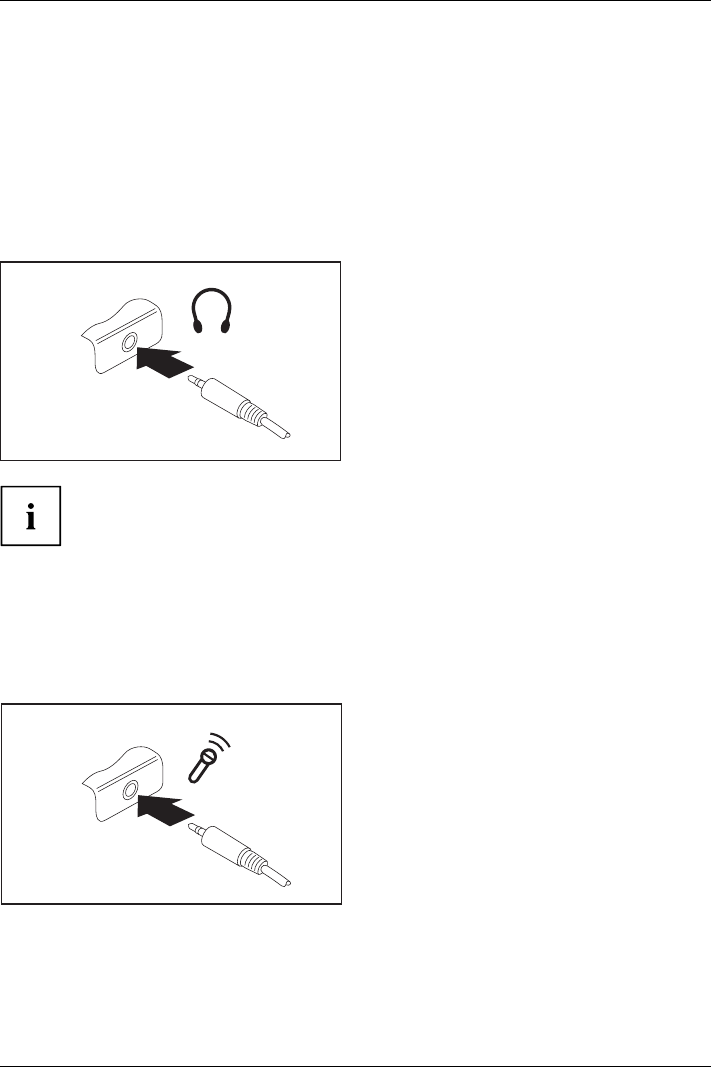
Connecting external devices
Connecting external audio devices
Your Tablet PC has a combined headphone and microphone port, your (optional) docking
cradle has separate ports for headphones and a microphone.
Connecting headphones or other audio output devices
Connectingaudio devicesAudioconnectionsConnectingheadph ones
The combined headphones and microphone port of the Tablet PC or the headphones
port of the docking cradle (optional) allows you to connect output devices, such as
headphones, external speakers, etc., to your Tablet PC.
►Connect the audio cable to the
external device.
►Connect the audio cable to the combined
headphones and microphone port of the
Tablet PC or to the headphone port of
the docking cradle (optional).
The internal speakers are disabled.
If you buy a cable from a retailer, please note the following:
The combined headphone and microphone port on your Tablet PC
isa"3.5mmjacksocket".
If you want to connect headphones or speakers you will need a "3.5 mm jack plug".
Connecting a microphone or other audio input devices
Connectingaudio devicesAudioconnectionsConnectingmicrophone
The combined headphones and microphone port of the Tablet PC or the microphone port
of the docking cradle (optional) allows you to connect an external microphone, a MiniDisc
player, MP3 player, CD player or a tape deck to your Tablet PC.
►Connect the audio cable to the
external device.
►Connect the audio cable to the combined
headphones and microphone port of the
Tablet PC or to the microphone port of
the docking cradle (optional).
Fujitsu 67

Settings in BIOS Setup Utility
Settings in BIOS Setup Utility
BIOSSetupUtilitySystemsettings,BIOSSetupUtilityConfiguration,BIOSSetupUtilitySetupConfiguring systemConfiguringhardware
To navigate more easily in the BIOS Setup Utility, you can use an external USB keyboard.
The BIOS Setup Utility allows you to set the system functions and the hardware
configuration for the Tablet PC.
When the Tablet PC is delivered, the default settings are effective. You can change
these settings in the menus of the BIOS Setup Utility. Any changes you make take
effect as soon as you save and exit the BIOS Setup Utility.
The BIOS Setup Utility program contains the following menus:
Info Displays information relating to the BIOS, processor and Tablet PC
System Advanced system settings
Advanced Configuration of various hardware components, such as mouse, keyboard,
processor
Security Password settings and security functions
Boot Configuration of the start-up sequence
Exit Exits the BIOS Setup Utility
Starting the BIOS Setup Utility
►Keep the Volume Down button pressed and switch on the Tablet PC.
BIOSSetupUtility
►If a password has been assigned, enter the password and press the Enter key.
If you have forgotten the password, contact your system administrator
or contact our customer service centre.
The BIOS Setup Utility starts.
68 Fujitsu

Settings in BIOS Setup Utility
BIOS Setup Utility operation
BIOSSetupUtility
Press the F1 key to display help about operation of the BIOS Setup Utility. The description
of the individual settings is shown in the right-hand window of the BIOS Setup Utility.
With the F9 key you can load the default settings of the BIOS Setup Utility.
►Use the cursor keys ←or →to select the menu you wish to access to make changes.
The menu is displayed on the screen.
►Select the option you want to change with the cursor keys ↑or ↓.
►Press the "Enter" key.
►Press the ESC key to exit the selected menu.
►For future reference, make a note of the changes you have made (for example, in this manual).
Fujitsu 69

Settings in BIOS Setup Utility
Exiting BIOS Setup Utility
BIOSSetupUtility
You need to select the desired option in the Exit menu and activate it by pressing the Enter key:
Exit Saving Changes - save changes and exit BIOS Setup Utility
►To save the current menu settings and exit the BIOS Setup Utility, select Exit Saving Changes and Yes.
The Tablet PC is rebooted and the new settings come into effect.
Exit Discarding Changes - Reject changes and
exit BIOS Setup Utility
►To discard the changes, select Exit Discarding Changes and Yes.
The settings which were valid when BIOS Setup Utility was called remain effective.
The BIOS Setup Utility ends and the Tablet PC is rebooted.
Load Setup Defaults – load default values
►To copy the standard entries for all menus of the BIOS Setup Utility,
choose Load Setup Defaults and Yes.
Discard Changes - Discard Changes without
exiting BIOS Setup Utility
►To discard the changes you have made, select Discard Changes and Yes.
The settings in place when BIOS Setup Utility was called remain effective.
You can now make additional settings in the BIOS Setup Utility.
►IfyouwanttoexittheBIOS Setup Utility with these settings, select Exit Saving Changes and Yes.
Save Changes - save changes without exiting
the BIOS Setup Utility
►To save the changes, select Save Changes and Yes.
The changes are saved. You can now make additional settings in the BIOS Setup Utility.
►If you want to exit BIOS Setup Utility with these settings, choose Exit Saving Changes and Yes.
Save changes and power off
►To save the changes and switch off your device, select Save Changes and Power Off and Yes.
The changes are saved. Your device is shut down.
70 Fujitsu

Troubleshooting and tips
Troubleshooting and tips
TroubleshootingTipsFaultProblem solving
If a fault occurs, try to correct it as described. If you fail to correct the problem, proceed as follows:
►Make a note of the steps and the circumstances that led to the fault. Also
make a note of any error messages displayed.
►Switch the Tablet PC off.
►Please contact the Hotline/Service Desk.
You can contact Fujitsu Service and Support in the following ways:
• Toll free phone: 1-800-8Fujitsu (1-800-838-5487)
• Website: "http://solutions.us.fujitsu.com/www/content/support/contact/index.php"
Before you place the call, have the following information ready so that the customer
support representative can provide you with the fastest possible solution:
• The model name and serial number of the Tablet PC. The serial number
is located on a sticker on the underside of the Tablet PC.
• Notes with the messages that appeared on the screen and
informationonaco
ustic signals.
• All changes you have made to the hardware or software after receiving the Tablet PC.
• All changes you have made to the BIOS Setup settings after receiving the Tablet PC.
• Your system configuration and all peripheral devices connected to your system.
• Your sales contract.
Our Tablet PCs have been designed primarily with mobile applications in mind.
This means that considerable effort has been made to optimize components and
equipment in terms of weight, space and energy requirements. Depending on the
particular configuration you have purchased, it is possible that functionality may be
slightly reduced compared to a desktop PC if you are running processor-intensive
gaming software, e.g. games with intensive 3D graphics. Updating your hardware with
drivers which have not been approved by Fujitsu may result in performance losses,
data losses or malfunction of the equipment. A list of approved drivers and current
BIOS versions can be downloaded from: "http://solutions.us.fujitsu.com"
Fujitsu 71

Troubleshooting and tips
Executing a reset
If the device no longer responds to your inputs, choose one of the following options:
Forced shutdown
►Press and hold the ON/OFF button for at least 4 seconds.
The device will be shut down. You can then restart it.
Carry out a system or battery reset
If the device does not respond, first try to force the shutdown, as
described in the previous section.
►Disconnect the mains adapter from the device.
On the rear side of the device you can find a small hole.
►Use a small pointed tool with caution to press the reset button below this hole.
The device performs a reset, comparable to removing the battery. You can then restart it.
Help if problems occur
Should you encounter a problem with your computer that you cannot resolve yourself:
►Note the ID number of your device. The ID number is found on the type rating
plate on the back or underside of the casing.
►For further clarification of the problem, contact the Fujitsu Service Desk. When you do
this, please have ready the ID number and serial number of your system.
Recovering your Factory Image
In the event you need to restore your original Factory Image, please refer to
the appendix of this Operating Manual.
The TabletPC’sdateortimeisincorrect
SummertimeWintertimeIncorre cttimeTimenot correctWrongdate/timeDatenotcorrectChargingback-up battery
Cause Troubleshooting
Time and date are incorrect. ►With the BIOS-Setup-Utility, you can set the
date and time in the Main menu.
Date and time are still set incorrectly after
switching on the Tablet PC.
►Please contact your sales outlet or our
hotline/service desk.
72 Fujitsu

Troubleshooting and tips
Battery charging indicator not lit
Cause Troubleshooting
The battery is not being charged. ►Connect the Tablet PC to a power outlet
using the AC adapter.
Note: The battery will only be charged again
when the battery capacity is less than 90%.
The Tablet PC’s touchscreen remains dark
Tou ch s c re e ndark touchscreen
Cause Troubleshooting
Touchscreen is switched off. ►Press a key (external keyboard) or tap on
the touchscreen.
External monitor or television set connected. ►Check whether the graphics driver settings
are correct or whether an external monitor
has been detected in "Intel Graphics Media
Accelerator Driver for mobile".
The display on the Tablet PC’s touchscreen
is difficult to read.
Tou ch s c re e nTo u ch s c re e n
Cause Troubleshooting
Reflected glare ►Move the Tablet PC into a different position.
►Increase the brightness of the screen.
Fujitsu 73

Troubleshooting and tips
The external monitor remains blank
Monitor
Cause Troubleshooting
Monitor is switched off. ►Switch the external monitor on.
Power saving has been activated (monitor is
blank).
►Press a key (external keyboard) or tap on
the touchscreen.
Brightness is set to dark. ►Adjust the brightness of the monitor.
Screen output is set to the Tablet PC
touchscreen.
►Check whether the graphics driver settings
are correct or whether an external monitor
has been detected in "Intel Graphics Media
Accelerator Driver for mobile".
The external monitor’s AC cable or data cable is
not connected properly.
►Switch off the Tablet PC and the external
monitor.
►Check whether the AC cable is plugged
properly into the external monitor and into
the power outlet.
►Check that the data cable is properly
connected to the Tablet PC and the external
monitor (if it is plugged in with a connector).
►Switch on the external monitor and the
Tablet PC.
The external monitor is blank or the image is unstable
MonitorMonitor
Cause Troubleshooting
The wrong external monitor has been selected
or the wrong screen resolution has been set for
the application program.
►Shut down the application program in
Windows. If the error persists after shutting
down the program, use the key combination
for switching the screen output in order to
switch to the touchscreen of the Tablet PC.
Change the following setting:
►Set the screen resolution: Set the screen
resolution as described in the documentation
foryouroperatingsystem.
►Select monitor: Select monitor 1 or 2 as
described in the documentation for your
operating system.
The cursor does not correctly follow the
stylus movements
Cause Troubleshooting
Stylus incorrectly calibrated. ►Calibrate the stylus as described in chapters
"Adjusting the stylus", Page 33 and
"Calibrating the stylus", Page 33.
74 Fujitsu
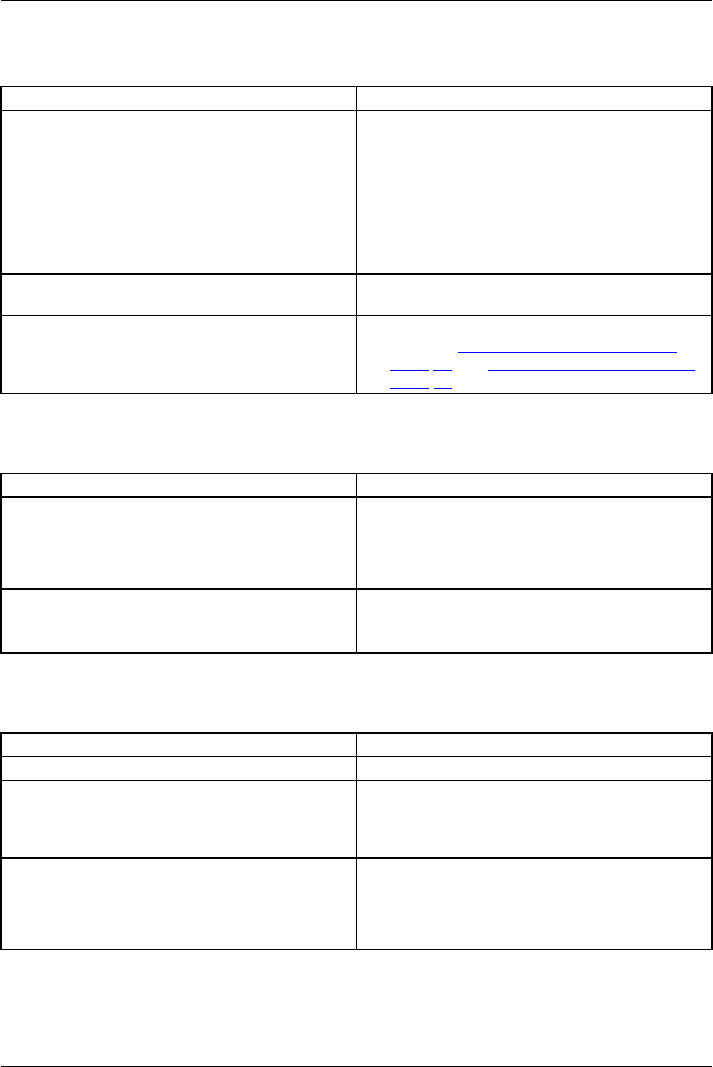
Troubleshooting and tips
Stylus input not working
Cause Troubleshooting
Incorrect driver installed. ►If your device is one which can only be
operated using the stylus, install the driver
for the standard model.
or
►If your device is one which can be
operated using the stylus and by finger,
install the driver for the "Dual Digitizer"
model.
Stylus is in sleep mode. ►Press the upper stylus button to wake the
stylus from sleep mode.
Stylus battery is completely discharged. ►Change the stylus battery as described in
chapters "Removing the stylus battery",
Page 34 and "Installing the stylus battery",
Page 34.
The Tablet PC does not start after switch on
TabletPC
Cause Troubleshooting
The battery is dead. ►Charge the battery.
or
►Connect the AC adapter to the Tablet
PC.
The AC adapter is not connected properly. ►Check whether the AC adapter is properly
connected to the Tablet PC.
►Switch the Tablet PC on.
The Tablet PC stops working
TabletPCEnding
Cause Troubleshooting
The Tablet PC is in energy saving mode. ►End energy saving mode.
An application program has caused the
malfunction.
►Close the application program or restart
the Tablet PC (by restarting the operating
system or switching the device off and back
on again).
The battery is dead. ►Charge the battery.
or
►Connect the AC adapter to the Tablet
PC.
Fujitsu 75

Troubleshooting and tips
The printer does not print
Printerdoesnot print
Cause Troubleshooting
The printer is not switched on. ►Make sure that the printer is switched
on and ready for operation (refer to the
documentation supplied with the printer).
The printer is not connected correctly. ►Check that the data cable between the Tablet
PC and the printer is properly connected.
The printer driver is faulty or not correctly
installed, or it is the wrong printer driver.
►Check that the data cable between the Tablet
PC and the printer is properly connected.
►Check whether the correct printer driver is
loaded (refer to the printer documentation).
The wireless connection to a network does not work
Thewireless connectionto anetwork doesnotwor k
Cause Troubleshooting
The wireless component is switched off. ►Switch the wireless component on (see
"Switching the wireless components on and
off", Page 40).
The wireless component is switched on. Despite
this, the wireless connection to a network does
not work.
►Check whether the wireless connection is
enabled by the software.
►Further information on using the wireless
component can be found in the help files.
The battery discharges too quickly
BatteryCause Troubleshooting
The battery is either too hot or too cold. In this
case the battery indicator flashes.
►Bring the Tablet PC up/down to a normal
operating temperature again.
►If the operating time of the battery life is
extremely short, the battery is probably too
old. Replace the battery if necessary.
You may have an application running that
consumes a great deal of power due to frequent
accessing of the hard disk or optical drive.
►Use the AC adapter whenever possible.
The maximum brightness may have been set
for the screen.
►Reduce the brightness of the screen to
lower energy consumption: You will find the
setting under Control Panel – Hardware and
Sounds – Windows Mobility Center.
76 Fujitsu

Troubleshooting and tips
Acoustic warning
Acous tic wa rnin gsErrorsCause Troubleshooting
A beep sounds every few seconds.
The battery is almost dead.
►Charge the battery.
Fujitsu 77

Troubleshooting and tips
Error messages on the screen
Errormessages onthes creenErrors
This section describes the error messages generated by the BIOS Setup. Error messages displayed
by the operating system or programs are described in the documentation for these programs.
If the error message appears repeatedly despite troubleshooting measures,
contact the place of purchase or our customer service center.
78 Fujitsu

Troubleshooting and tips
Error message/cause Troubleshooting
CMOS battery bad
If the error message occurs repeatedly, the
buffer battery in the Tablet PC is flat.
►Contact your sales outlet or our customer
service center.
System CMOS checksum bad - Default configuration
used
The system configuration information is
incorrect.
►Switch the Tablet PC off.
►Switch the Tablet PC on.
►In the BIOS Setup, select the Exit menu.
►Select the entry Load Setup Defaults.
►Select OK and press the Enter key.
Extended memory failed at offset: xxxx Failing Bits:
zzzz zzzz
When testing the extended memory. an error
has resulted at the address xxxx.
►Contact your sales outlet or our customer
service center.
Failure Fixed Disk n
The settings of the hard disk drive are incorrect.
►Start the BIOS Setup (Primary Master
submenu) and select the correct settings.
Keyboard controller error ►Switch your Tablet PC off with the ON/OFF
button.
►Wait 3 - 5 seconds and switch the Tablet PC
on again.
Keyboard error If you use an external keyboard:
►Check the connection and reboot the Tablet
PC.
nn Stuck key ►Make sure that no key is pressed.
Operating system not found ►Check in the BIOS Setup whether your hard
disk has been set correctly.
►Make sure that the operating system is
installed on the corresponding drive.
Press <F1> to resume, <F2> to SETUP
This error message appears if an error occurs
during the self-test before starting the operating
system.
►Press the volume up button to start the
BIOS Setup.
or
►If you use an external keyboard, press
the F1 or F2 key on the keyboard.
Real time clock error ►Contact your sales outlet or our customer
service center.
nnnnK Shadow RAM failed at offset: xxxx Failing
Bits: zzzz ►Contact your sales outlet or our customer
service center.
System battery is dead - Replace and run SETUP ►Contact your sales outlet or our customer
service center.
System cache error - Cache disabled ►Contact your sales outlet or our customer
service center.
System timer error ►Contact your sales outlet or our customer
service center.
Fujitsu 79

Technical data
Technical data
Tablet PC
General
Processor 7.Generation Intel® CoreTM m processor family
Main memory (SO DIMM) 4 GB / 8 GB DIMM onboard
Electrical data
Safety regulations complied with CE
Protection class II
Maximum power consumption (when the Tablet
PC is switched on, connected to the magnetic
keyboard and the docking cradle, and the
battery is being charged):
65 W
Touch screen
Size 12.5" Full HD Wide View
Screen resolution 1920 x 1080 / 16 million colors
Pixel class II
Brightness control 12 levels
Technology Wide-View High-Bright Display with LED
background lighting
Digitizer and glass panel Dual digitizer with touch screen
Cameras • Front: Full HD
• Rear: 5 megapixel, autofocus
Graphics card
Chip Intel® HD Graphics 520 (CPU integrated)
Maximum resolution of external display: 4096 x 2304
Dimensions
Width x Depth x Height 12.56 x 7.93 x 0.37 inches
319 x 201.3 x 9.5 mm
Weight depending on configuration from 1.71 lbs / 775 g
Input devices
Tablet buttons 3buttons
Stylus (optional) Stylus with two buttons
Slots
Memory card slot 1xmicroSD
Ports
Combined headphones and microphone port 3.5mmstereominijack
Docking port 1 x for magnetic keyboard
1 x for docking cradle
80 Fujitsu

Technical data
Mini Display Port 1 x
USB (Universal Serial Bus) 1 x USB 3.0 (Anytime USB Charge)
Ambient conditions
Environment class DIN IEC 7217K1
Mechanism class DIN IEC 721 7M2
Operating temperature 41 °F .... 95 °F / 5 °C .... 35 °C
Transport temperature (2K2) 5 °F .... 140 °F / –15 °C .... 60 °C
Fujitsu 81

Technical data
WLAN specifications
Type of network Intel® Dual Band Wireless-AC 8265 2x2 ac with
integrated Bluetooth 4.2
Transfer rate (Automatic switching) IEEE802.11 a and g: 54
Mbps max. data rate; IEEE802.11n: 300 Mbps
max. data rate, IEEE802.11ac: 867 Mbps max.
data rate
Active frequency • 802.11n: 2.4 GHz or 5 GHz
• 802.11b/g: 2,400~2,473 MHz
• 802.11a. 4900~5850 MHz
• 802.11ac: 2.4 GHz / 5 GHz
Typical operating distances • 802.11a: 40 ft. (12 m) @ 54 Mbps; 300 ft.
(91m)@6Mbps
• 802.11ac: 40 ft. (12 m) @ 54 Mbps; 300 ft.
(91m)@6Mbps
• 802.11b: 100 ft. (30 m) @ 11 Mbps; 300 ft.
(91m)@1Mbps
• 802.11g: 100 ft. (30 m) @ 54 Mbps; 300 ft.
(91m)@1Mbps
• 802.11n: Estimated double the operating
distance of 802.11g and 802.11a in their
respective frequencies
Number of channels • 802.11a: 8 independent channels
• 802.11b/g: 11 channels, 3 non-overlapping
channels
• 802.11n: Channel bonding takes two of
the non-overlapping 20MHz channels and
combines it into one 40MHz channel. It is
actually 12 non-overlapping channels with
channel bonding and 24 without. Also it is 1
non-overlapping channel in 2.4GHz when
channel bonding is used.
• 802.11ac: 5 independent channels
Security Encryption types: WEP, TKIP, AES, WPA 1.0
and WPA 2.0 compliant
Encryption key, lengths supported: 64 bits and
128 bits
Maximum recommended number of computers
to be connected over wireless LAN (during ad
hoc connection)
10 units or less
82 Fujitsu

Technical data
Screen resolutions for integrated screen
and external screens
Port on
the Tablet
PC Portsonthedockingcradle
Max.
number
of
screens
Number
of
external
screens
Inte-
grated
screen
Mini
Display-
Port HDMI Display
Port VGA
Only
Tablet PC 21 4096x2304
@60Hz ---
-
4096x2160
@24Hz
3840x2160
@30Hz
1920x1080
@60Hz
--
--
4096x2304
@60Hz -
21
---
1920x1200
@60Hz
4096x2304
@60Hz
4096x2160
@24Hz
3840x2160
@30Hz
1920x1080
@60Hz
--
4096x2304
@60Hz -4096x2160
@24Hz -
4096x2304
@60Hz --
1920x1080
@60Hz
-1920x1080
@60Hz 1920x1080
@60Hz -
-1920x1080
@60Hz-1920x1080
@60Hz
Tablet
PC and
docking
cradle
32
1920x1080
@60Hz
--
1920x1080
@60Hz 1920x1080
@60Hz
Fujitsu 83

Technical data
Rechargeable battery
For information on the batteries used in your device, please see
"http://solutions.us.fujitsu.com/www/content/support/contact/index.php".
4-cell lithium ion rechargeable battery 4200
Rated voltage 7.8 V
Rated capacity 34 Wh
AC adapter 65 W for the Tablet PC and
the docking cradle
Technicaldata
Rated voltage 19 Volts
Max. rated current 3.42 A
An additional AC adapter or AC cable can be ordered at any time.
Docking cradle (optional)
Electrical data
Safety regulations complied with CE
Protection class III
Ports
Headphone port 3.5 mm stereo mini jack
Microphone port 3.5 mm stereominijack
Docking port 50-pin
Display Port 1x
HDMI port1x
VGA monitor port 1x
USB (Universal Serial Bus) 2 x USB 3.0
LAN port 1 x
Security Lock device 1x
Ambient conditions
Environment class DIN IEC 721 7K1
Mechanism class DIN IEC 721 7M2
Operating temperature 41 °F .... 95 °F / 5 °C .... 35 °C
Temperature in transit 5 °F .... 140 °F / –15 °C .... 60 °C
84 Fujitsu

Technical data
Magnetic keyboard (optional)
Electrical data
Safety regulations complied with CE
Protection class III
Ports
Docking port 6-pin
Ambient conditions
Environment class DIN IEC 721 7K1
Mechanism class DIN IEC 721 7M2
Operating temperature 41 °F .... 95 °F / 5 °C .... 35 °C
Temperature in transit 5 °F .... 140 °F / –15 °C .... 60 °C
Fujitsu 85

Manufacturer’s notes
Manufacturer’s notes
Disposal and recycling
Notes
You can find information on this subject on your notebook or on our website
("http://solutions.us.fujitsu.com/www/content/products/trade-in_program/").
Recycling your battery
Over time, the batteries that run your mobile computer will begin to hold a charge for a
shorter amount of time; this is a natural occurrence for all batteries. When this occurs,
you may want to replace the battery with a fresh one*. If you replace it, it is important
that you dispose of the old battery properly because batteries contain materials that
could cause environmental damage if disposed of improperly.
Fujitsu is very concerned with environmental protection, and has enlisted the services of the
Rechargeable Battery Recycling Corporation (RBRC)**, a nonprofit public service organization
dedicated to protecting our environment by recycling old batteries at no cost to you.
RBRC has drop-off points at tens of thousands of locations throughout the United States and
Canada. To find the location nearest you, go to "www.RBRC.org" or call 1-800-822-8837.
If there are no convenient RBRC locations near you, you can also go to the EIA Consumer
Education Initiative website "http://EIAE.org/ " and search for a convenient disposal location.
Remember – protecting the environment is a cooperative effort, and we must
make every effort to protect it for current and future generations.
* To order a new battery for your Fujitsu mobile computer, go to the Fujitsu shopping site
at "www.shopfujitsu.com" in the US or "www.fujitsu.ca/products/notebooks" in Canada.
** RBRC is an independent third party to which Fujitsu provides funding for
battery recycling; RBRC is in no way affiliated with Fujitsu.
DOC (Industry CANADA) Notices
DOC(INDUSTRYCANADA)NOTICES
Radios and Television
This Class B digital apparatus meets all requirements of Canadian Interference-Causing Equipment
Regulations.
CET appareil numérique de la class B respecte toutes les exigence du Réglement
sur le matérial brouilleur du Canada.
86 Fujitsu
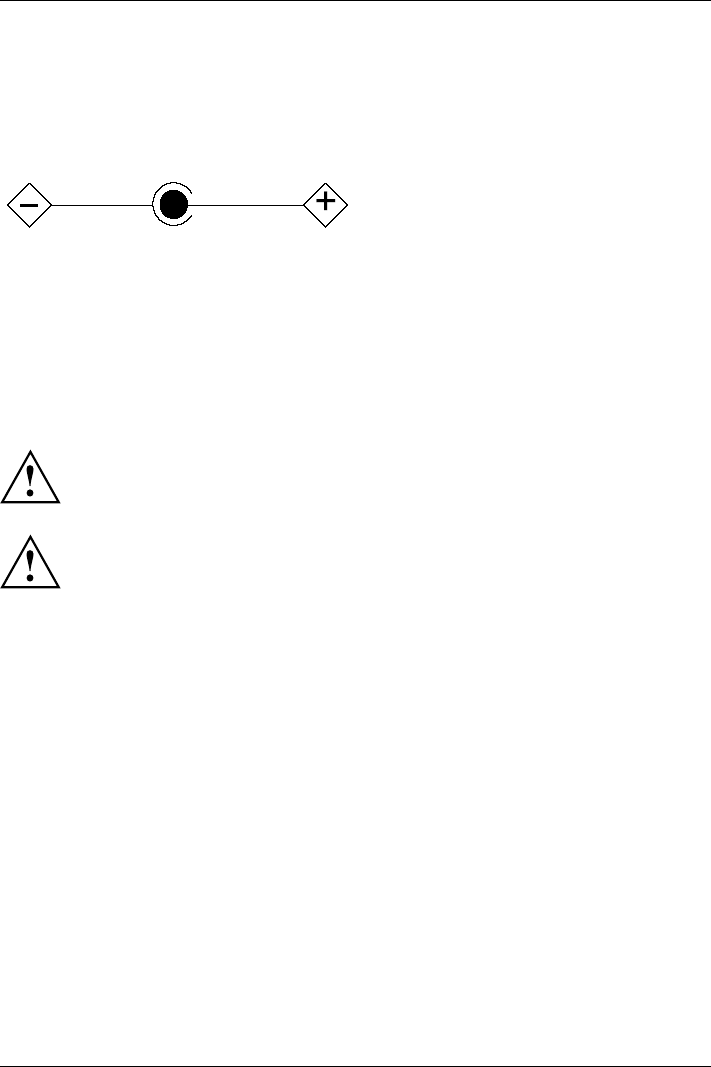
Manufacturer’s notes
UL Notice
IMPORTANT SAFETY INSTRUCTIONS
This unit requires an AC adapter to operate. Only use UL Listed I.T.E. adapters with an output rating
of 19 VDC, with a minimum current of 3.42 A (65 W). The correct output rating is indicated on the
AC adapter label. Refer to the illustration below for the correct AC Adapter output polarity:
When using your tablet PC equipment, basic safety precautions should always be followed to
reduce the risk of fire, electric shock and injury to persons, including the following:
• Do not use this product near water, for example near a bathtub, washbowl, kitchen
sink or laundry tub, in a wet basement or near a swimming pool.
• Use only the power cord and batteries indicated in this manual. Do not dispose of batteries in a
fire. They may explode. Check with local codes for possible special disposal instructions.
SAVE THESE INSTRUCTIONS
For Authorized Repair Technicians Only
CAUTION:
For continued protection against risk of fire, replace only with the
same type and rating fuse.
WARNING:
Danger of explosion if Lithium (CMOS) battery is incorrectly replaced. Replace only
with the same or equivalent type recommended by the manufacturer.
Dispose of used batteries according to the manufacturer’s instruction.
Fujitsu 87

Manufacturer’s notes
ENERGY STAR Compliance
Your Fujitsu system is an ENERGY STAR qualified mobile PC. By
choosing a computer with the latest energy-saving technology, you’re
helping to preserve our environment for future generations. ENERGY
STAR is a joint program of the U.S. Environmental Protection Agency,
U.S. Department of Energy, Natural Resources Canada, and other
governments around the world helping us save money while protecting
the environment through energy efficient products and practices. With
energy costs and global warming top-of-mind for consumers, Fujitsu is
committed to offering solutions that help consumers conserve energy
and improve the quality of our environment.
Sleep mode:
You will notice that your computer is initially set so that the display turns off after 10 minutes of
user inactivity, and the computer goes into Sleep mode after 20 minutes of user inactivity. When
going into Sleep mode, the computer also reduces the speed of any active Ethernet network
links. To “wake” the computer from Sleep mode, press the Suspend/Resume Button.
Energy saving benefits:
Fujitsu ENERGY STAR qualified mobile PCs use about half as much electricity as standard
equipment – saving half in utility costs. But more than that, ENERGY STAR also makes a difference
for the environment. Did you know that the average house can be responsible for twice the
greenhouse gas emissions as the average car? That’s because every time you flip on a light
switch, run your dishwasher, or turn on your PC, you use energy, which means more greenhouse
gas emissions from power plants. So the more energy we can save through energy efficiency,
the more we help to reduce greenhouse gases and the risks of global warming.
To learn more about the important ENERGY STAR program, visit:"www.energystar.gov".
To read about how Fujitsu is supporting Sustainable Management along with
several other environmental activities, visit the Fujitsu Corporate Citizenship page at:
"http://www.computers.us.fujitsu.com/www/content/aboutus/environmental/environment.php".
88 Fujitsu

Declarations of conformity
Declarations of conformity
Declarationsof conformity
This device complies with Part 15 of the FCC Rules. Operations are subject to the following two
conditions: (1) This device may not cause harmful interference, (2) this device must accept any
interference received, including interference that may cause undesired operation.
Fujitsu 89

FCC Regulatory Information
FCC Regulatory Information
Please note the following regulatory information related to the wireless LAN
device.
You are cautioned that changes or modifications not expressly approved by the
part responsible for compliance could void the user’s authority to operate the
equipment.FCC RF Radiation Exposure Statement:
1. This Transmitter must not be co-located or operating in conjunction with any
other antenna or transmitter.
2. This equipment complies with FCC RF radiation exposure limits set forth for
an uncontrolled environment.
This equipment should be installed and operated with a minimum distance of 20
centimeters between the radiator and your body. For body worn operation, this
tablet has been tested and meets FCC RF exposure guidelines when used with
an accessory that contains no metal and that positions the handset a minimum of
0 mm from the body.
Use of other accessories may not ensure compliance with FCC RF exposure
guidelines. This device complies with Part 15 of the FCC Rules. Operation is
subject to the following two conditions:
1. this device may not cause harmful interference and
2. this device must accept any interference received, including interference that
may cause undesired operation of the device.
The highest FCC SAR values: 1.163 W/Kg (Body)
Regulatory Notes and Statements
Wireless LAN, Health and Authorization for use
Radio frequency electromagnetic energy is emitted from Wireless LAN devices. The energy levels of
these emissions, however, are far much less than the electromagnetic energy emissions from wireless
devices such as mobile phones. Wireless LAN devices are safe for use by consumers because they
operate within the guidelines found in radio frequency safety standards and recommendations. The
use of Wireless LAN devices may be restricted in some situations or environments, such as:
• On board an airplane, or
• In an explosive environment, or
• In situations where the interference risk to other devices or services is
perceived or identified as harmful.
In cases in which the policy regarding use of Wireless LAN devices in specific environments is
not clear (e.g., airports, hospitals, chemical/oil/gas industrial plants, private buildings), obtain
authorization to use these devices prior to operating the equipment.
90 Fujitsu

FCC Regulatory Information
Regulatory Information/Disclaimers
Installation and use of this Wireless LAN device must be in strict accordance with the instructions
included in the user documentation provided with the product. Any changes or modifications made
to this device that are not expressly approved by the manufacturer may void the user’s authority to
operate the equipment. The manufacturer is not responsible for any radio or television interference
caused by unauthorized modification of this device, or the substitution or attachment of connecting
cables and equipment other than those specified by the manufacturer. It is the responsibility of the
user to correct any interference caused by such unauthorized modification, substitution or attachment.
The manufacturer and its authorized resellers or distributors will assume no liability for any damage
or violation of government regulations arising from failure to comply with these guidelines.
This device must not be co-located or operated in conjunction with any other antenna or transmitter.
For IEEE 802.11a Wireless LAN: For operation within 5.15~5.25 GHz frequency range, it is
restricted to indoor environments, and the antenna of this device must be integral.
Federal Communications Commission and Industry
Canada statement:
This device complies with Part 15 of FCC Rules.
Operation is subject to the following two conditions: (1) This device may not cause
interference, and, (2) This device must accept any interference, including interference
that may cause undesired operation of this device.
FCC Interference Statement
This equipment has been tested and found to comply with the limits for a Class B digital
device, pursuant to Part 15 of the FCC Rules. These limits are designed to provide reasonable
protection against harmful interference in a residential installation. This equipment generates,
uses, and can radiate radio frequency energy. If not installed and used in accordance with
the instructions, it may cause harmful interference to radio communications. However, there
is no guarantee that interference will not occur in a particular installation.
If this equipment does cause harmful interference to radio or television reception, which
can be determined by turning the equipment off and on, the user is encouraged to try and
correct the interference by one or more of the following measures:
1. Reorient or relocate the receiving antenna.
2. Increase the distance between the equipment and the receiver.
3. Connect the equipment to an outlet on a circuit different from the one the receiver is connected to.
4. Consult the dealer or an experienced radio/TV technician for help.
Fujitsu 91

FCC Regulatory Information
FCC Radio Frequency Exposure statement
The available scientific evidence does not show that any health problems are associated with
using low power wireless devices. There is no proof, however, that these low power wireless
devices are absolutely safe. Low power wireless devices emit low levels of radio frequency
energy (RF) in the microwave range while being used. Whereas high levels of RF can produce
health effects (by heating tissue), exposure to low-level RF that does not produce heating
effects causes no known adverse health effects. Many studies of low-level RF exposure have
not found any biological effects. Some studies have suggested that some biological effects
might occur, but such findings have not been confirmed by additional research.
The wireless LAN radio device has been tested and found to comply with FCC radiation
exposure limits set forth for an uncontrolled equipment and meets the FCC radio frequency
(RF) Exposure Guidelines in Supplement C to OET65.
The exposure standard for wireless devices employs a unit of measurement known as the
Specific Absorption Rate, or SAR. The SAR limit set by the FCC is 1.6W/kg.
This device is compliant with SAR for general population /uncontrolled exposure limits in ANSI/IEEE
C95.1-1992, and had been tested in accordance with the measurement methods and procedures
specified in OET Bulletin 65 Supplement C. This device has been tested, and meets the FCC,
IC RF exposure guidelines when tested with the device operating conditions.
Export restrictions
This product or software contains encryption code which may not be exported or transferred
from the US or Canada without an approved US Department of Commerce export license.
This device complies with Part 15 of FCC Rules, as well as ICES 003 B / NMB 003 B.
Operation is subject to the following two conditions: (1) this device may not cause harmful
interference, and (2) this device must accept any interference received, including interference
that may cause undesirable operation. Modifications not expressly authorized by Fujitsu
America, Inc. may invalidate the user’s right to operate this equipment.
The highest FCC SAR value is 1.163 W/Kg (Body SAR).
Restrictions concernant l’exportation
Ce produit ou logiciel contient du code de chiffrement qui ne peut être exporté ou transféré du
Canada ou des États-Unis sans un permis d’exportation du département du commerce des
États-Unis. Ce matériel est conforme à la Partie 15 des règlements de la FCC, ainsi qu’à la
norme ICES 003 B/NMB 003 B. Son fonctionnement est soumis aux deux conditions suivantes
: (1) cet appareil ne doit pas causer d’interférence nuisible; (2) cet appareil doit accepter
toutes les interférences reçues, y compris celles pouvant causer un mauvais fonctionnement
de l’appareil. Toute modification n’ayant pas été expressément approuvée par la société Fujitsu
America Incorporated peut annuler le droit de l’utilisateur de se servir du matériel.
La valeur FCC SAR la plus élevée est de 1,163 W / Kg (SAR Body).
92 Fujitsu

Canada, Industry Canada (IC)
Canada, Industry Canada (IC)
This Class B digital apparatus complies with Canadian ICES-003 and RSS-247. This device
complies with Industry Canada licence-exempt RSS standard(s).
Operation is subject to the following two conditions:
1. This device may not cause interference, and
2. This device must accept any interference, including interference that may
cause undesired operation of the device.
IC RF Radiation Exposure Statement:
For body worn operation, this device has been tested and meets RF exposure guidelines when used
with an accessory that contains no metal and that positions the device a minimum of 0 mm from the
body. Use of other accessories may not ensure compliance with RF exposure guidelines.
Cet appareil numérique de classe B est conforme à la norme NMB-003 et
RSS-247. Le présent appareil est conforme aux CNR d’Industrie Canada applicables
aux appareils radio exempts de licence.
L’exploitation est autorisée aux deux conditions suivantes:
1. l’appareil ne doit pas produire de brouillage, et
2. l’utilisateur de l’appareil doit accepter tout brouillage radioélectrique subi, même si le
brouillage est susceptible d’en compromettre le fonctionnement.
Déclaration de l’exposition aux radiations RF:
Pour le fonctionnement du corps, ce téléphone a été testé et répond aux directives
d’exposition RF lorsqu’il est utilisé avec un accessoire qui ne contient pas de métal et
qui place le combiné d’un minimum de 0 mm du corps. Utilisation d’autres accessoires
peut ne pas assurer le respect des directives d’exposition RF.
Canadian Notice
The device for the 5150 - 5250 MHz band is only for indoor usage to reduce the potential
for harmful interference to co-channel mobile satellite systems.
The maximum antenna gain of 6 dBi permitted (for devices in the 5250 - 5350 MHz, 5470 - 5725
MHz and 5725 - 5825 MHz bands) to comply with the e.i.r.p. limit as stated in RSS-247.
In addition, users are cautioned to take note that high power radars are allocated as primary
users (meaning they have priority) of 5250 - 5350 MHz and 5650 - 5850 MHz and these
radars could cause interference and/or damage to LE-LAN devices.
Fujitsu 93

Canada, Industry Canada (IC)
Avis pour le Canada
Le matériel destiné à un usage sur la bande 5 150 - 5 250 MHz doit être utilisé
uniquement à l’intérieur afin de réduire les risques de brouillage nuisible causé aux
systèmes mobiles par satellite fonctionnant sur un même canal.
Un gain d’antenne de 6 dBi est autorisé (pour le matériel utilisant les bandes 5 250 - 5 350
MHz, 5 470 - 5 725 MHz et 5 725 - 5 825 MHz), conformément à la limite p.i.r.e. maximale
permise selon l’annexe A9.2 afférent aux périphériques RSS-247.
En outre, les utilisateurs doivent prendre garde au fait que les radars de grande puissance
sont considérés comme des utilisateurs principaux (ce qui signifie qu’ils sont prioritaires) des
bandes 5 250 - 5 350 MHz et 5 650 - 5 850 MHz et qu’ils pourraient causer des interférences
et/ou des dommages aux appareils de réseau exempts de licence.
94 Fujitsu

Appendix
Appendix
Before Using the Optional Wireless LAN
This manual describes the procedures required to properly set up and configure the optional
integrated Wireless LAN Mini-PCI device (referred to as "WLAN device" in the rest of the
manual). Before using the WLAN device, read this manual carefully to ensure its correct
operation. Keep this manual in a safe place for future reference.
Wireless LAN Devices Covered by this Document
This document is applicable to systems containing the following device:
•Intel® Dual Band Wireless-AC 8265 2x2 ac with integrated Bluetooth 4.0
Characteristics of the WLAN Device
• The WLAN devices are PCI Express Mini cards attached to the main board of the mobile computer.
• The WLAN devices operate in license-free RF bands, eliminating the need to procure
an FCC operating license. The WLAN operates in the 2.4GHz Industrial, Scientific,
and Medical (ISM) RF band and the lower, middle, and upper bands of the 5GHz
Unlicensed National Information Infrastructure (UNII) bands.
• The WLAN devices are capable of five operating modes, IEEE802.11a, IEEE802.11ac,
IEEE802.11b, IEEE802.11g, and IEEE802.11n.
• The WLAN device is Wi-Fi certified and operates (as applicable) at a the maximum
data rate of 450 Mbps in IEEE802.11n mode (300 Mbps in this configuration); 54 Mbps
in IEEE802.11g mode; and 11 Mbps in IEEE802.11b mode.
• The WLAN devices support the following encryption methods - WEP,
TKIP, CKIP, and AES encryption.
• The Wireless LAN devices are compliant with the following standards: WPA,
WPA2, CCX1.0, CCX2.0, CCX3.0, and CCX4.0.
Fujitsu 95
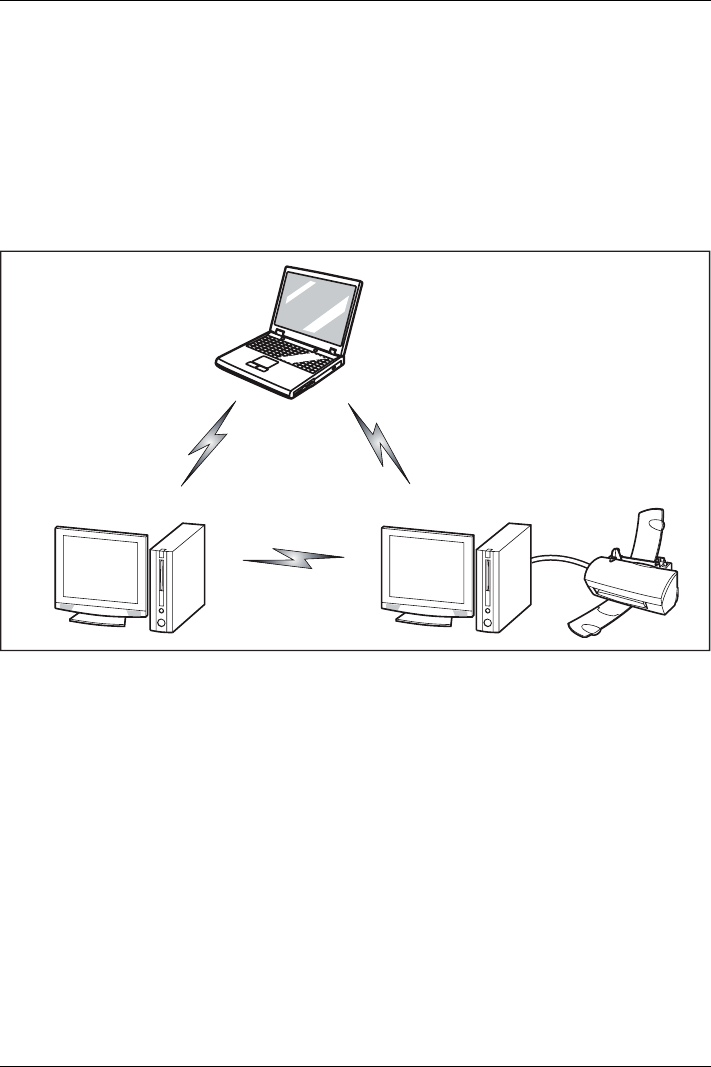
Appendix
Wireless LAN Modes Using this Device
Ad Hoc Mode
"Ad Hoc Mode" refers to a wireless network architecture where wireless network connectivity
between multiple computers is established without a central wireless network device, typically
known as Access Point(s). Connectivity is accomplished using only client devices in a peer-to-peer
fashion. That is why Ad Hoc networks are also known as peer-to-peer networks. Ad Hoc
networks are an easy and inexpensive method for establishing network connectivity between
multiple computers. Ad Hoc mode requires that the SSID, network authentication, and encryption
key settings are identically configured on all computers in the Ad Hoc network.
96 Fujitsu
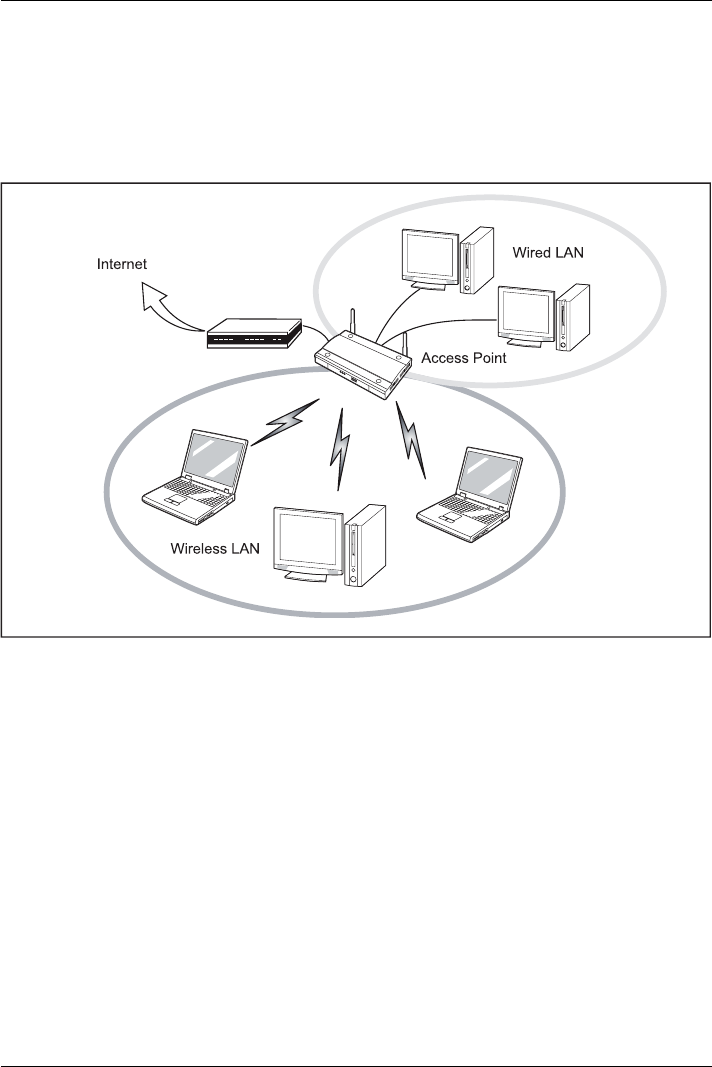
Appendix
Access Point (Infrastructure) Mode
Infrastructure mode refers to a wireless network architecture in which devices communicate with
wireless or wired network devices by communicating through an Access Point. In infrastructure
mode, wireless devices can communicate with each other or with a wired network. Corporate
wireless networks operate in infrastructure mode because they require access to the WLAN in
order to access services, devices, and computers (e.g., file servers, printers, databases).
**
*
* = An optional hub for a wired LAN may
be required depending upon the type
of access point used.
** = ADSL modem, cable modem, or similar
Fujitsu 97

Appendix
How to Handle This Device
The WLAN device is an optional device that may come pre-installed in your mobile computer. Under
normal circumstances, it should not be necessary for you to remove or re-install it. The Operating
System that your mobile computer comes with has been pre-configured to support the WLAN device.
• Integrated Intel Centrino wireless LAN devices support IEEE802.11a, IEEE802.11b,
IEEE802.11ac, IEEE802.11g, and IEEE802.11n.
• The WLAN device operates in the 2.4 GHz ISM band and the 5 GHz
lower, middle, and upper UNII bands.
• Microwave ovens may interfere with the operation of WLAN devices since they operate in the
same 2.4 GHz frequency range as IEEE802.11b/g/n devices. Interference by microwaves
does not occur with IEEE802.11a radio which operates in the 5 GHz RF band.
• Wireless devices that transmit in the 2.4 GHz range may interfere with operation of WLAN
devices in IEEE802.11b/g/n modes. Symptoms of interference include reduced throughput,
intermittent disconnects, and many frame errors. It is HIGHLY recommended that these
interfering devices be powered off to ensure proper operation of the WLAN device.
Deactivating/Disconnecting the WLAN Device
Disconnecting the WLAN device may be desired in certain circumstances (to extend battery
life) or where certain environments require it (i.e. hospitals, clinics, airplanes, etc.). The
WLAN device can be disconnected in Windows using the WLAN icon in the system tray
(Note that disconnecting via the icon in the system tray does not turn off the radio; it
continues to transmit and receive even though it’s not connected.)
The radio components are switched on and off using the appropriate functions of the operating system.
►To switch radio components on and off individually, select Settings – Change
PC settings – Wireless – Wireless devices – Off.
Configuring the Wireless LAN
The optional WLAN device can be configured to establish wireless network connectivity
using the software that is built into Windows. Support for most industry standard
security solutions is contained in this software.
Pre-defined parameters will be required for this procedure. Please consult with
your network administrator for these parameters:
Connection to the network
After you have configured your computer, you can connect to an active network
by performing the following steps:
1. Click on the WLAN icon in the system tray.
2. Select Connect to a network.
3. Select a network from the list that appears, and click the Connect button.
98 Fujitsu

Appendix
Troubleshooting the WLAN
Causes and countermeasures for troubles you may encounter while using your
wireless LAN are described in the following table.
Problem Possible Cause Possible Solution
Incorrect network name (SSID)
or network key Ad hoc connection: verify that
the network names (SSID’s)
and network keys (WEP) of
all computers to be connected
have been configured correctly.
SSID’s and WEP key values
must be identical on each
machine.
Access Point (Infrastructure)
connection: set the network
name (SSID) and network key
to the same values as those of
the access point.
Set the Network Authentication
value identically to that of the
Access Point. Please consult
your network administrator for
this value, if necessary.
Unavailable network connection
Weak received signal strength
and/or link quality Ad hoc connection: Retry
connection after shortening
the distance to the destination
computer or removing any
obstacles for better sight.
Access Point (Infrastructure)
connection: Retry connection
after shortening the distance to
the access point or removing
any obstacles for better sight.
Fujitsu 99

Appendix
Problem Possible Cause Possible Solution
The WLAN device was
deactivated or is disabled Check if the wireless switch
is turned On. Go to Start >
Control Panel, and doubleclick
on Windows Mobility Center.If
the wireless network is off, click
the Turn wireless on button.
The computer to be connected
is turned off Check if the computer to be
connected is turned ON.
Incorrectly configured network
settings Recheck the configuration of
your network settings.
RF interference from Access
Points or other wireless
networks
The use of identical or
overlapping RF channelscan
cause interference with the
operation of the WLAN device.
Change the channel of your
Access Point to a channel
that does not overlap with the
interfering device.
Wireless network authentication
has failed Re-check your Network
Authentication, Encryption,
and Security settings.
Incorrectly configured
security settings such as
an incorrectly typed WEP
key, a mis-configured LEAP
username, or anincorrectly
chosen authentication method
will cause theLANdeviceto
associate but not authenticate
to the wireless network.
Unavailable network connection
(continued)
Incorrect IP address
configuration This only applies to networks
using static IP addresses.
Please contact your network
administrator for the correct
settings.
100 Fujitsu

Appendix
Image Backup and Recovery Procedures
It is very important that you create your Recovery Drive before beginning to use your system.
It is also important that you create a backup of the content of the C:\Drivers folder on
your system to writable media or an external drive. System-specificsoftwaredrivers
are also available for download through the Fujitsu support site.
Note: Most of the information below comes from the Microsoft® page
"http://windows.microsoft.com/en-us/windows-10/windows-10-recovery-options" .
Please refer to it for more details.
Creating a recovery drive
A recovery drive can help you troubleshoot and fix problems with your PC, even if it
won’t start. To create one, all you need is a USB flash drive. Windows will inform you
ofthesizetheUSBflash drive needed to hold the required data.
1. From the taskbar, search for Create a recovery drive and then select it. You may be
asked to enter an administrator password or confirm your selection.
2. When the tool opens, make sure Backup system files to the recovery drive
is selected and then select Next.
3. Connect a USB drive to your PC, select it, and then select Next - Create. A large number of
files need to be copied to the recovery drive, so this could take some time.
4. When it’s done, select Finish.
Note:
If you chose not to back up the system files when you created your recovery drive on
Windows 10, you won’t be able to use it to reinstall Windows.
Recovery options in Windows 10
If your PC isn’t running as quickly or reliably as it used to, try one of these recovery
options. The following table can help you decide which one to use.
Problem Try this
Your PC isn’t working well and you recently
installed an app, driver, or update. Restore from a system restore point
Your PC isn’t working well and it’s been a while
since you installed anything new. Reset your PC
Your PC won’t start and you’ve created a
recovery drive. Use a recovery drive to reinstall Windows
Your PC won’t start and you haven’t created a
recovery drive. Use installation media to reinstall Windows
Restore from a system restore point
This option takes your PC back to an earlier point in time, called a system restore point. Restore
points are generated when you install a new app, driver, or Windows update, and when you
create a restore point manually. Restoring won’t affect your personal files, but it will remove
apps, drivers, and updates installed after the restore point was made.
Fujitsu 101

Appendix
1. Right-click (or press and hold) the Start button, and then select Control Panel.
2. Search Control Panel for Recovery.
3. Select Recovery - Open System Restore - Next.
4. Choose the restore point related to the problematic app, driver, or update,
and then select Next - Finish.
Note: If you don’t see any restore points, it could be because the system protection isn’t turned
on. To check, go to the Control Panel,searchforRecovery, and then select Recovery - Configure
System Restore - Configure and make sure that Turn On System Protection is selected.
Reset your PC
Option What it does
Keep my files This reinstalls Windows 10, but keeps your personal files and any
apps that came with your PC. It removes:
• Changes you made to settings
• Apps and drivers you installed
Remove everything This reinstalls Windows 10 and any apps that came with your PC.
It removes:
• Personal files
• Changes you made to settings
• Apps and drivers you installed
If you’re planning to donate, recycle, or sell your PC, use this option
and choose to fully clean the drive. This might take an hour or
two, but it makes it harder for other people to recover files you’ve
removed.
Use a recovery drive to reinstall Windows
Note: This process utilizes the USB Recovery Drive that you created in the
previous section "Create a Recovery Drive".
1. Connect the recovery drive and turn on your PC.
2. On the Choose an option screen, select Troubleshoot - Reset this PC, and then
choose the reset option that’s best for you.
If that doesn’t fix the problem, try Troubleshoot - Recover from a drive. This will remove your personal
files, apps and drivers you installed, and changes you made to settings. If you repartitioned the
drive Windows is installed on, note that this will restore the drive’s default partitions.
Use installation media to reinstall Windows
If you have installation media, like a Recovery DVD that you purchased from
Fujitsu, you can use it to reinstall Windows. You will need to install additional
drivers and applications after reinstalling Windows.
To reinstall Windows, follow the steps below:
1. Power on your system. When the Fujitsu logo appears on the screen, press the F12 key.
2. Insert the bootable disc in your DVD drive.
3. Highlight the CD/DVD option from the Boot Menu and press Enter .
102 Fujitsu

Appendix
4. Follow the on-screen instructions to restore the image.
• Select the language.
• At the Windows Setup dialog window, enter your OS, language and other
preferences and click Next to continue.
• Click Install now to proceed with reinstalling Windows.
• At License terms, check on I accept the license terms and click Next.
•AtWhich type of installation do you want, click on Custom: Install Windows only (advanced).
• Delete all partitions on the drive and click Next. Installation of Windows will start. This will
take some time so please wait until the installation is finished and the system restarts.
5. When the system restarts, perform all set-up steps to arrive at the Desktop.
6. Connect to the Internet.
7. Use the Backup of the contents of the C:\Drivers folder to install needed drivers and
applications to your system. If it is not available, download the software from the
Fujitsu Support Site, as described below in the "Auto Installation support for the
software downloaded from support website" section below.
Installation of essential access software
1. Insert the bootable disc in your DVD drive.
2. Open the Drivers folder in the disc, and follow the steps in readme.txt. If there is not a Drivers
folder in the bootable disc, the computer does not need the essential access software.
The recovery image already has the essential access software installed.
3. You can now connect to the internet and download FSDM (Fujitsu Software Download
Manager) from the support site and download all the software applicable to the
model and OS using FSDM if they are not downloaded yet.
Auto Installation support for the software downloaded from support website
1. Download FSDM (Fujitsu Software Download Manager) from the support site and download all
the drivers applicable to the model and OS using FSDM if they are not downloaded yet.
2. When the software packages are downloaded from the web, it is important to
download the Auto Installer Software package and the model/language-specific
Readme file if you prefer to auto install the software.
3. It is important to have the extracted Auto Installer software package folder and
Readme file in the same location as the other software folders. Otherwise
auto-installation of the software will not be supported.
4. Inside the Auto Installer software package, launch FjAutoinstall.exe as administrator.
5. Click Yes on the User Account Control dialog box. This will take some time to
process the software packages. A message will be displayed during this time
stating Please wait while the content is being processed.
6. If the EULA is displayed for Fujitsu Software Auto Installer, accept the EULA, otherwise continue.
7. The Fujitsu Software Auto Installer user interface will be launched providing the ability
to auto install the software downloaded from the support site.
8. It is recommended that you install all the software in the listed order. You can
Select All, to install the software in the order listed.
9. Click the Install button to start the installation.
10. After installing all the selected drivers, the Installation Results window is displayed. Click OK.
Fujitsu 103

Appendix
11. You must restart the system for the settings to take effect. Do you wish to reboot
now? message appears. Select Yes.
12. The system will now reboot.
Downloading driver updates
To ensure that you always have the most current driver updates related to your system,
you should occasionally access the Fujitsu Software Download Manager (FSDM) utility.
The FSDM utility is available from the Fujitsu Support site. FSDM will allow you to view
and download the most current drivers, utilities and applications to determine whether
you have the latest versions. To download the FSDM utility, go to the support site:
"http://support.fujitsupc.com/CS/Portal/support.do?srch=DOWNLOADS".
104 Fujitsu

Index
Index
A
AC adapter
connecting 21
Set up 19
Acoustic warnings 77
Anti-theft protection 57
Audio connections 67
B
Battery 37
battery charge 38
Caring for and maintaining 37
charge level 37
Charging 37
Discharges too quickly 76
see Rechargeable battery 37
Service life 37
battery charge meter 37
before you travel 15
BIOS Setup Utility
, protecting with password 58
calling 68
exiting 70
operation 69
Settings 68
Bluetooth, Safety notes 14
Bonus Apps 23
C
Camera 37
Charging back-up battery 72
Choose a location 19
Configuration, BIOS Setup Utility 68
Configuring hardware 68
Configuring system 68
Connecting audio devices 67
Connecting headphones 67
Connecting microphone 67
Cradle 44
Connecting a Tablet PC 46, 52
D
dark touchscreen 73
Date not correct 72
Declarations of conformity 89
Display orientation
select 28
Display Port 62–63
DOC (INDUSTRY CANADA) NOTICES 86
E
Ending
energy saving mode 75
Energy
Energy consumption 38
Energy saving 14
Energy saving functions 38
Error messages on the screen 78
Errors
Acoustic warnings 77
Screen messages 78
Ethernet LAN 41
F
Fault
Elimination 71
First-time setup 18
G
Getting started 18
GPS 42
H
HDMI port 63
I
Important notes 13
Incorrect time 72
Information,
safety 13
L
Landscape format
display 28
M
Magnetic keyboard
Connecting a Tablet PC 49
ports 48
Making ready to use 21
Memory card
handling 39
inserting 39
removing 40
Mobile operation 15
Fujitsu 105

Index
Monitor
connection 64
no image 74
remains blank 74
unstable image 74
Monitor connection
see VGA port 64
N
Notes 13
disposal / recycling 86
Energy saving 14
touchscreen 27
Transport 15
O
Operating system
activating system protection 59
cancel system protection 59
Protecting with password 59
P
Packaging 18
Password
changing 58
entering 58
removing 59
Password protection 57
hard disk 60
Pen 32
Portrait format
display 28
Ports 44
magnetic keyboard 48
Power saving 14
Power-on Power-on indicator 25
Printer does not print 76
Problem solving 71
R
Rechargeable battery
see battery 37
S
Safety information 13
Screen connection
see VGA port 64
Security functions 57
Security Lock
Anti-theft protection 57
using 57
Service life, battery 37
Set up
Device 19
Setup
see BIOS Setup Utility 68
SlotMemory cards 39
Status indicators 24
Summer time 72
Supervisor password
change 58
entering 58
removing 59
Suspend/Resume button 25
Switching off the
Tablet PC 26
Switchingonforthefirst time 22
Symbols
Indicators 24
System settings, BIOS Setup Utility 68
T
Tablet
operating 24
Tablet PC
cannot be started 75
doesn’t work 75
transporting 15
Tablet, operation 24
Tablet: Switching on 25
Technical data
AC adapter 84
The wireless connection to a network
does not work 76
Time not correct 72
Tips 71
Touchscreen
difficult to read 73
notes 27
reflected glare 73
remains dark 73
TPM 61
Transport
Damage during transportation 18
Transportation 15
Travel 15
Troubleshooting 71
Trusted Platform Module 61
U
USB charging function 66
USB ports 65
106 Fujitsu
